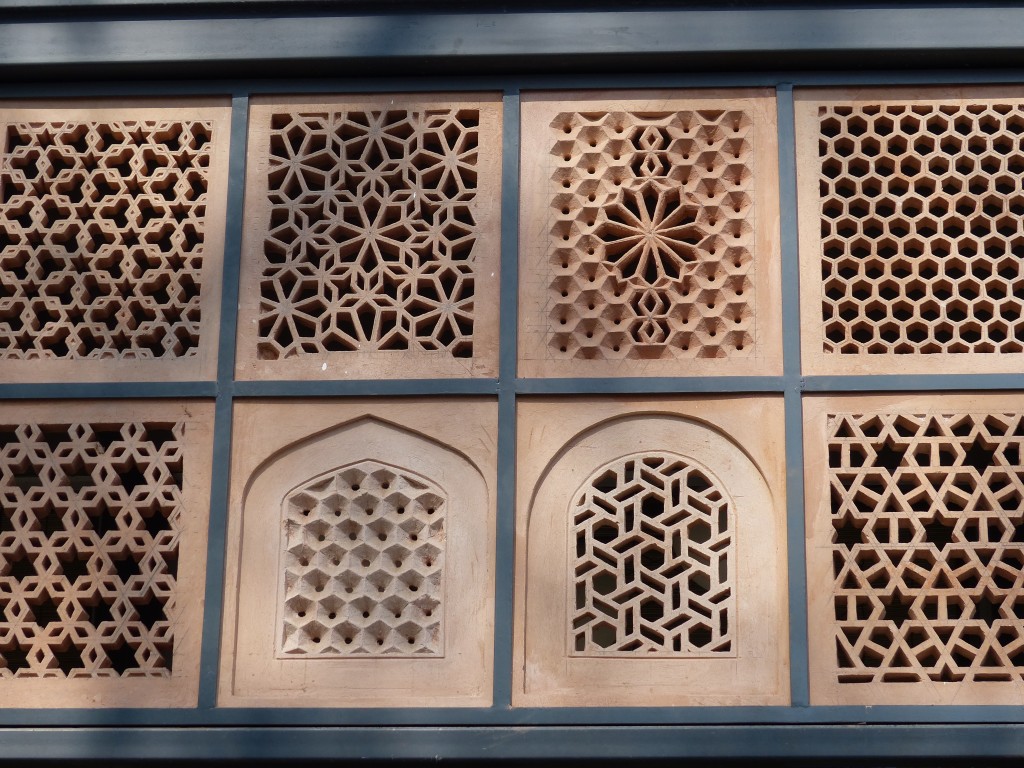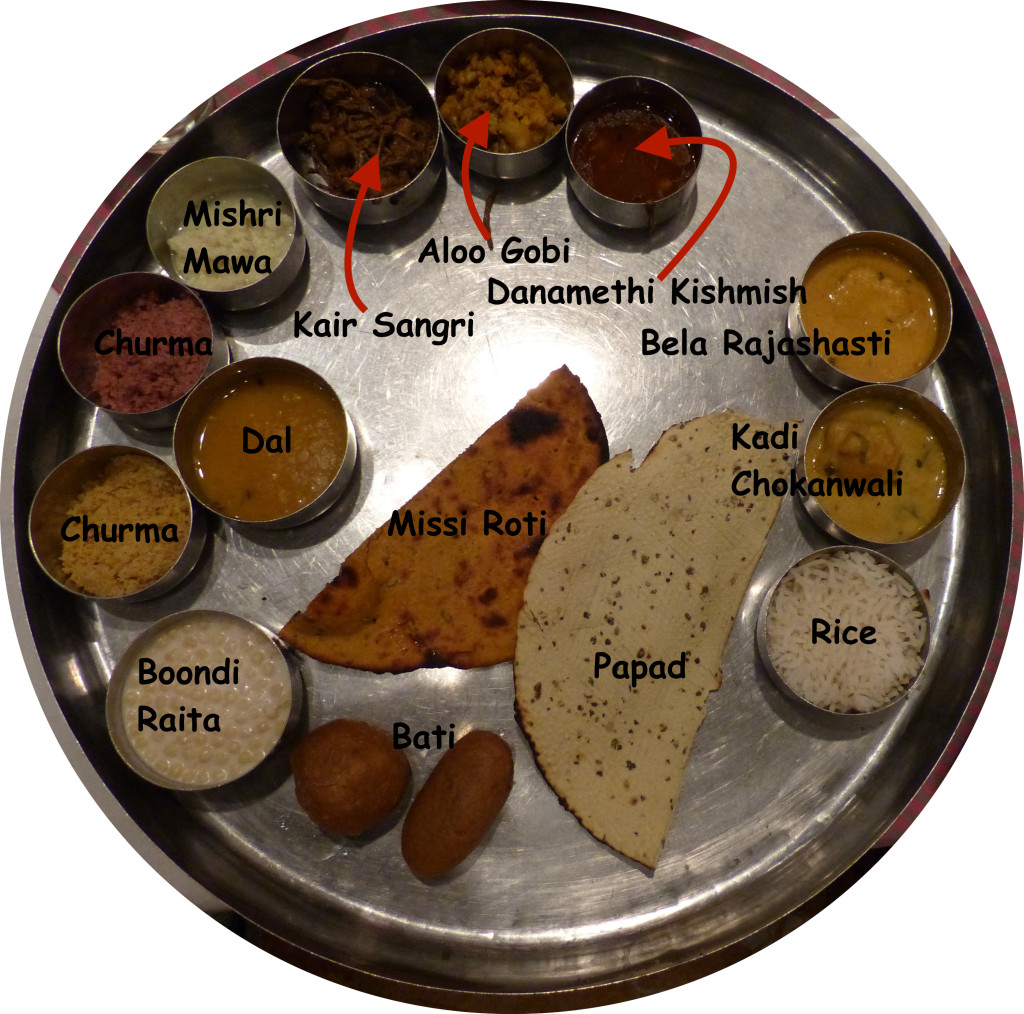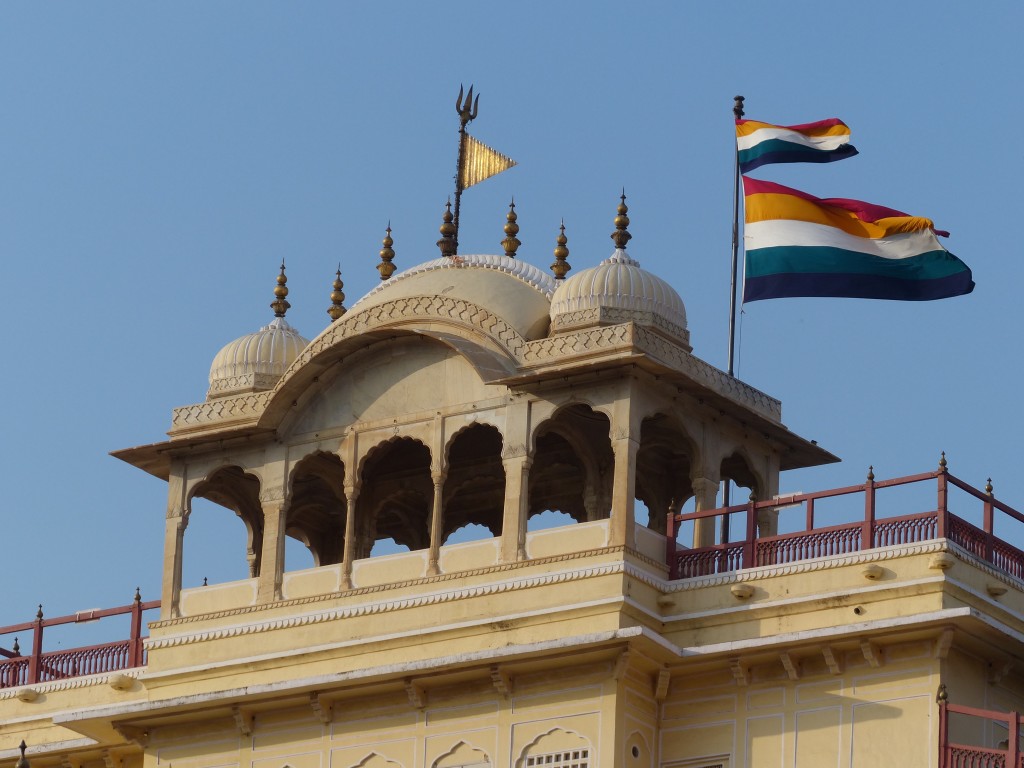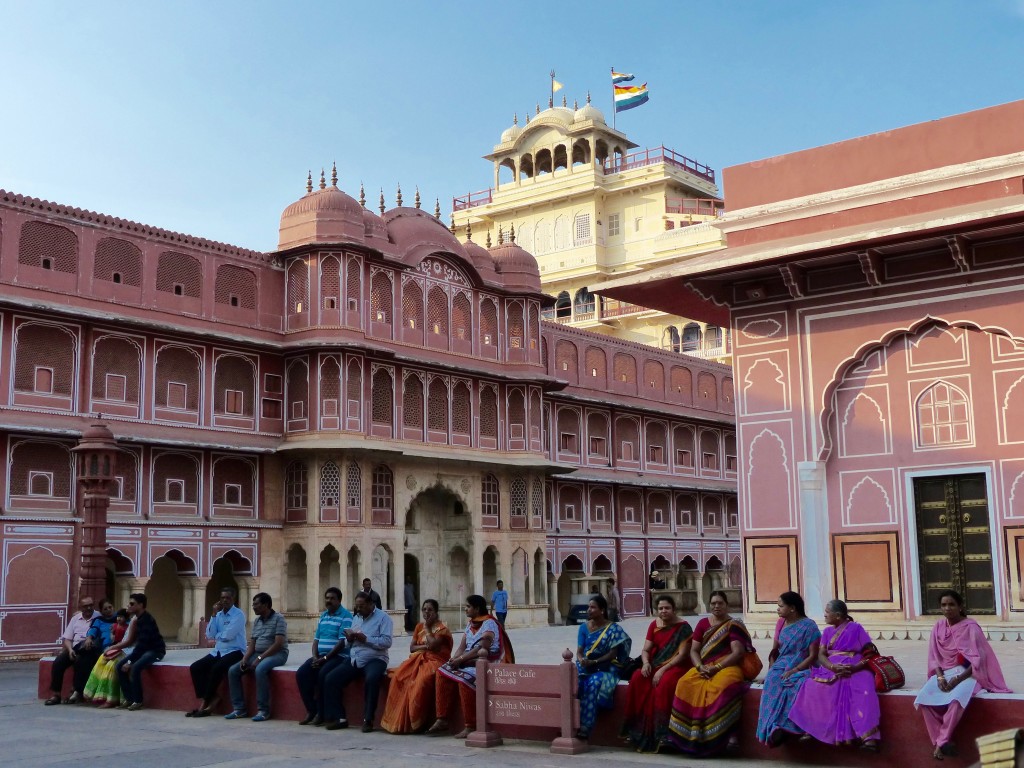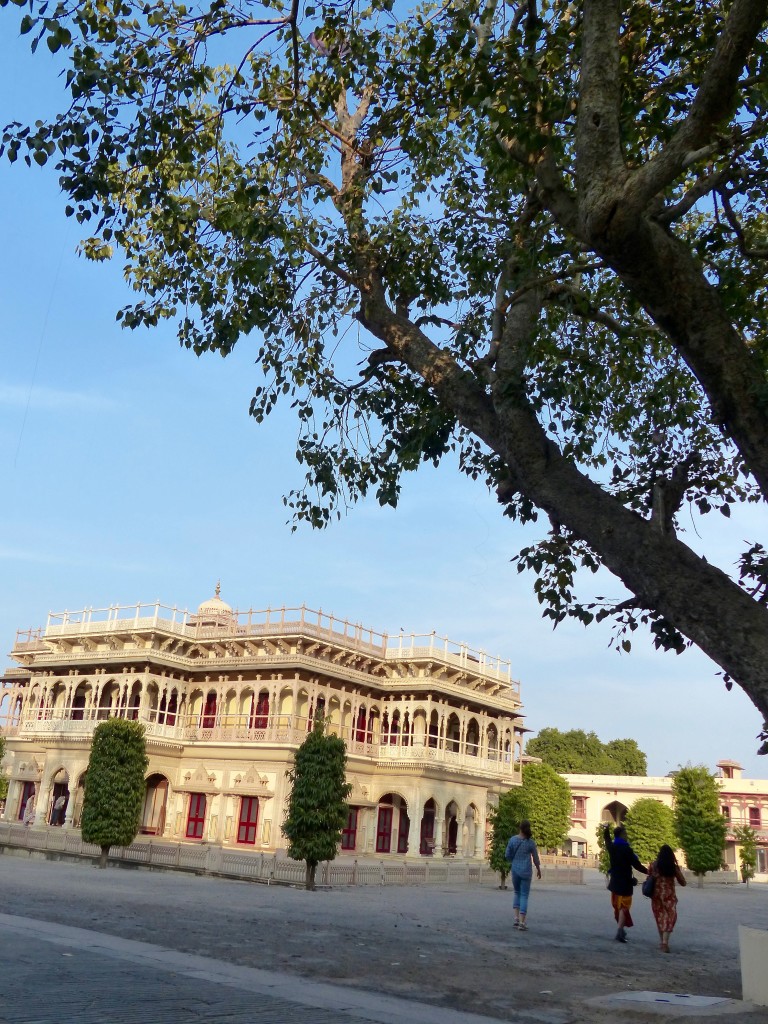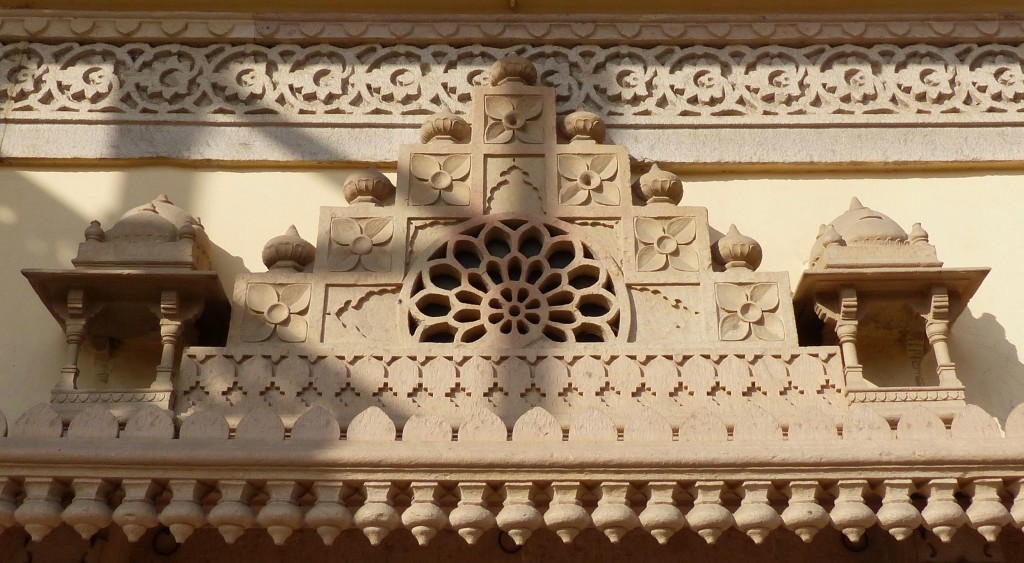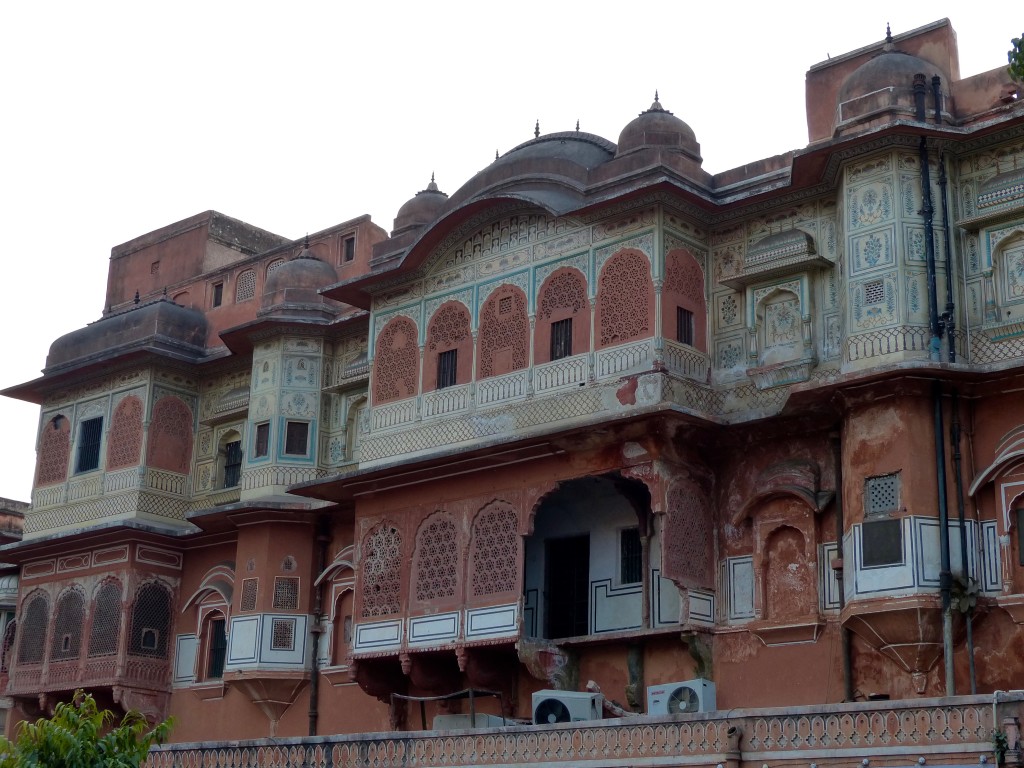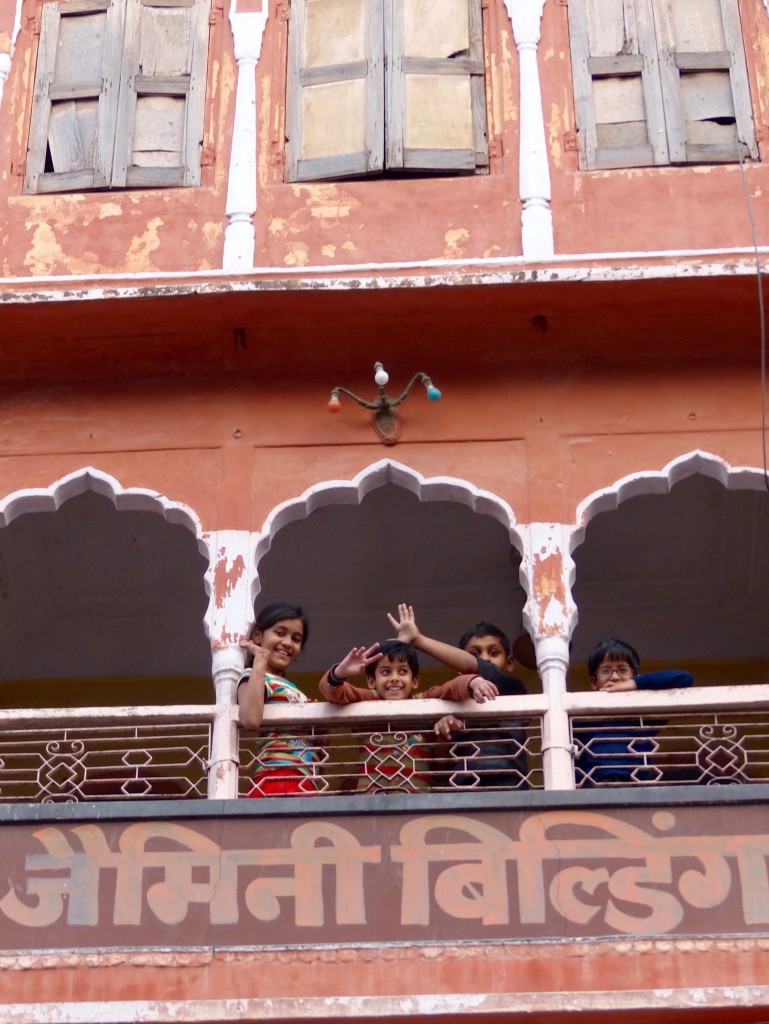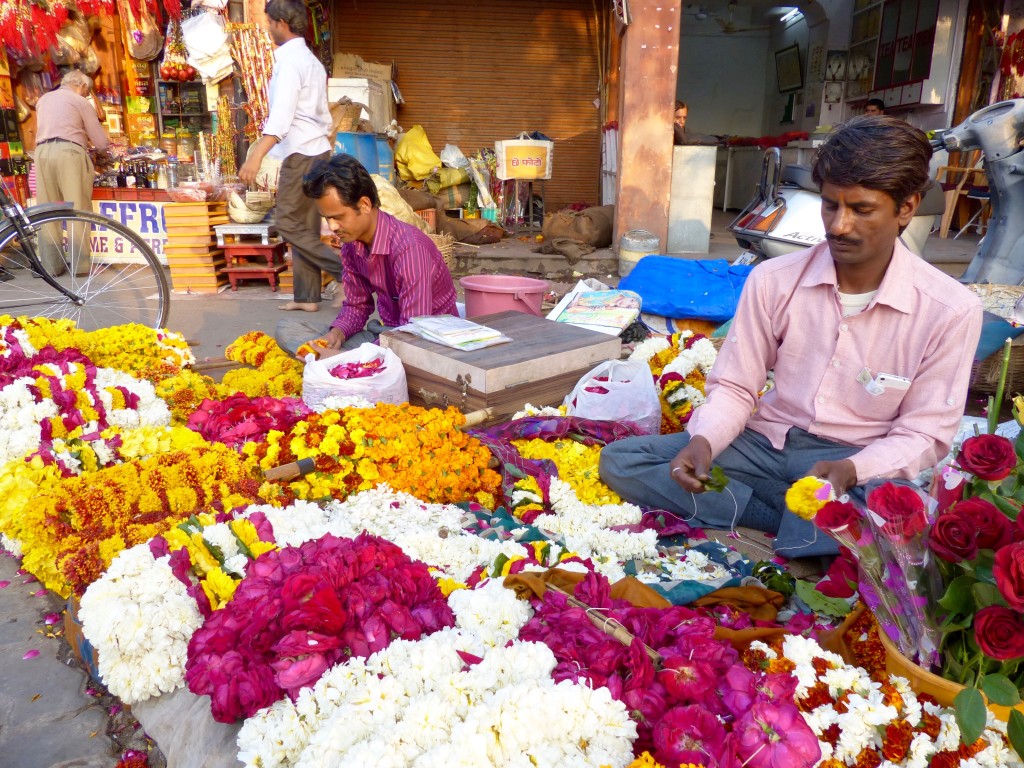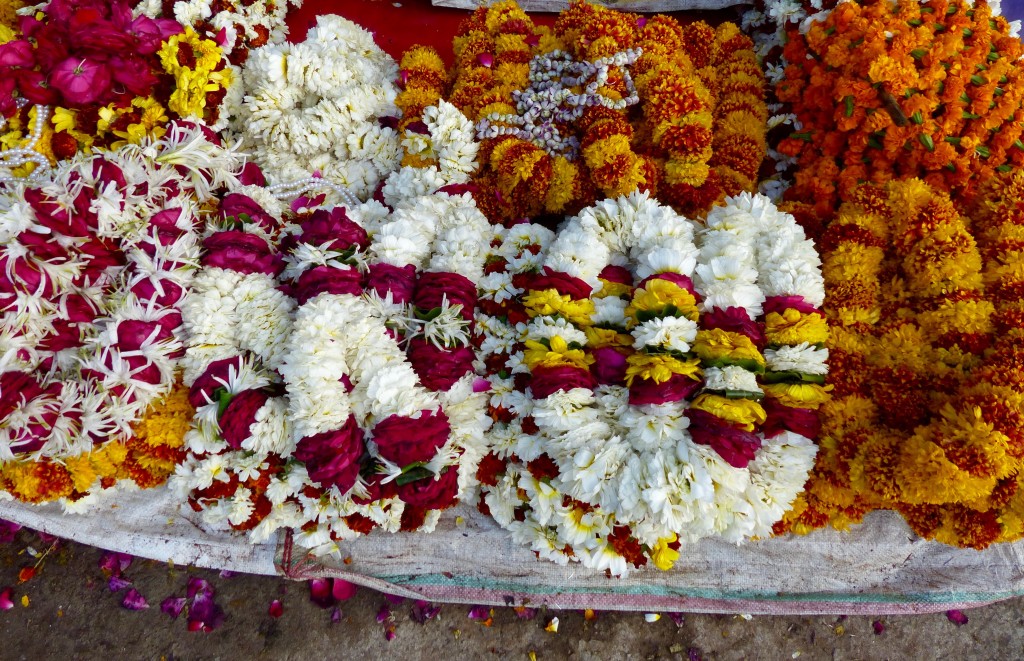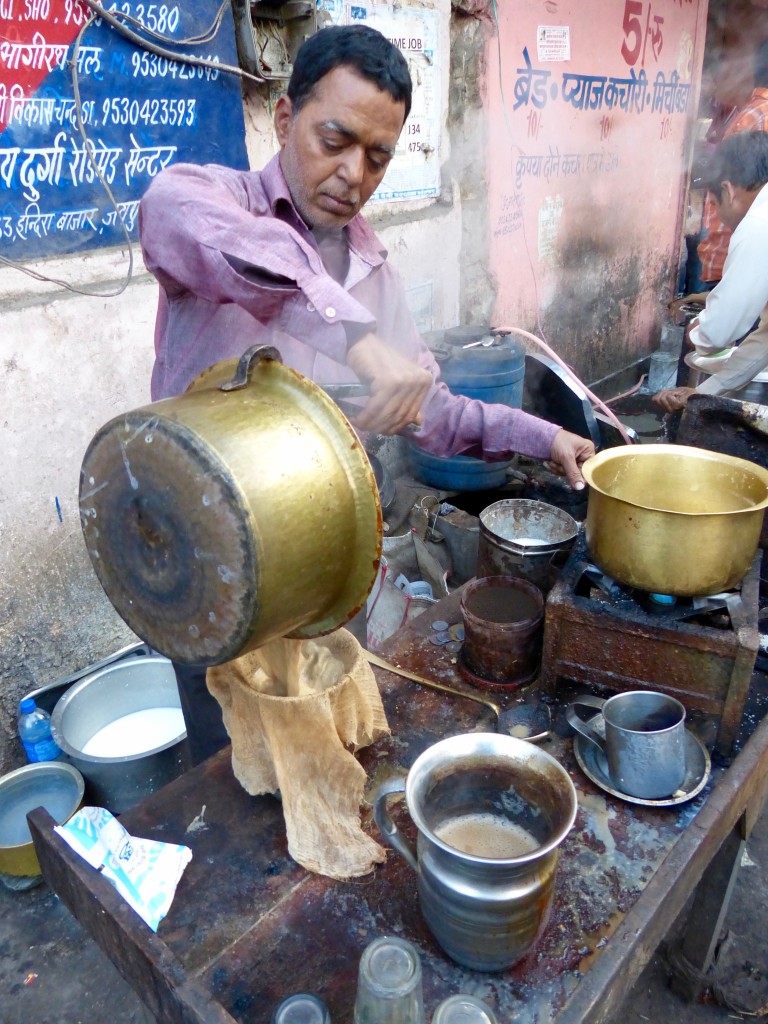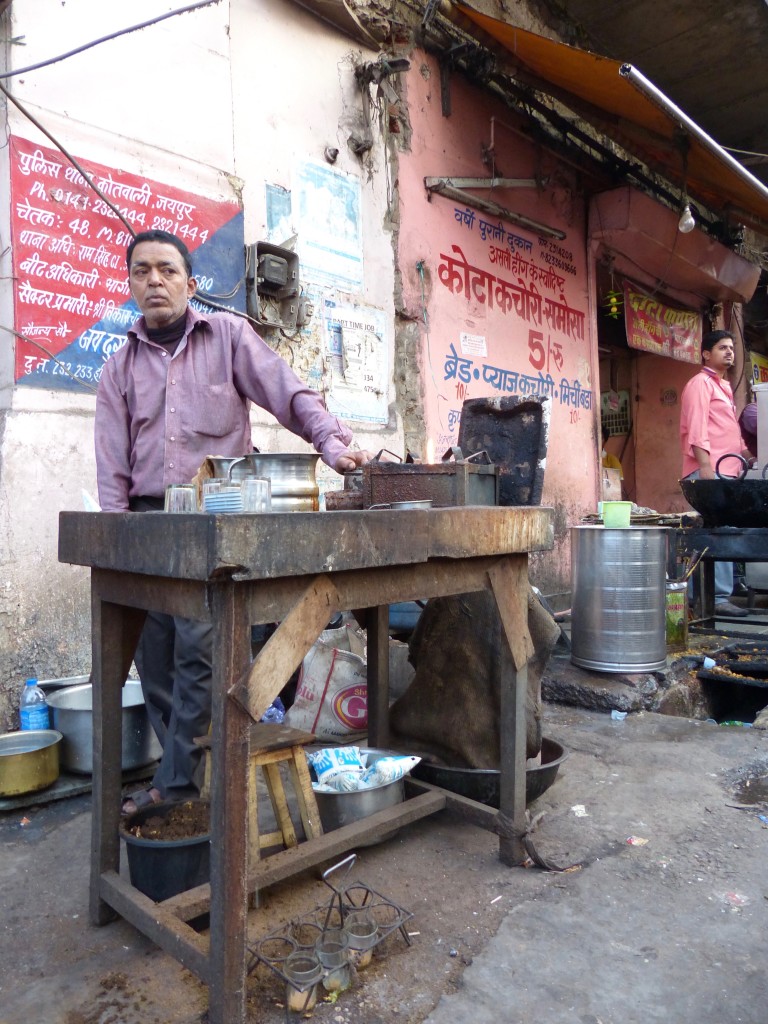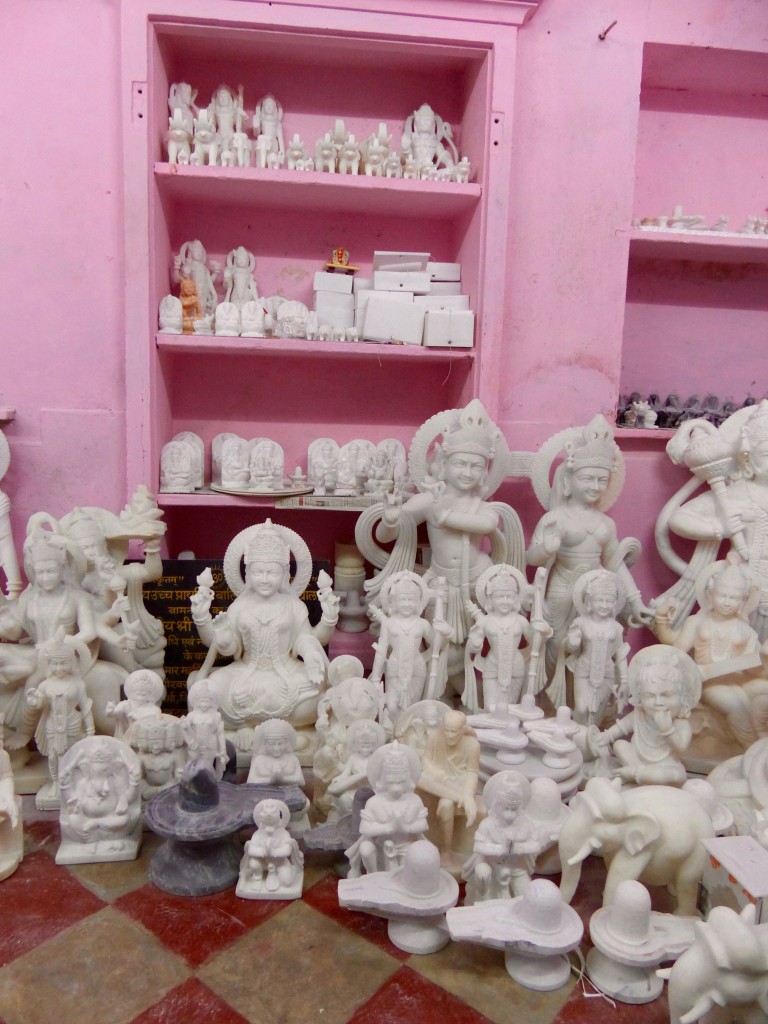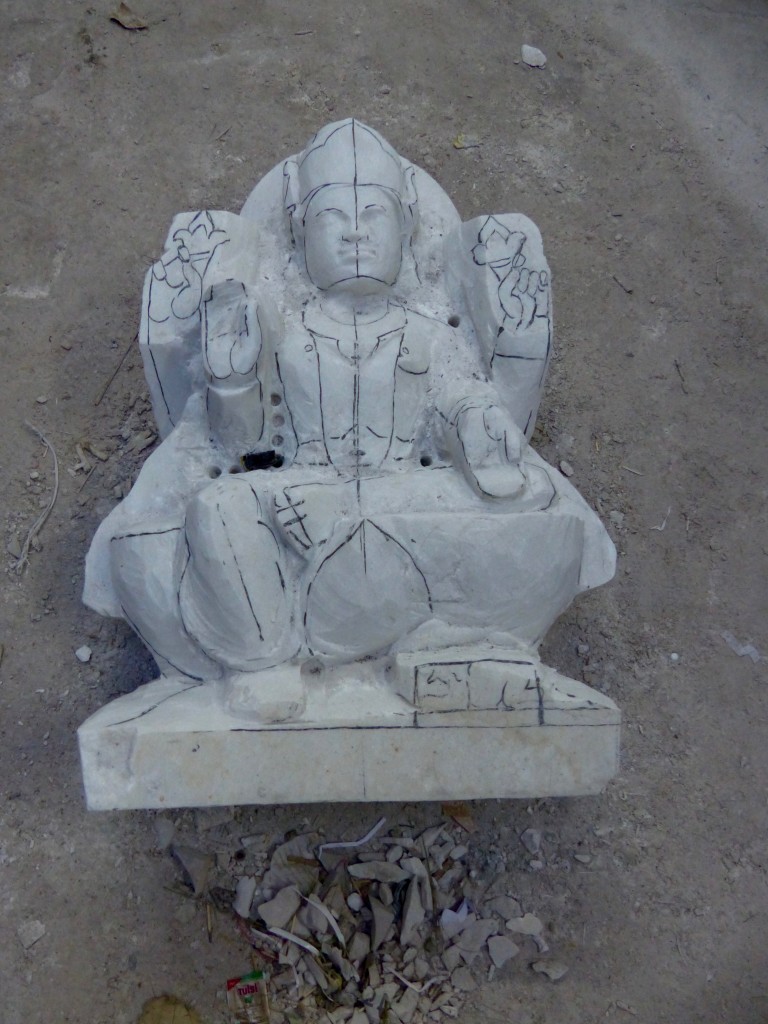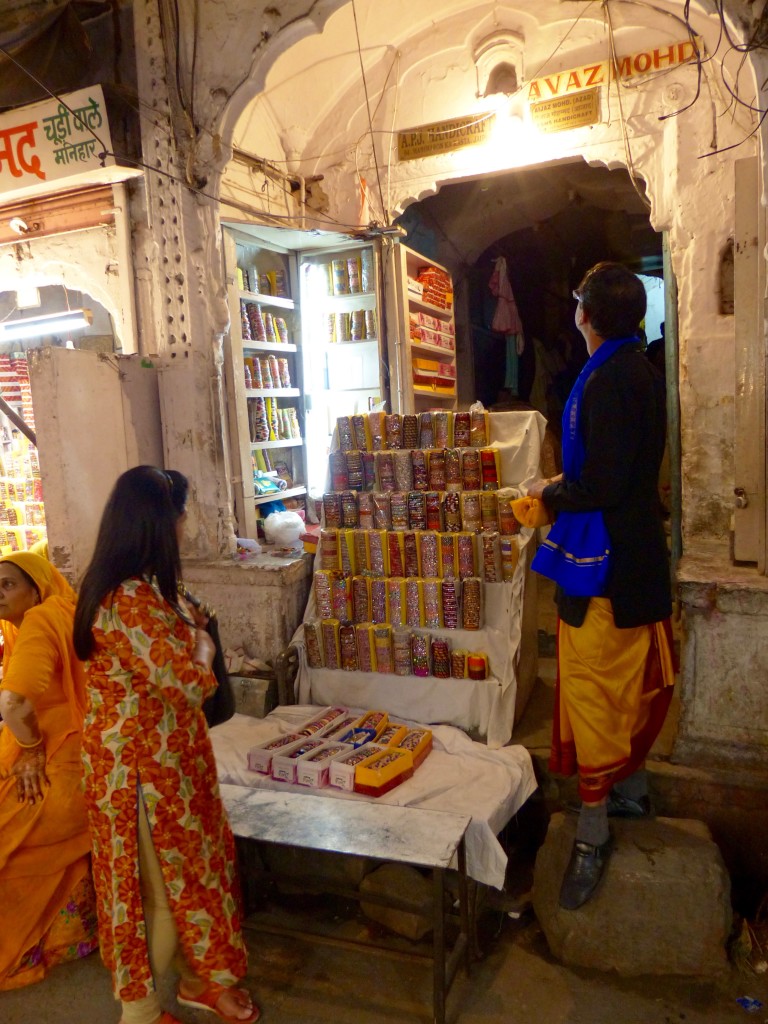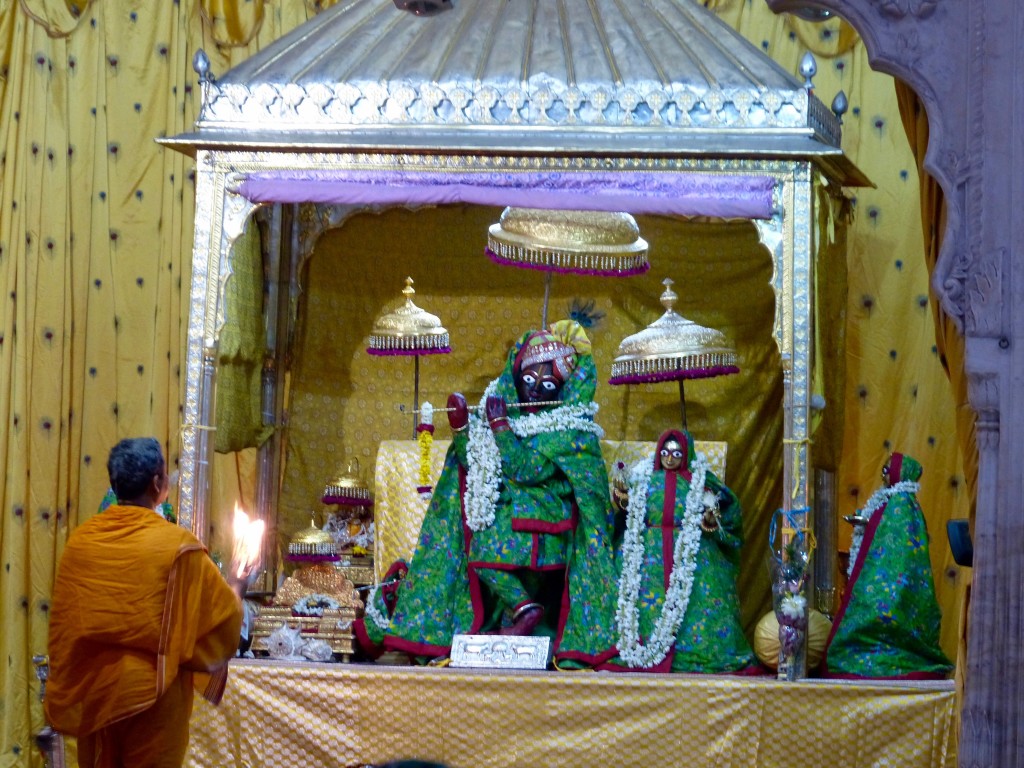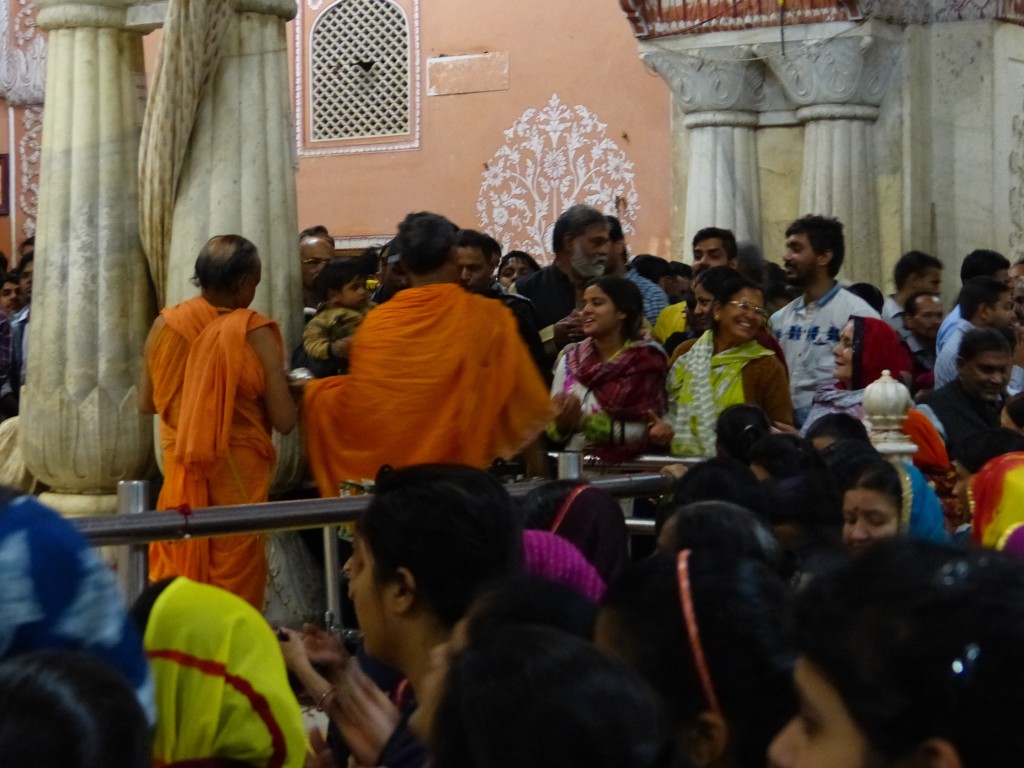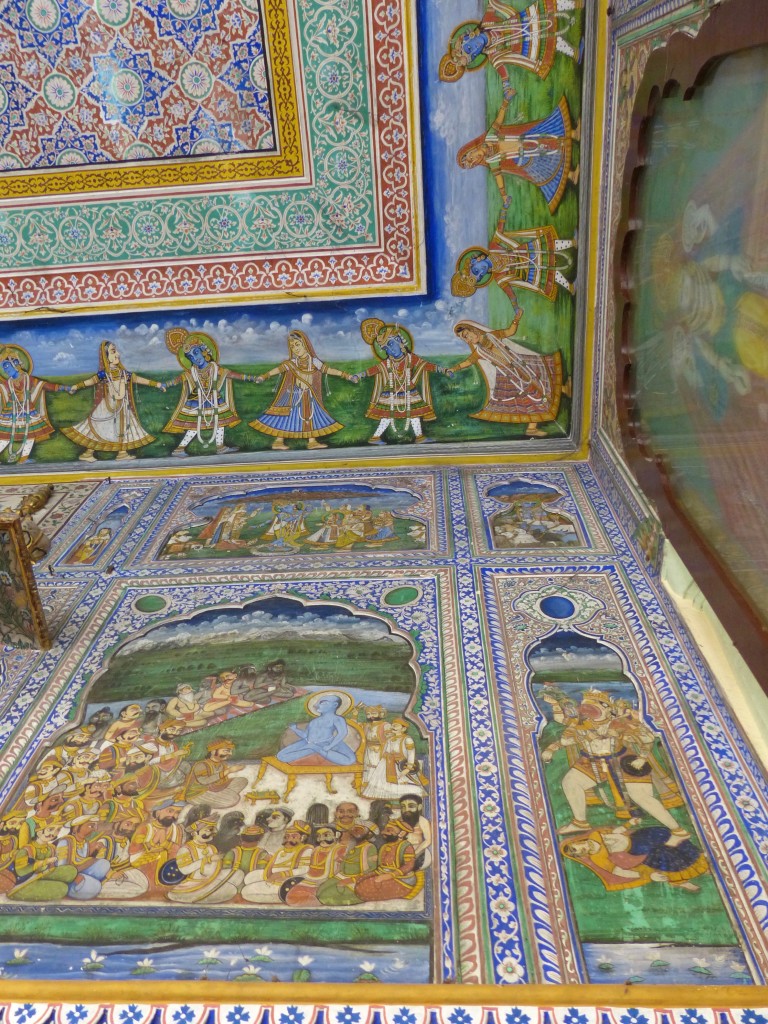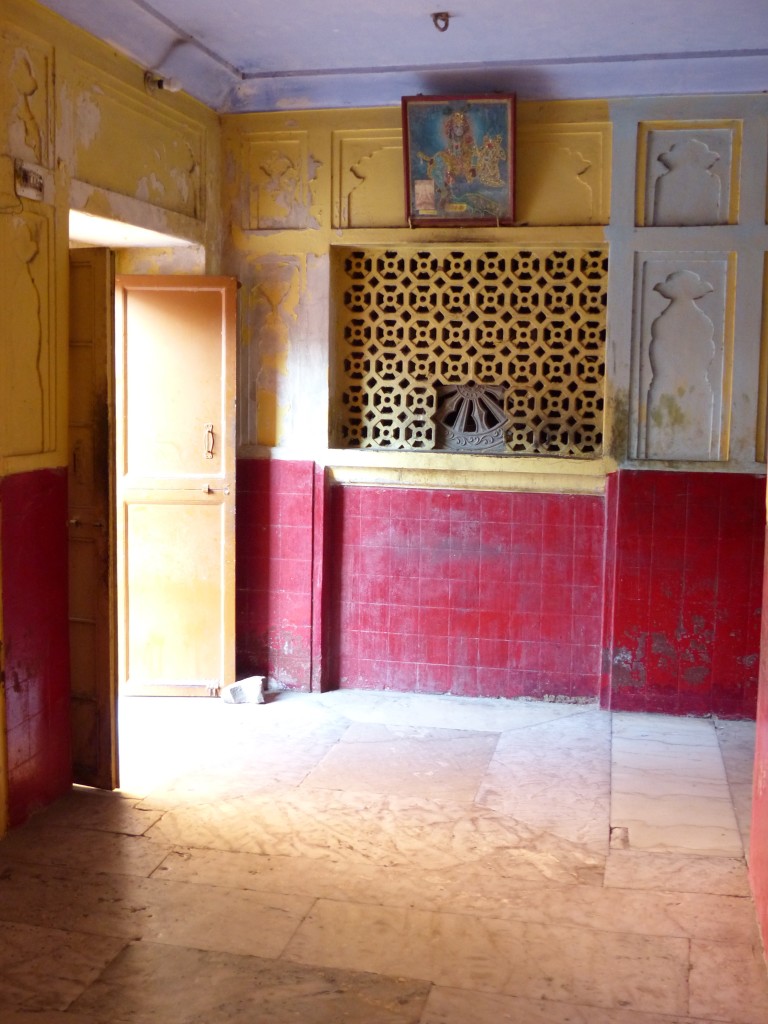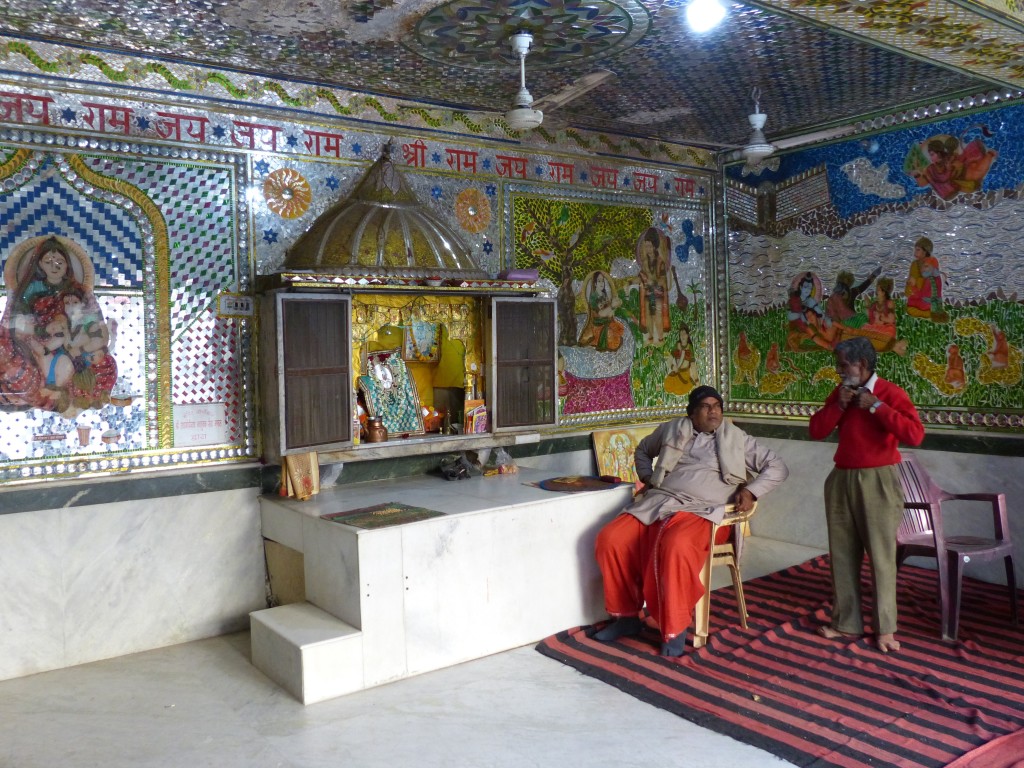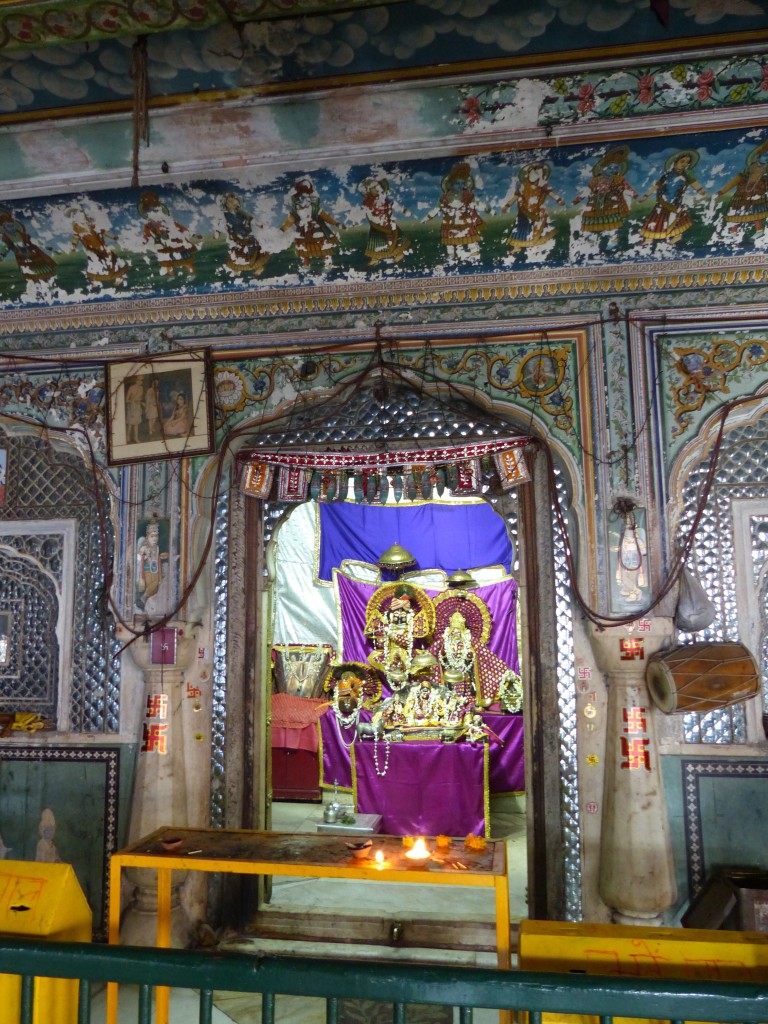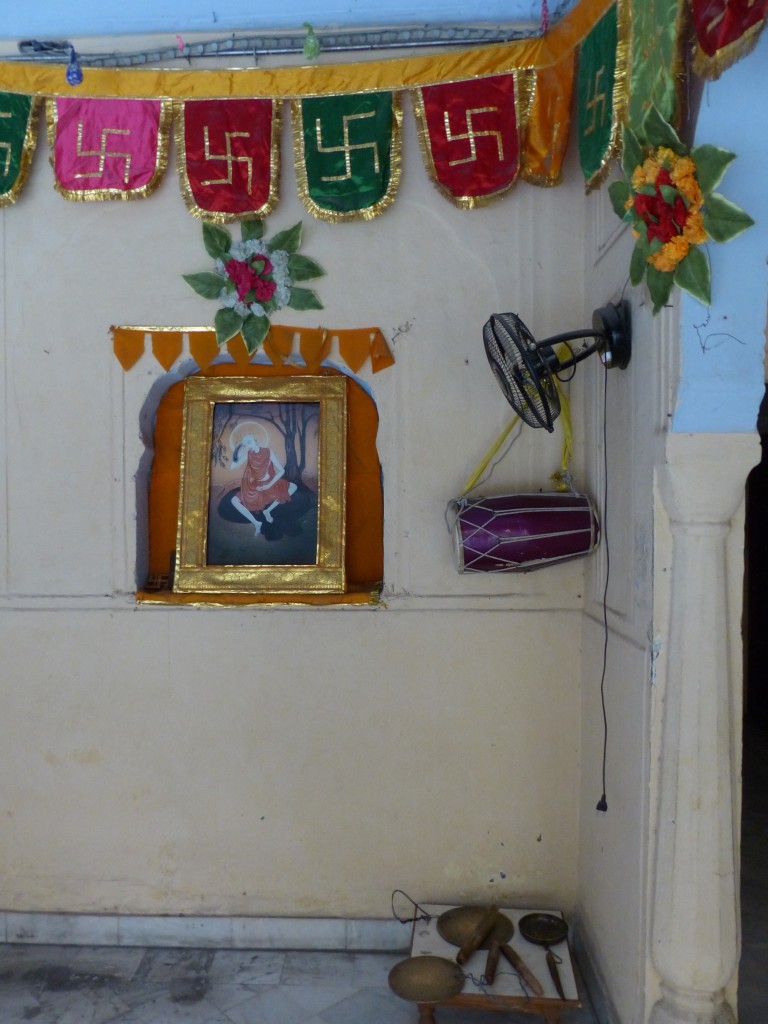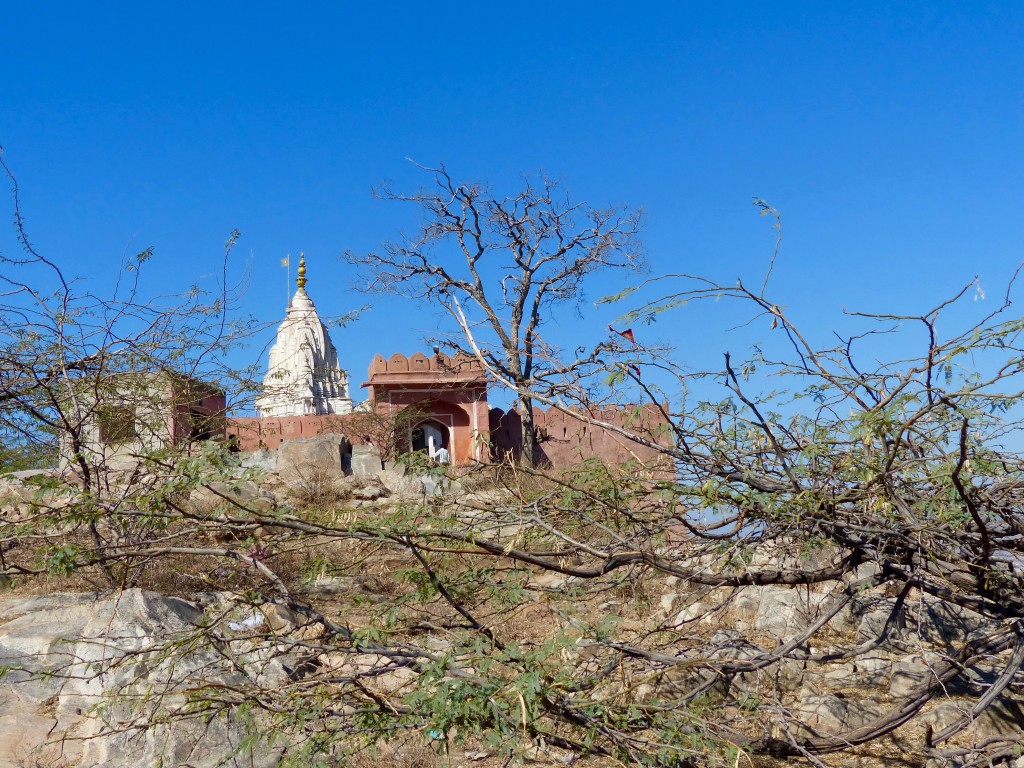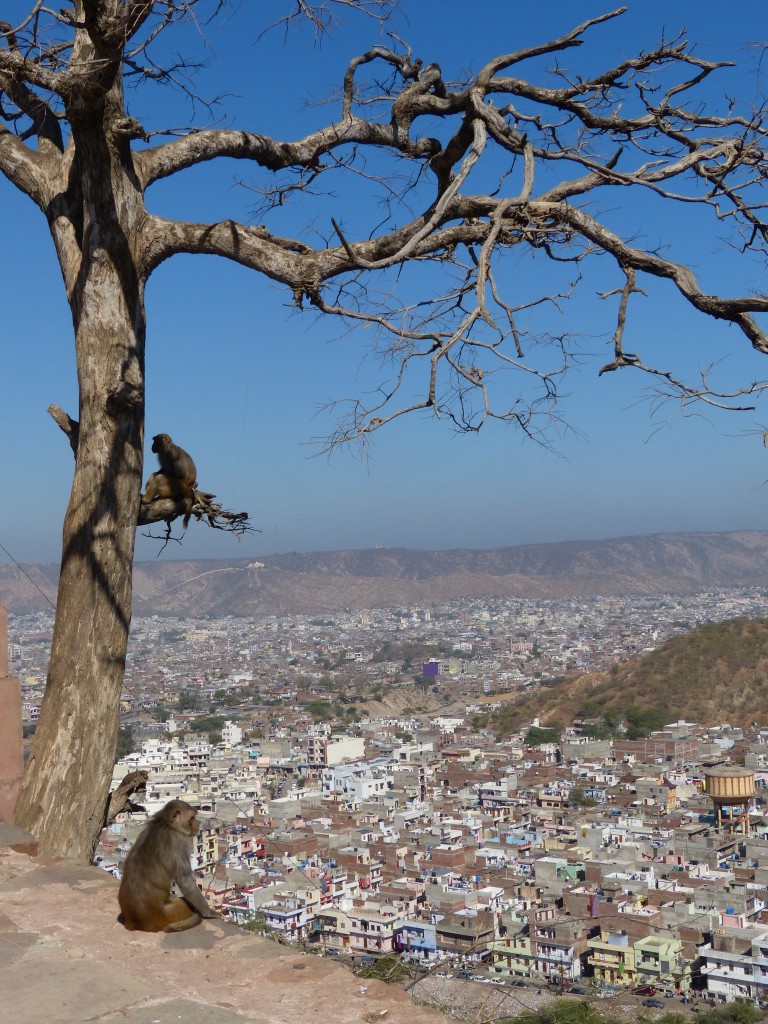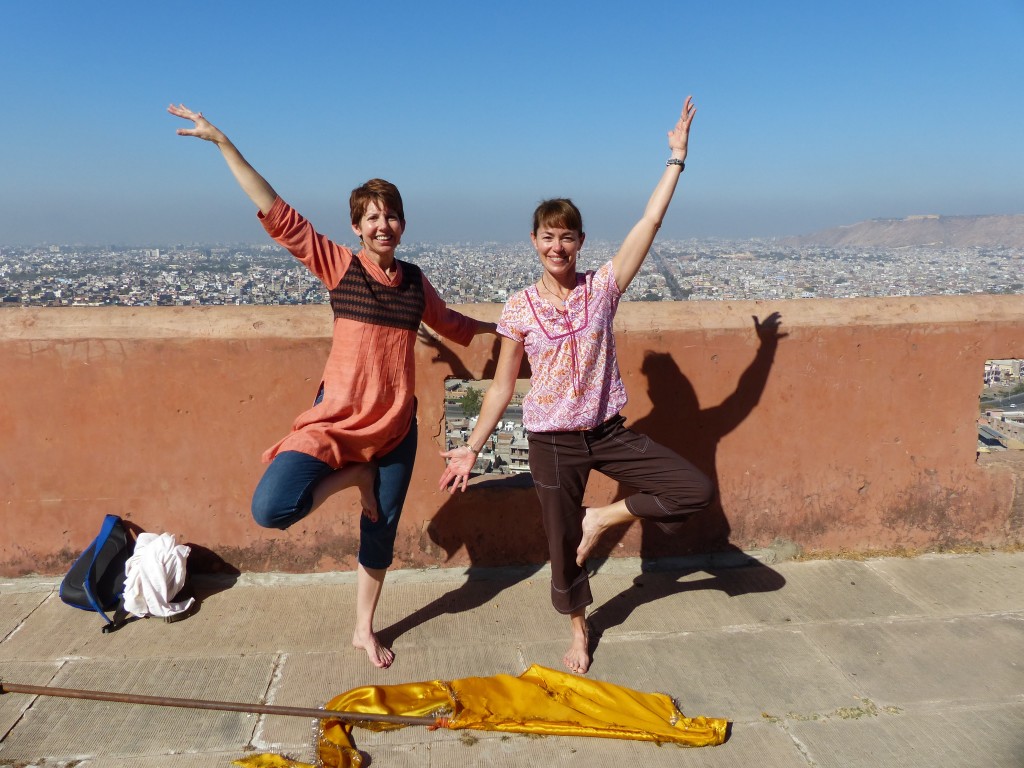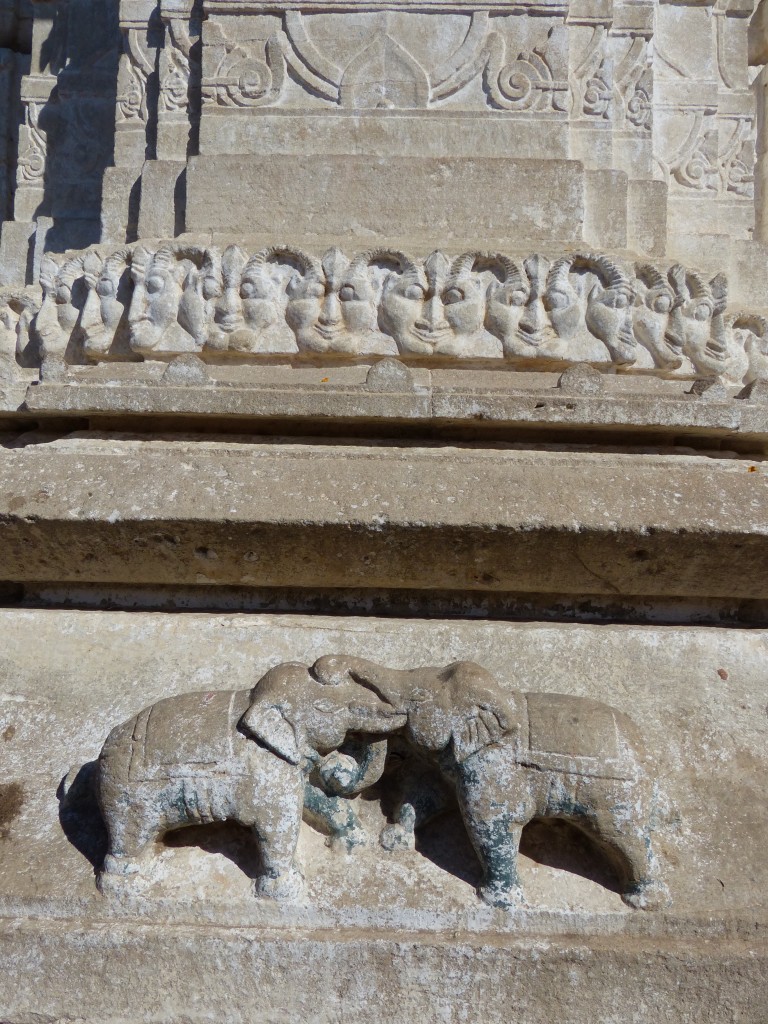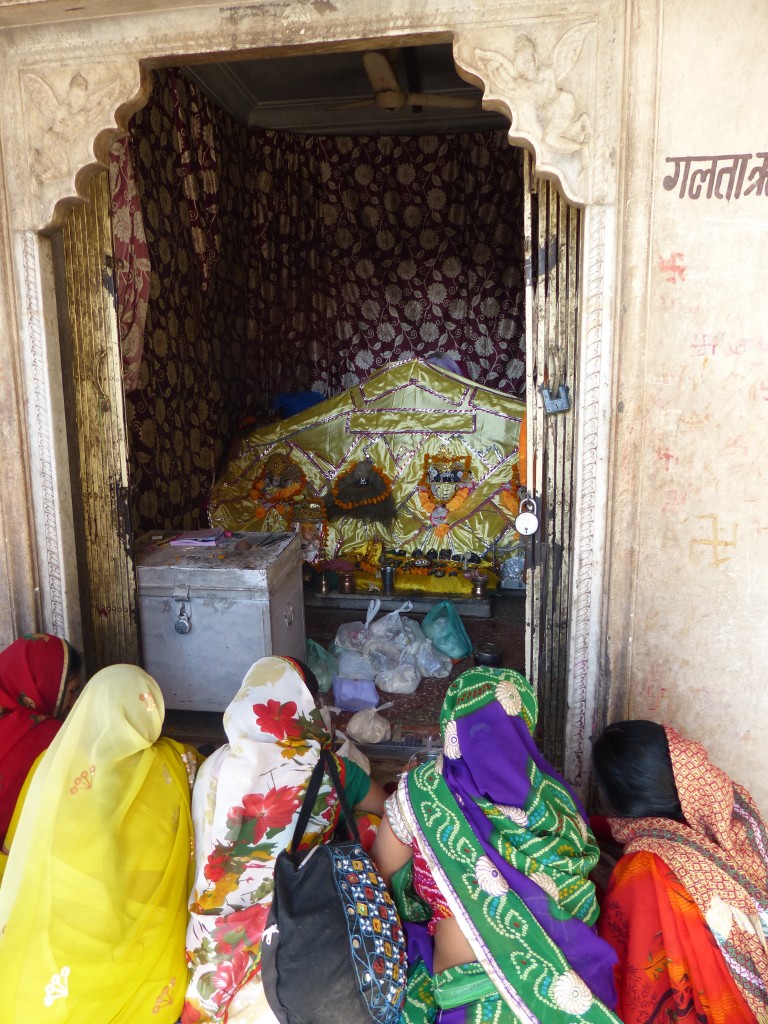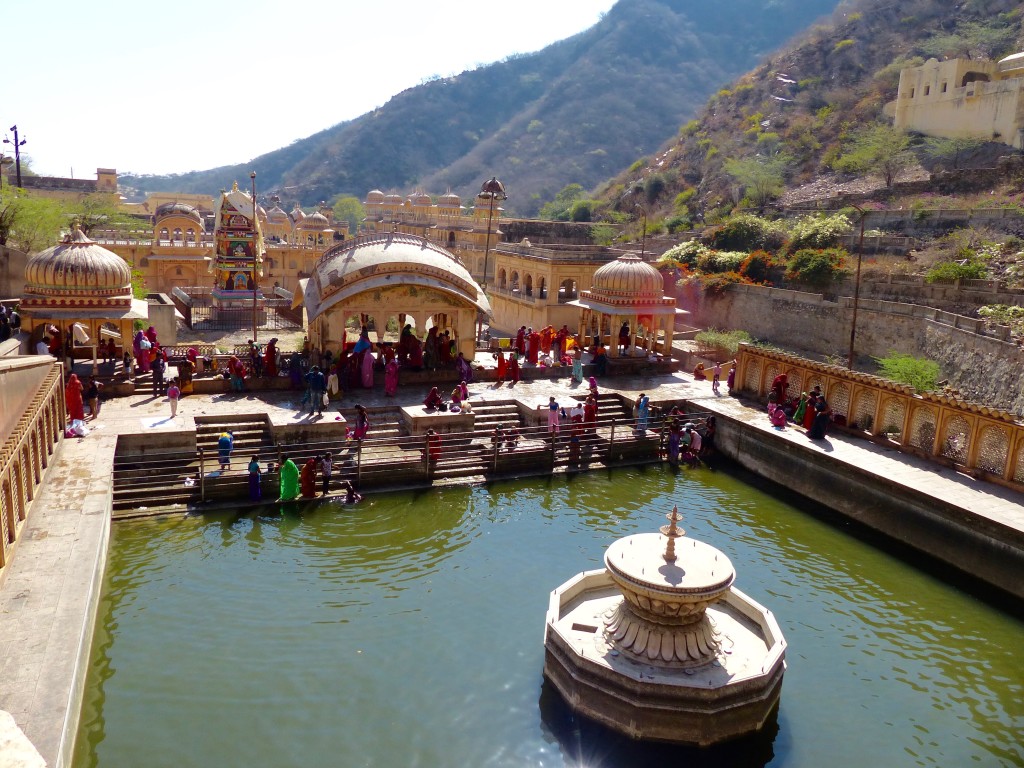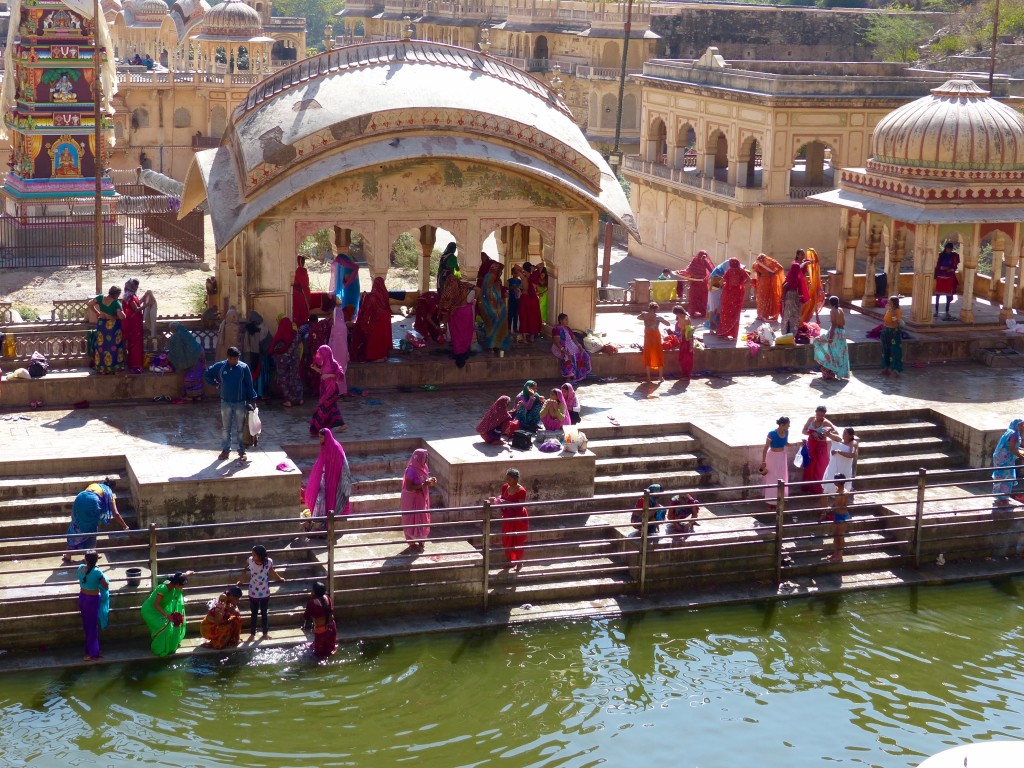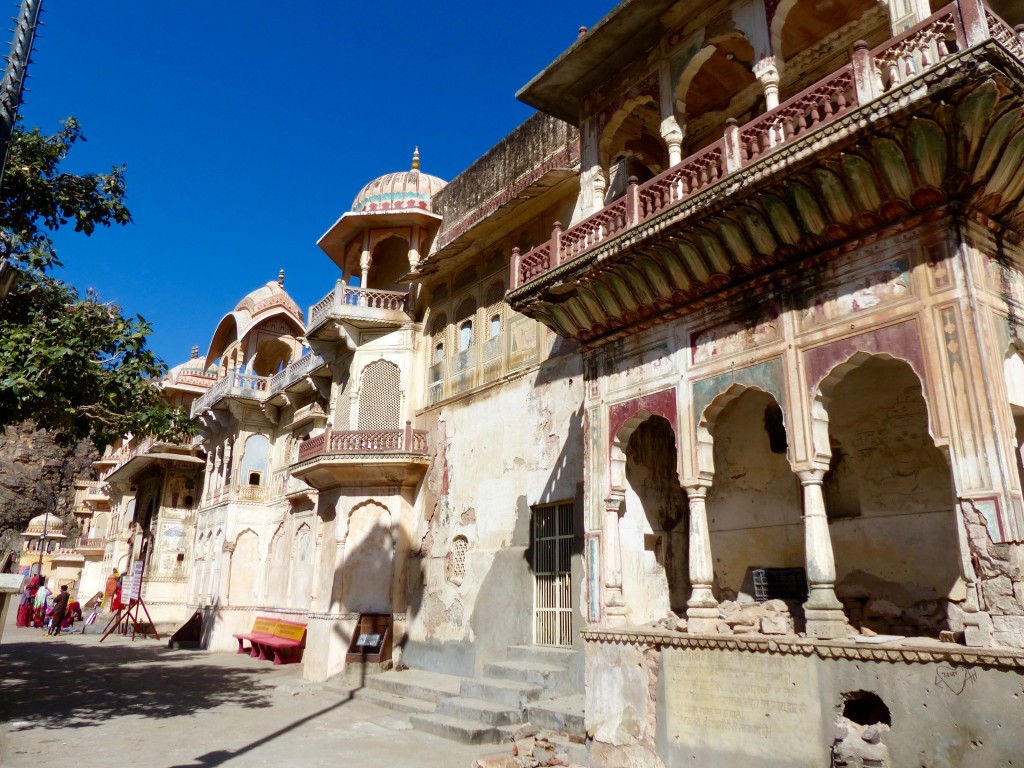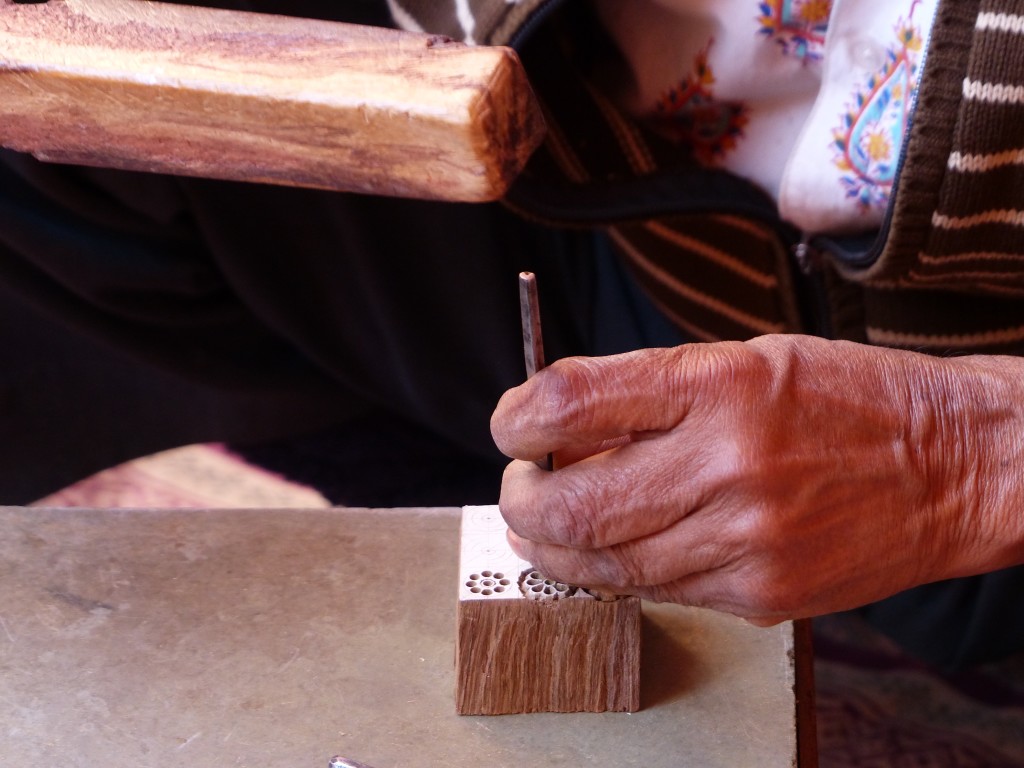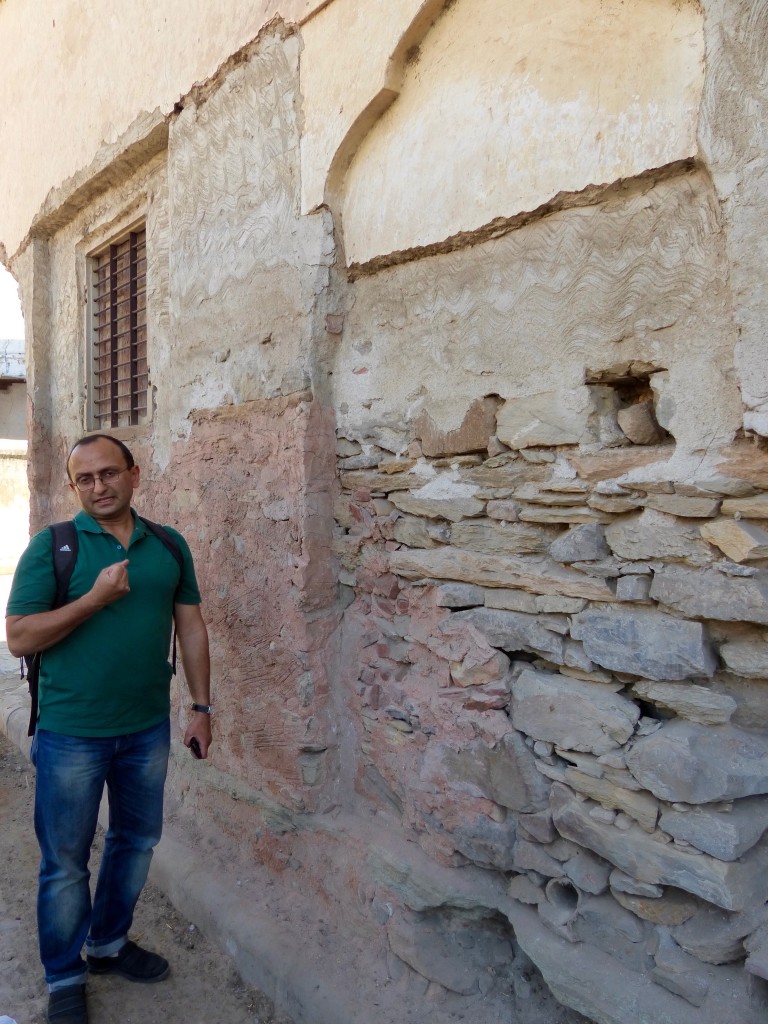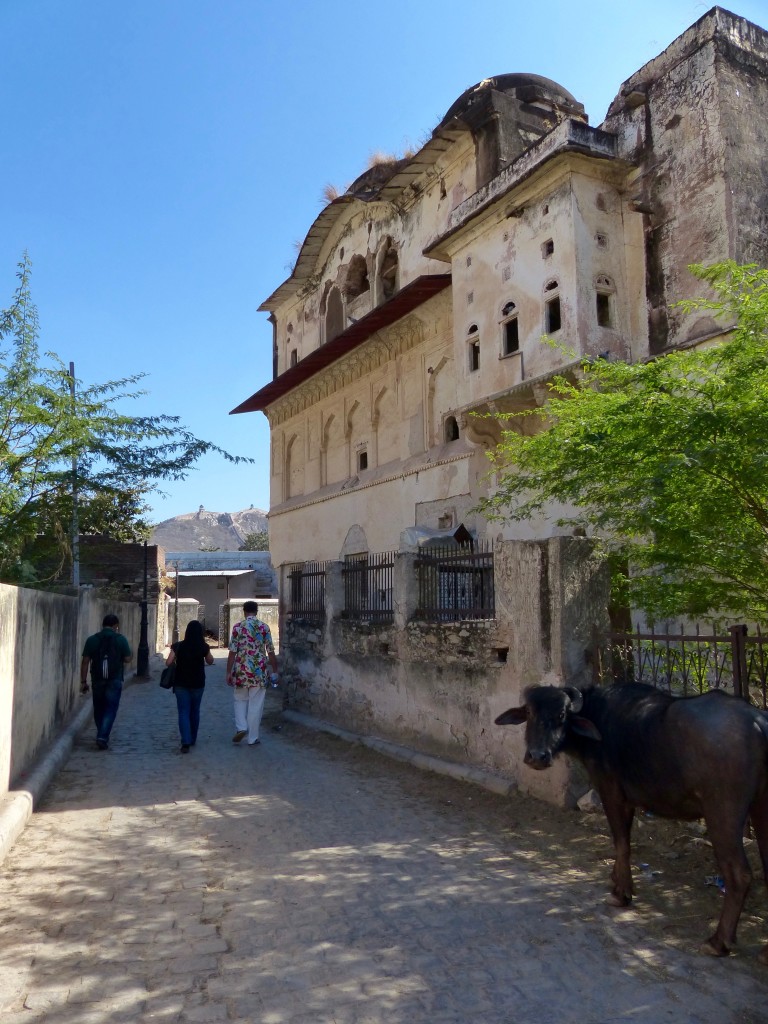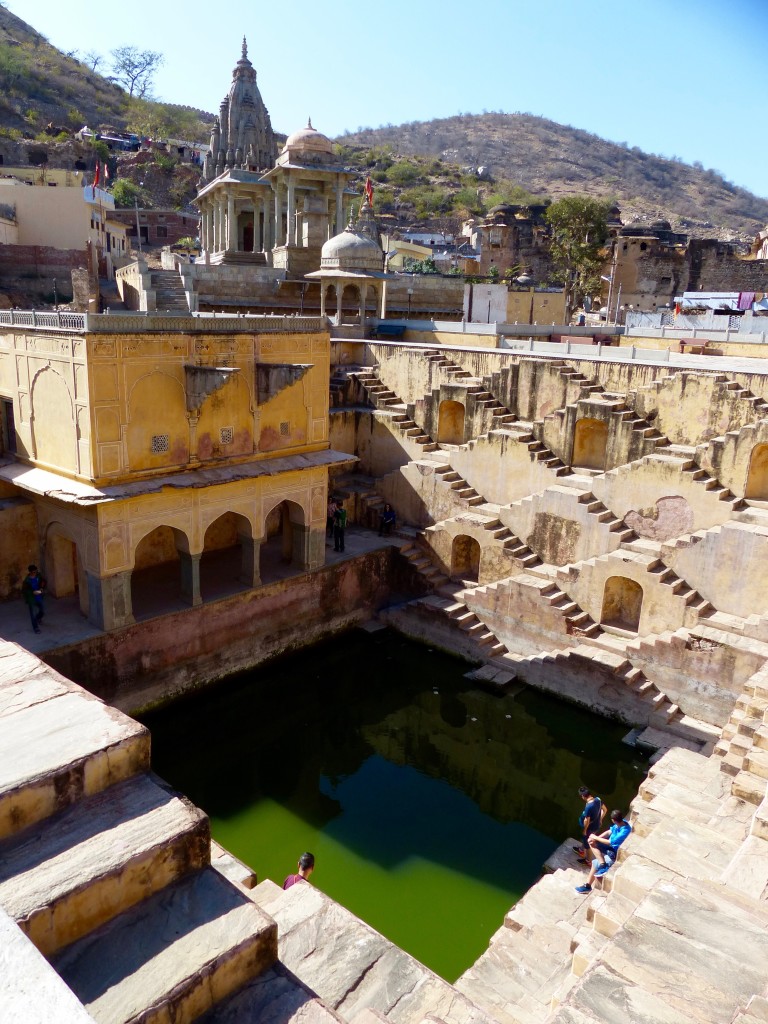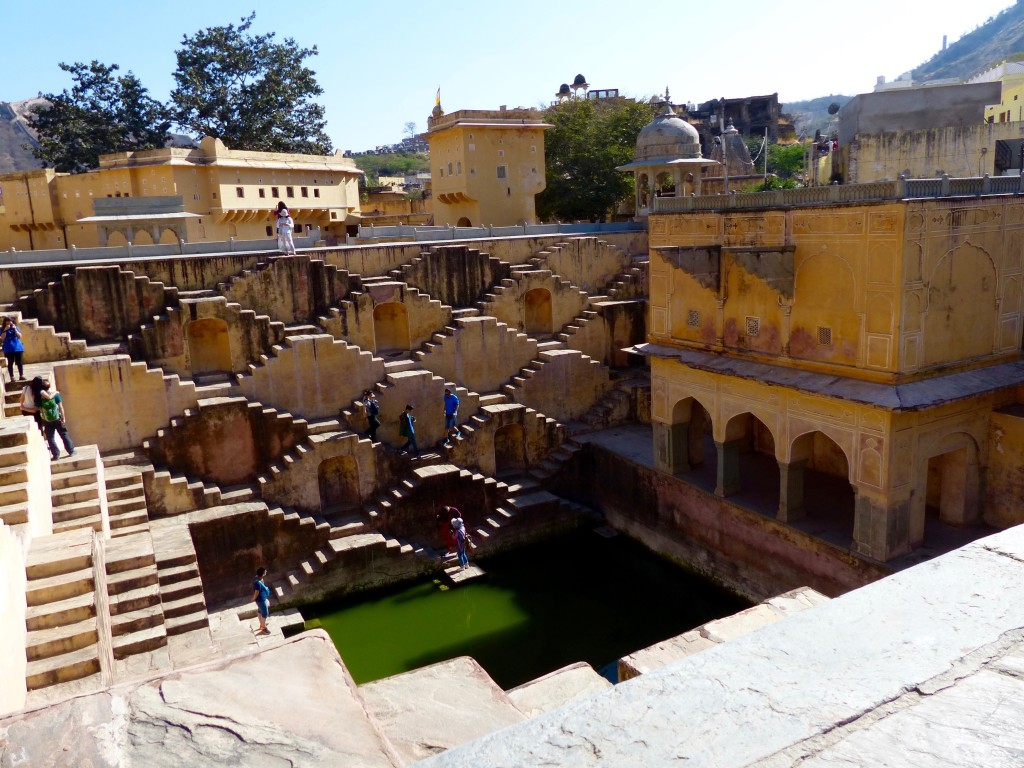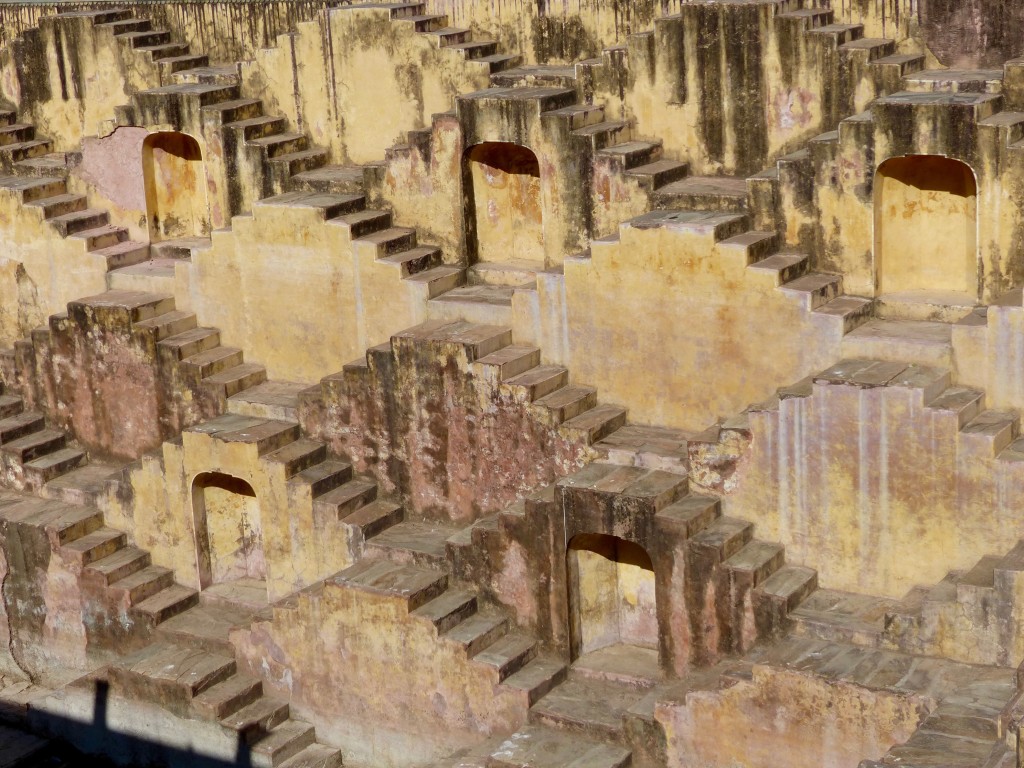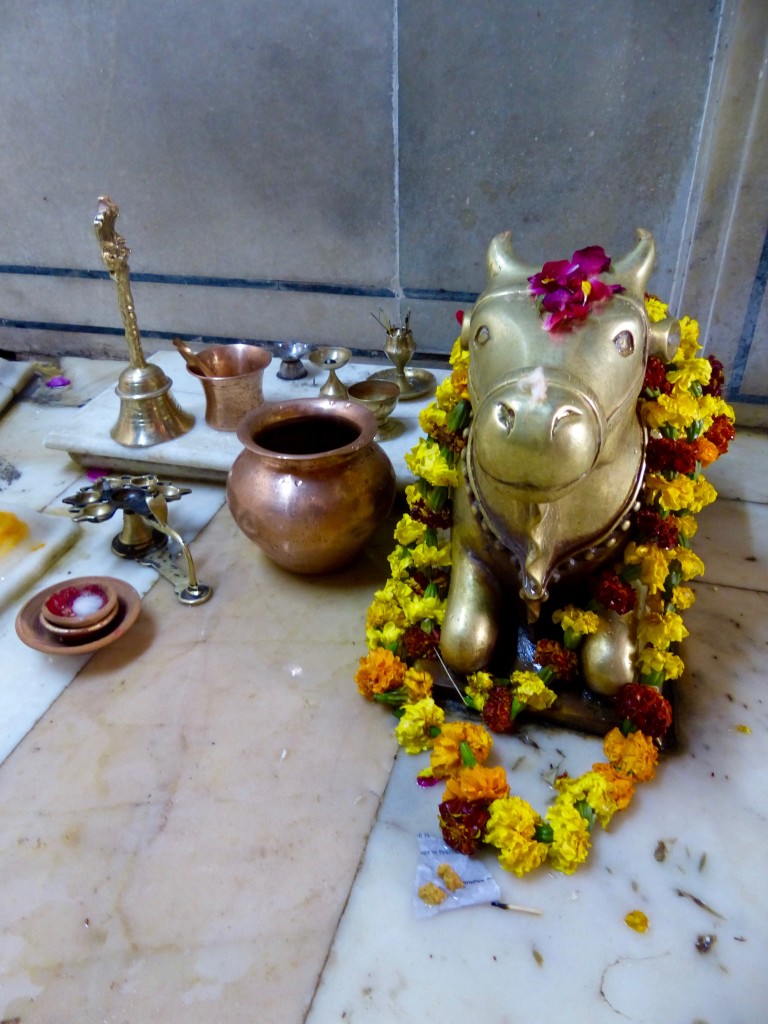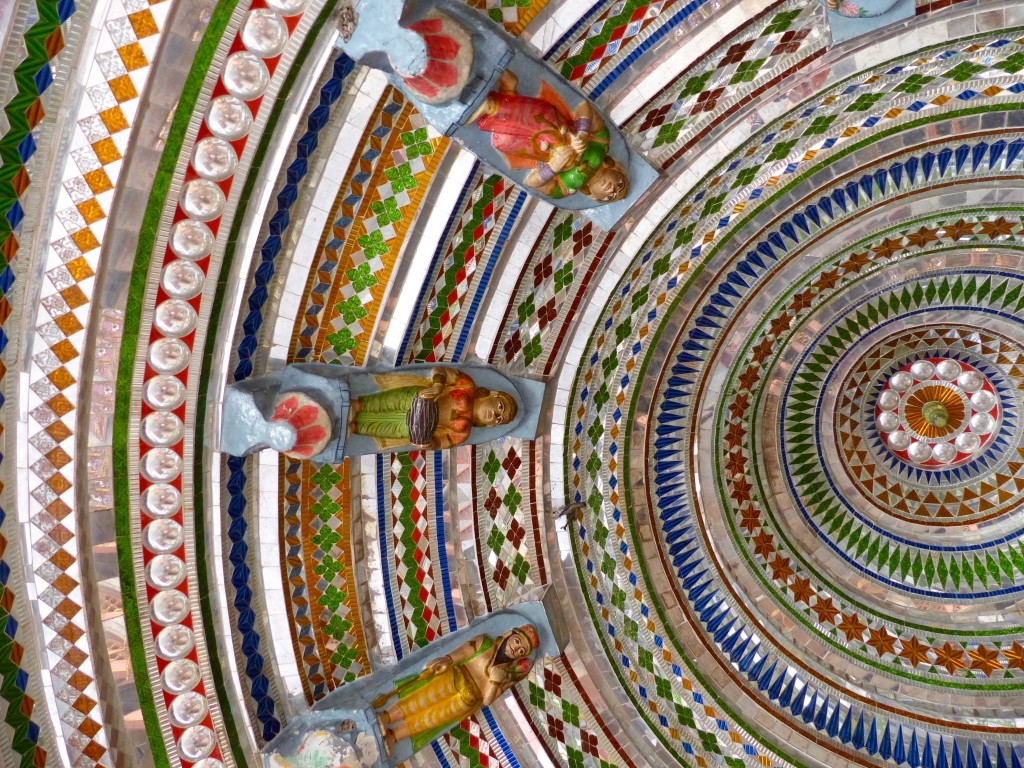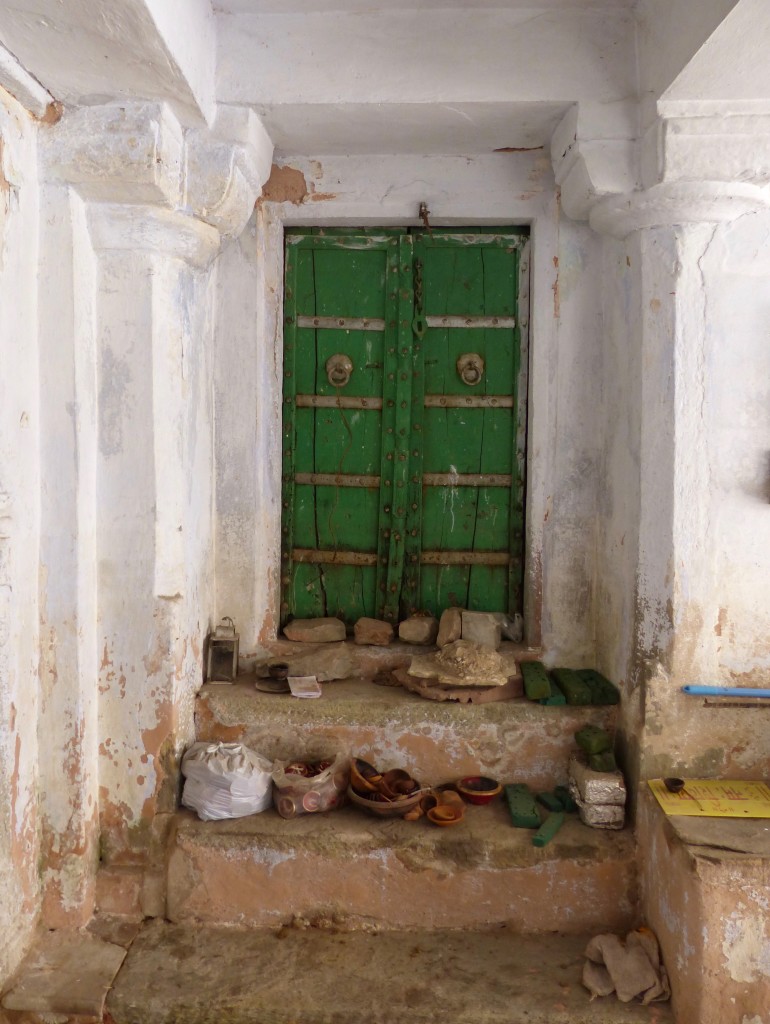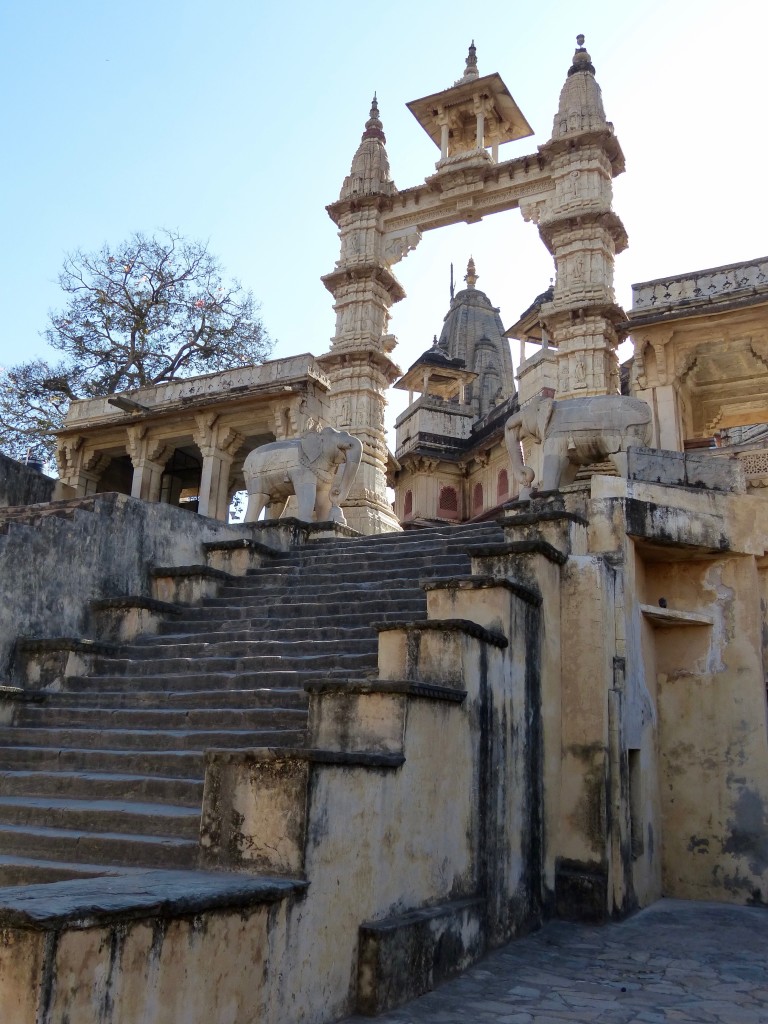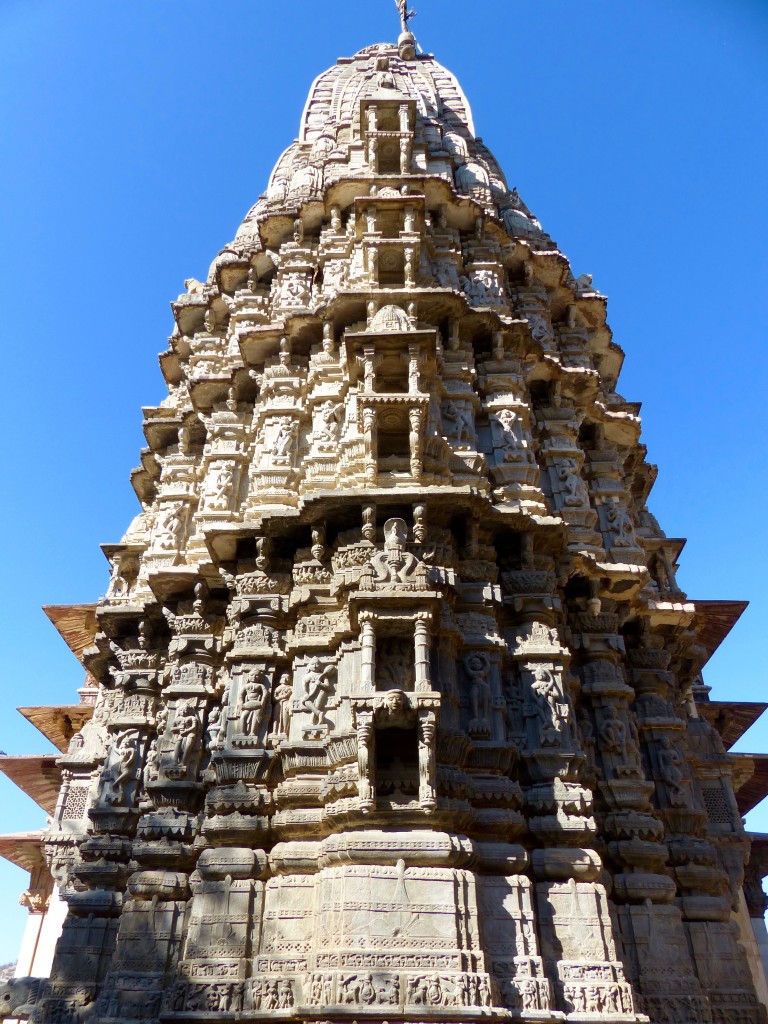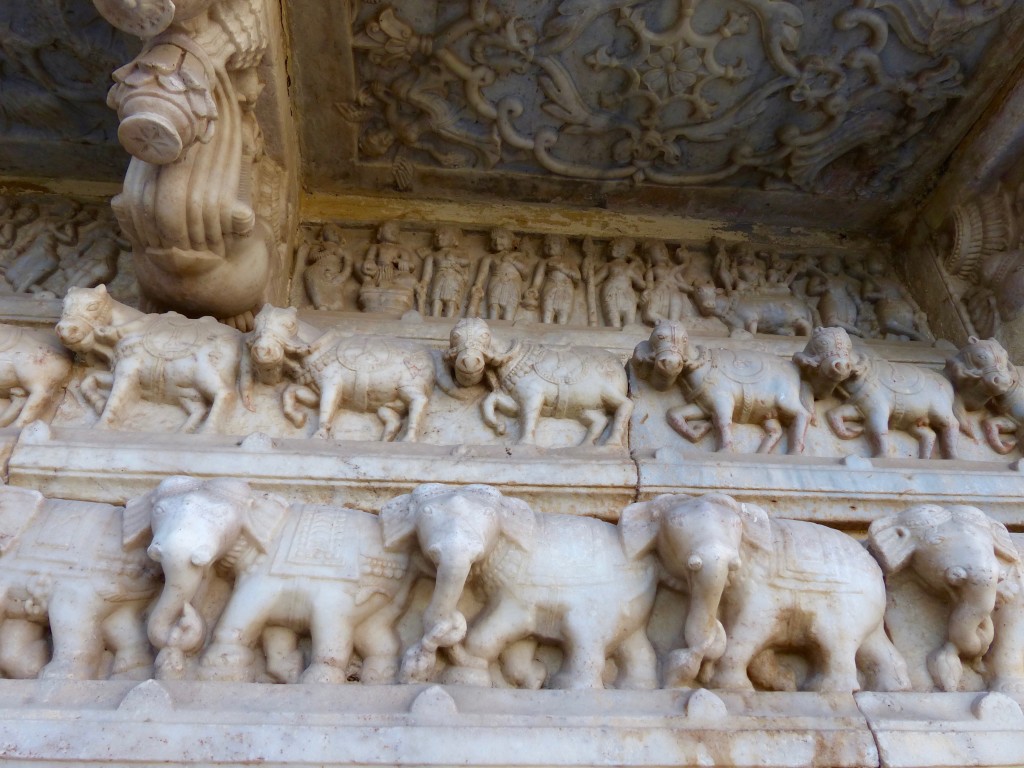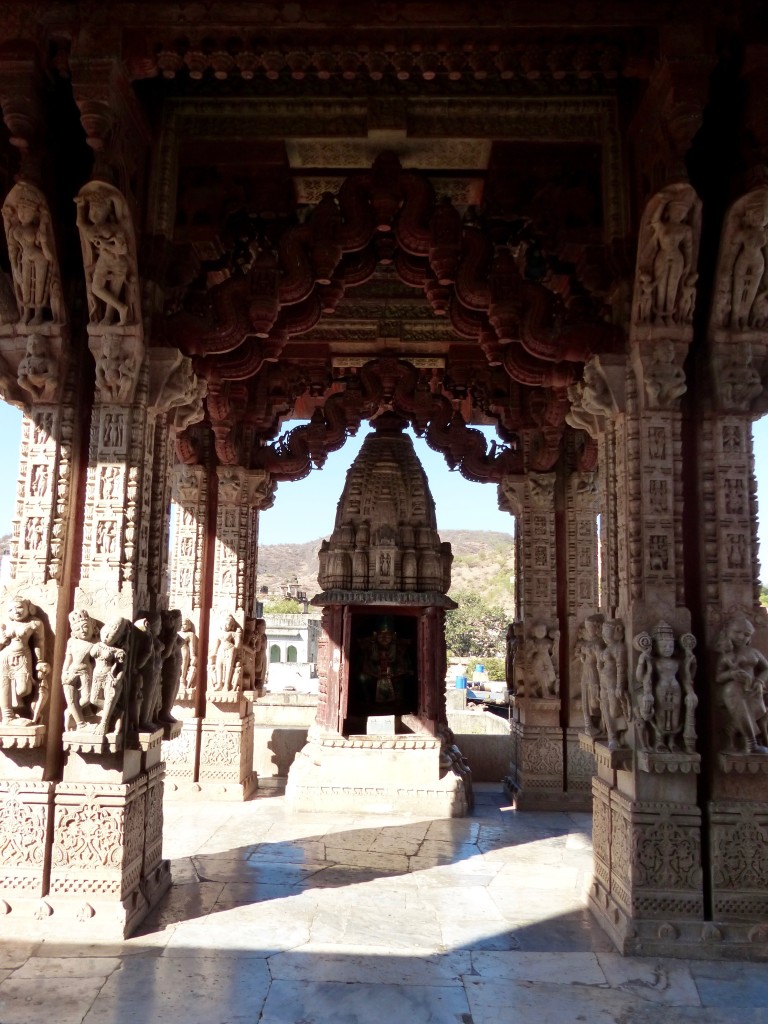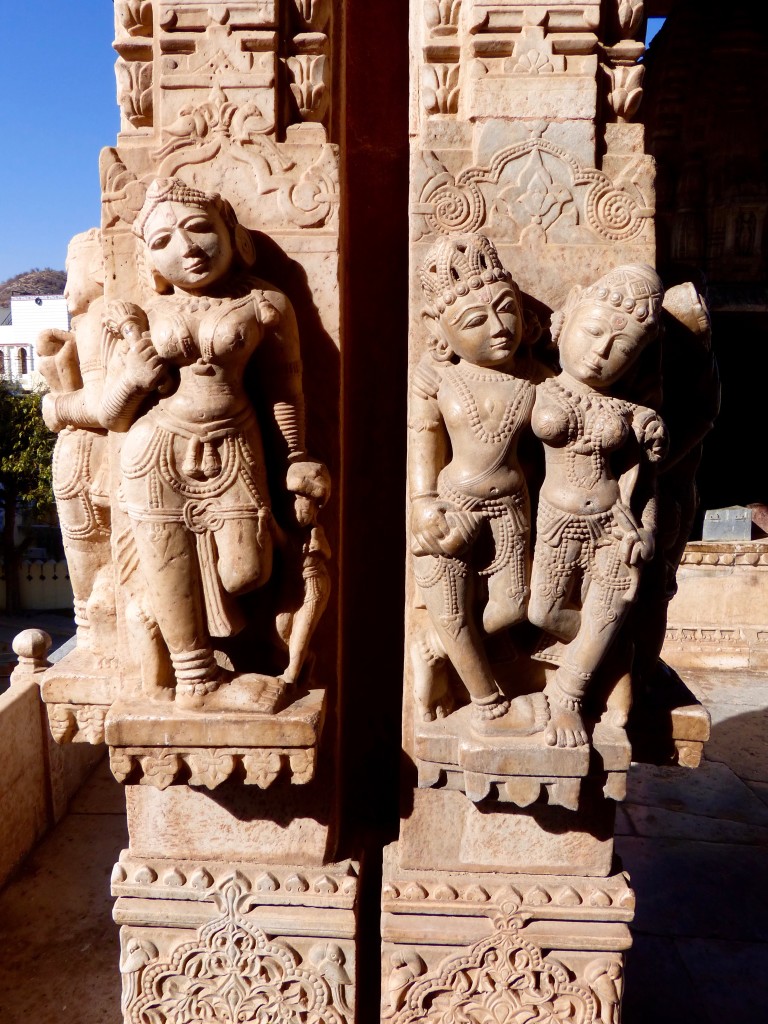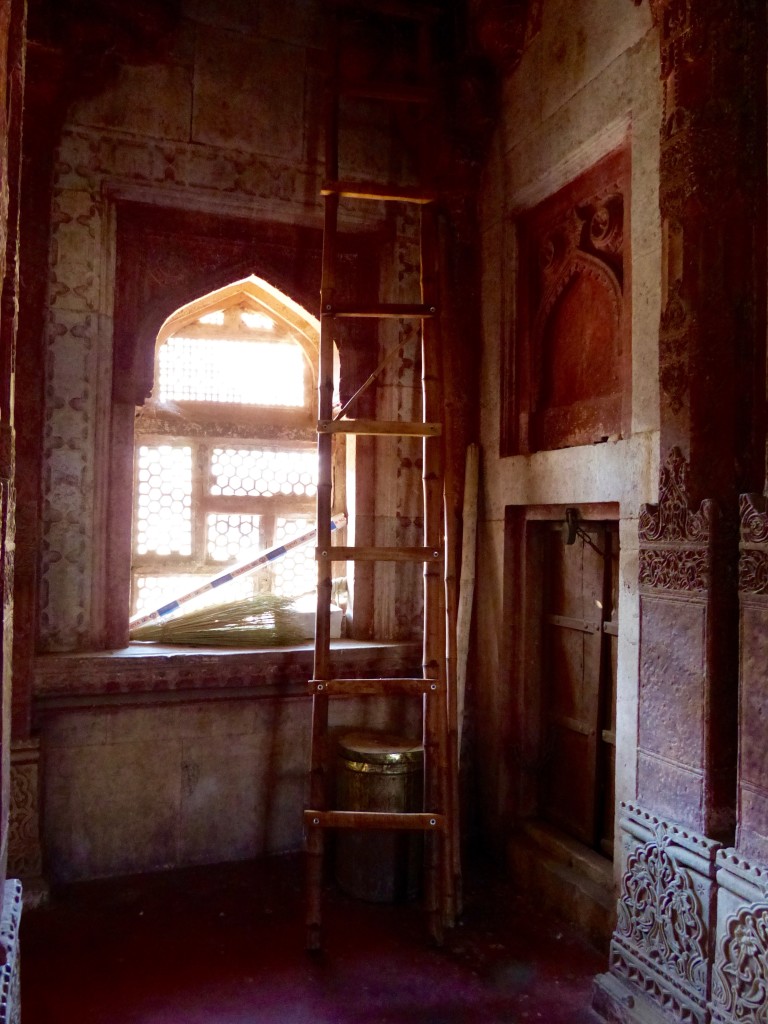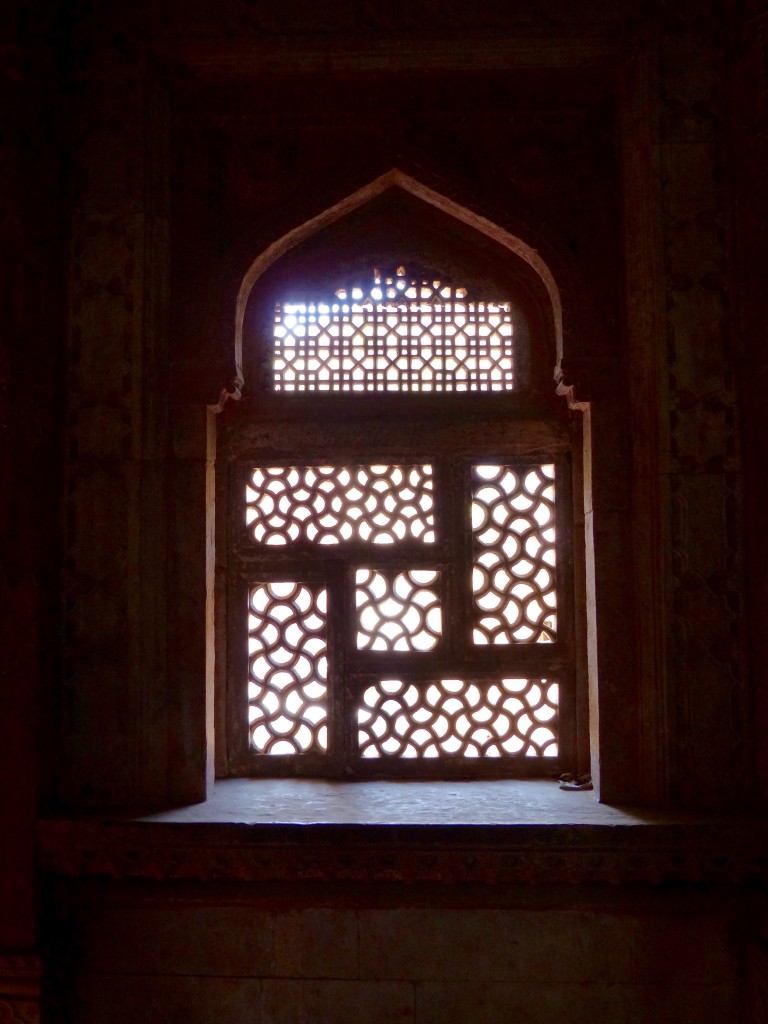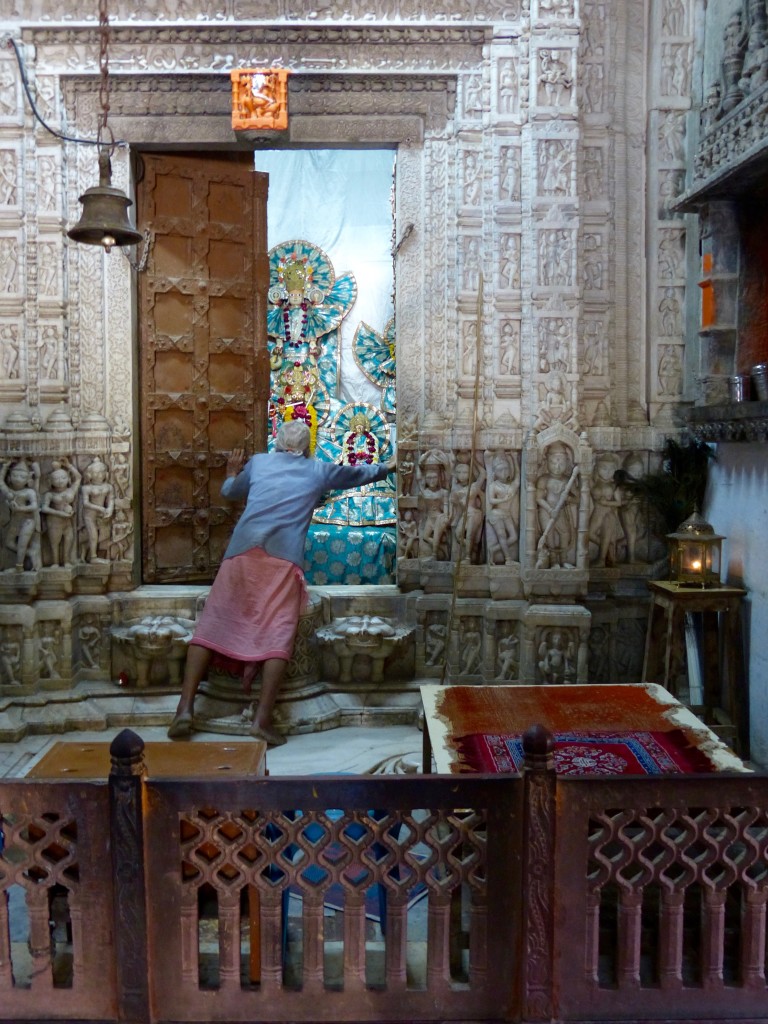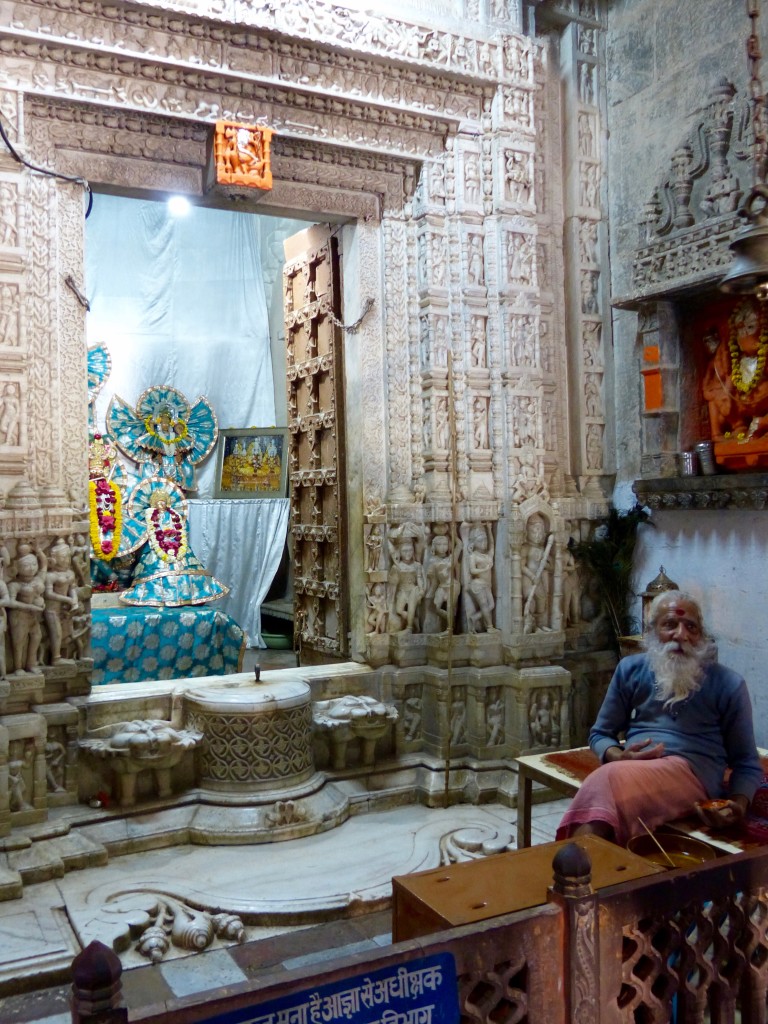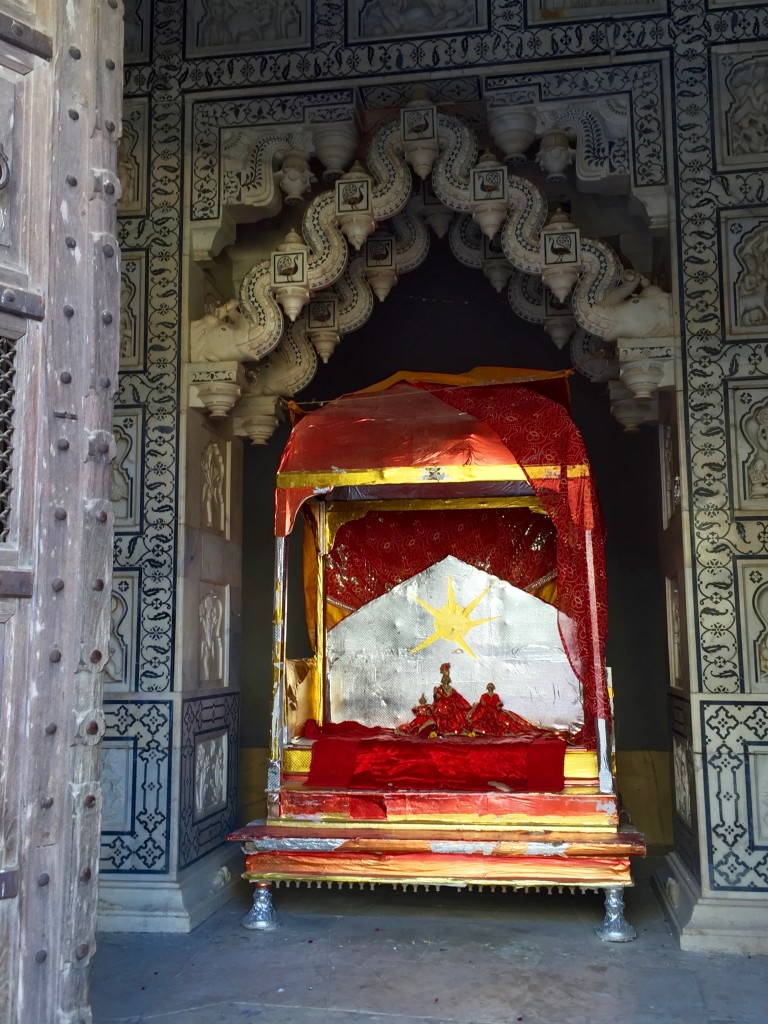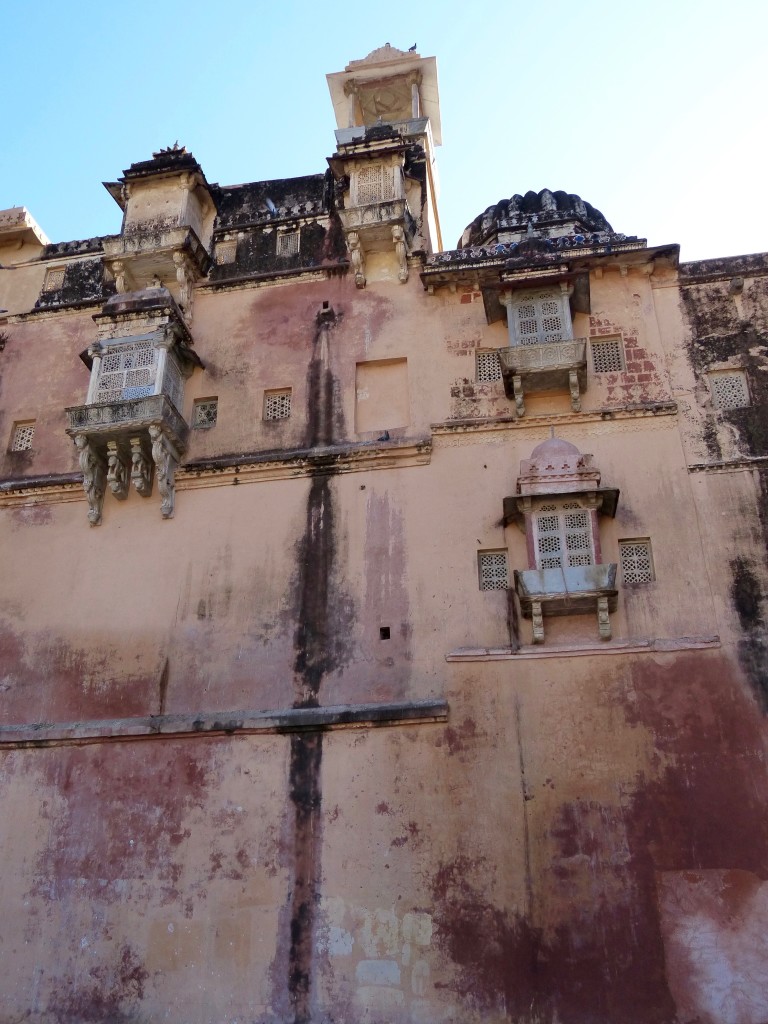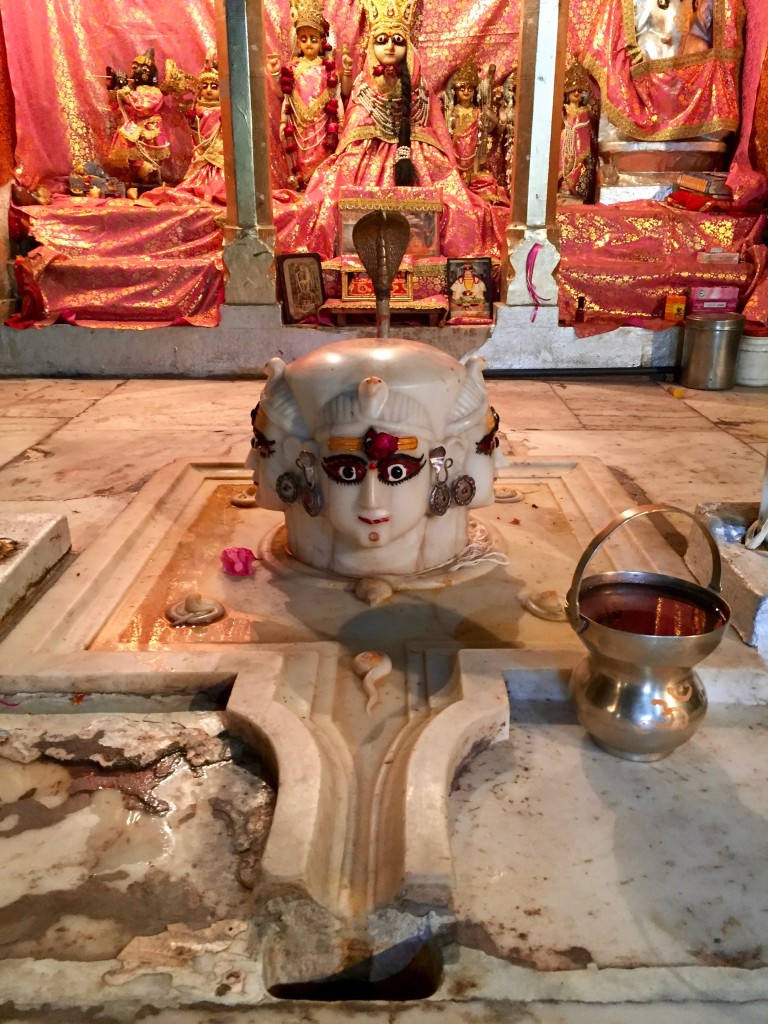Many visitors to India – especially those with limited time to explore the country – embark on a “Golden Triangle Tour.” The triangle comprises three key cities:
* Delhi, India’s capital, with ruins of seven cities dating back almost a thousand years.
* Agra, home of India’s most visited attraction, the Taj Mahal.
* Jaipur, the capital of Rajasthan, known as the “Pink City.”
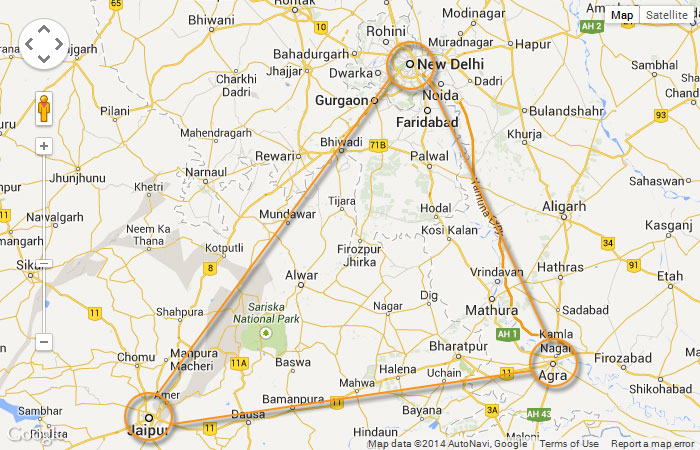
Map, courtesy of Discovery of India.
As for Delhi, I feel confident that I have sucked the marrow out of this city (although it would be impossible to see it all) after living here for almost five years. And we knocked out Agra just weeks after moving to India in 2011.
However, I never got to that last vertex on the triangle: Jaipur. In our last few months here, I am trying to cram as much India as possible into my calendar. It was beginning to look like Jaipur wouldn’t make the cut. Then I received an email from my art curator friend Himanshu, who was planning an off-the-beaten-path tour to Jaipur called Ctrl+Alt+Jaipur the weekend before my birthday. Sign me up!
Turns out my friend, Sarah, and I got an almost private tour. The only other participant was a hip young woman, Monalisa, who joined us from Mumbai. On Feb. 20, Himanshu, Sarah and I drove from Delhi, arriving in Jaipur in time for a late breakfast at our hotel. We met Mona and headed out to explore the artsy side of Jaipur.
First, we popped in to Anokhi, a popular shop that sells block-printed clothes and textiles. When I say popular, I mean it is not uncommon for teachers at our school to wear an Anokhi dress to school only to find several other teachers wearing the same fabric in a skirt or blouse. It’s gorgeous stuff, but I haven’t been inspired to join the club (except to buy the softest comfiest pajamas on earth). Himanshu brought us here to spotlight Jaipur’s rich history of blockprinting. I had always thought that involved carving a block of wood, dipping it in paint and stamping it on the fabric. Interesting … but I didn’t really get the hype.
Our next stop on Day One was AnanTaya, a “design studio committed to the development of innovative ideas through understanding the importance of preserving ancient crafts.” I could have stayed there all day. Little signs next to the products explained the significance of the crafts and their role in Indian life. We met one of the founders, Ayush, who shared his passion for supporting local artists. He doesn’t mind when they sell their products outside his shop, noting they use his designs but they have the skills to do the work. His love for Jaipur art was contagious. “We grew up with beauty,” said, recalling family conversations centered on art.
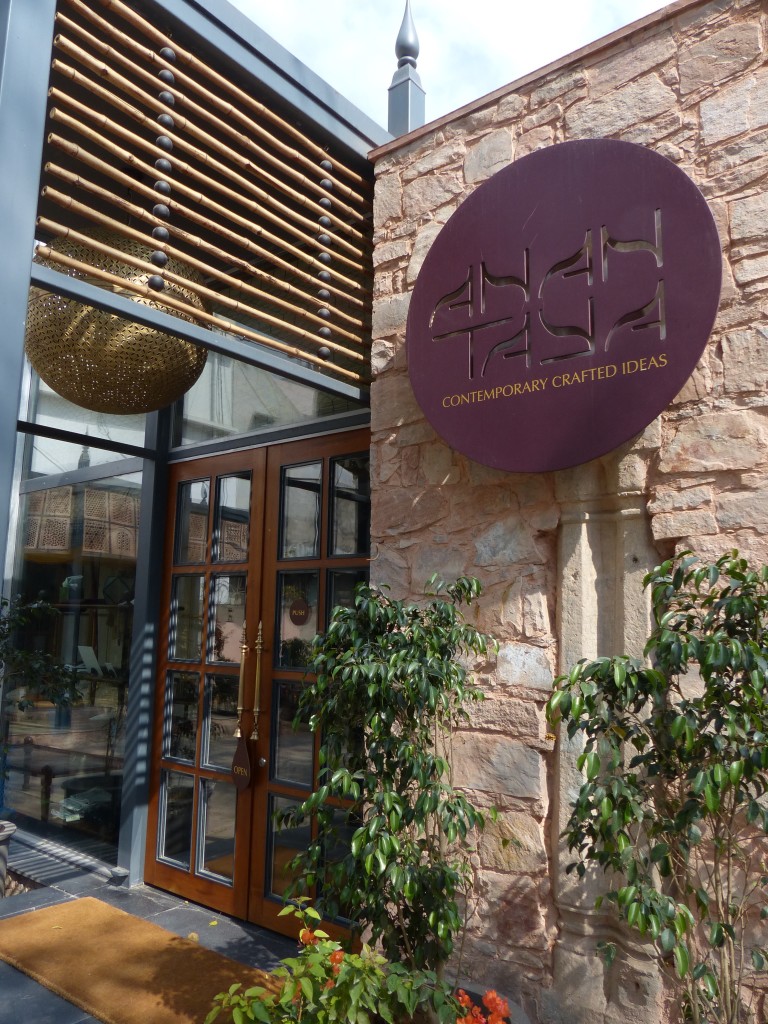
I bought these incredible brass lassi cups, handcrafted by master craftsman Mohammad Dilshad in three traditional designs. Ella approves.
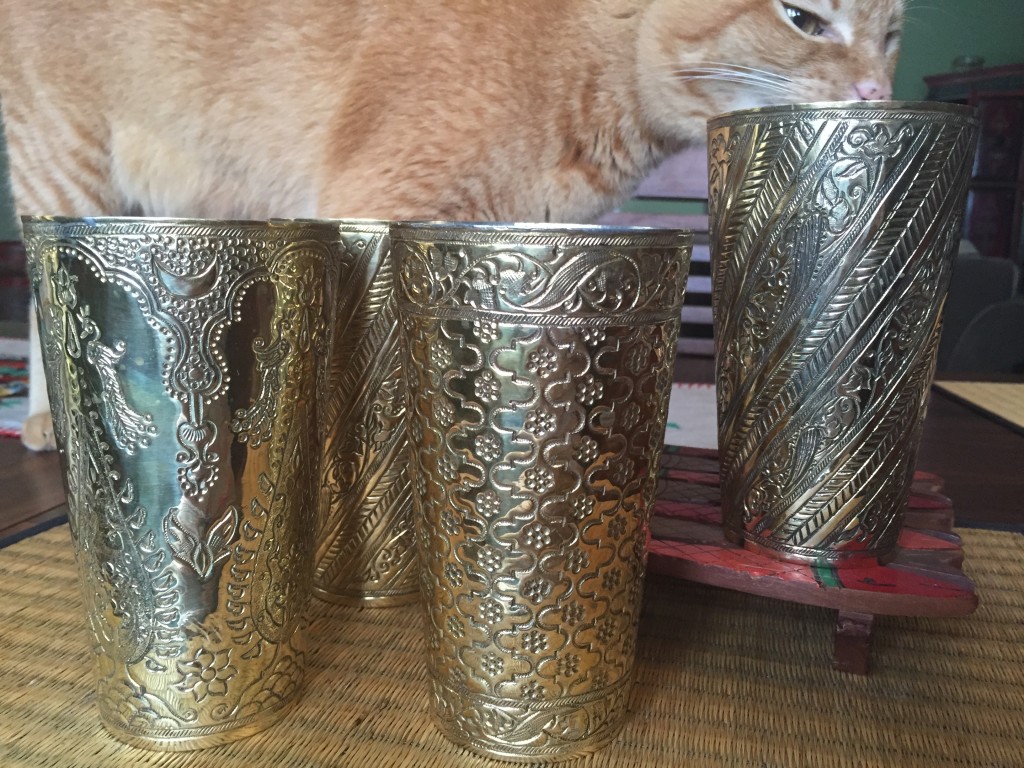
Lunch was an experience in itself. We went to a traditional Rajasthani restaurant called Laxmi Mishthan Bhandar, where I was reminded again of how my grasp of local culture remains frustratingly superficial, and my quest for deeper understanding only leads to more confusion.
The menu read, “Food which is half-cooked or halfripe, insiped, putrid, stale and polluted and which is impure too, is dear to men of a Tamasic disposition. Thus, Lord Krishna condemns unwholesome food. Instead, he recommends foods which promote longevity, intelligence, sweet, bland, substantial and naturally agreeable. LMB’s commitment to this ideal of food is a manual of faith. The food prepared in pure desi ghee suited to everyone’s palate bears out our credo.”
This is why it takes me ages to blog about my experiences in India. I get intrigued about something, spend hours researching it, discover something else I don’t understand, spend hours researching that, and finally get back to my original story. So, I got a little off task thinking about that blurb on the menu. According to wikipedia, “In the Samkhya school of philosophy, tamas (Sanskrit: तमस् tamas “darkness”) is one of the three gunas (or qualities), the other two being rajas (passion and activity) and sattva (purity, goodness). Tamas is the template for inertia or resistance to action.” Therefore, men of “Tamasic disposition” apparently eat food that makes them lazy. Who would want that? Bring on the LMB food that promotes longevity and intelligence!
OK, back to lunch … We ordered the Rajasthan thali. A thali is simply a meal comprising several small servings of various dishes. I really wanted to understand what I was eating to get the full experience, and the waiter eagerly played along. A couple times, he actually took my spoon out of my hand to demonstrate how to break off a little bit of that, add a little scoop of this combined with a dab of that, and then he would hand it back to me victoriously.
If the only word on that tray you recognized was “rice,” then here’s your guide to the thali.
Papad: a cracker made from seasoned lentil flour
Missi Roti: flat bread
Boondi Raita: sweet yogurt with little balls made from chickpea flour
Bati: fried flour balls to eat with dal and churma
Churma: made from sugar and wheat flour or chickpea flour
Dal: lentil conconction
Mishri Mawa: ethnic Jaipur dessert made from fresh reduced milk and sugar
Kair Sangri: a traditional vegetable dish combining a desert shrub berry and the bean from a flowering tree called Khejari
Aloo Gobi: a dry, spicy mix of potatoes and cauliflower
Danamethi Kishmish: sweet and sour fennel seeds with raisins
Bela Rajashasti: spicy and steamed thick chickpea-flour dumplings with whole spices cooked in yogurt gravy
Kadi Chokanwali: fried soft balls of chickpea flour with thick curry of Rajasthani herbs and yogurt
Himanshu and Sarah enjoying their thalis.
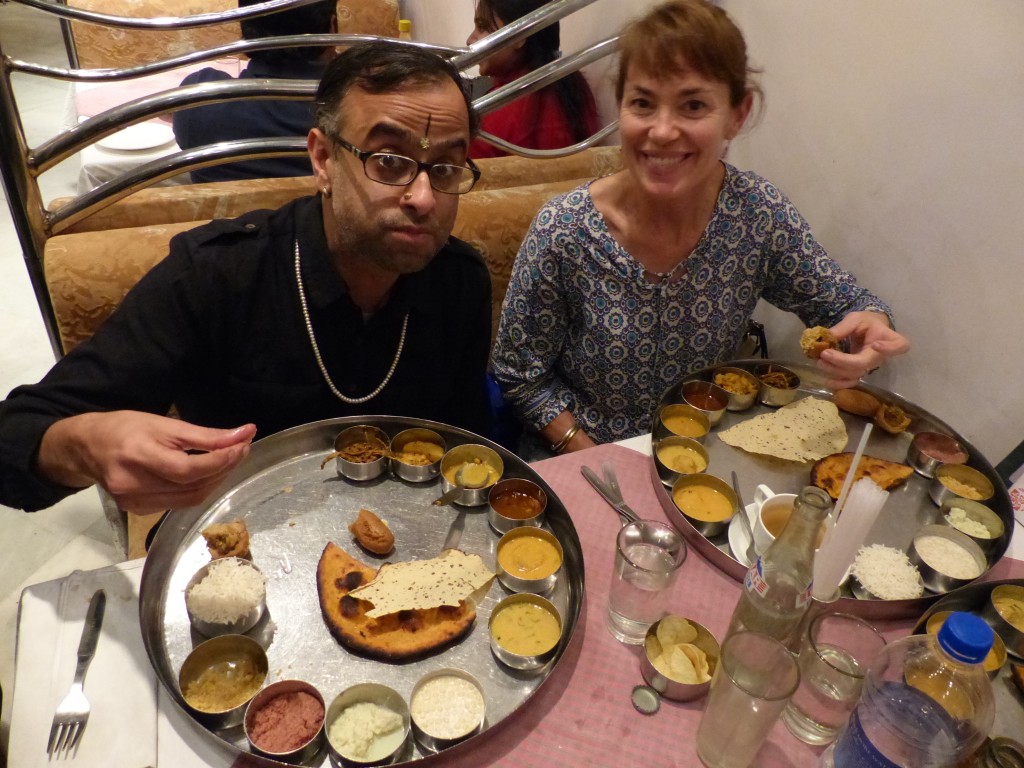
After lunch, we headed to the City Palace Museum, where Himanshu pulled some strings to get us a private tour with his friend Giles Tillotson, noted historian, author and art curator who handpicked pieces for a new museum exhibit, “Painting and Photography at the Jaipur Court.”
To be honest, I was a little starstruck in Tillotson’s presence and couldn’t focus well enough to retain much of what he shared with us. Still, his stories from behind the scenes left me enthralled.
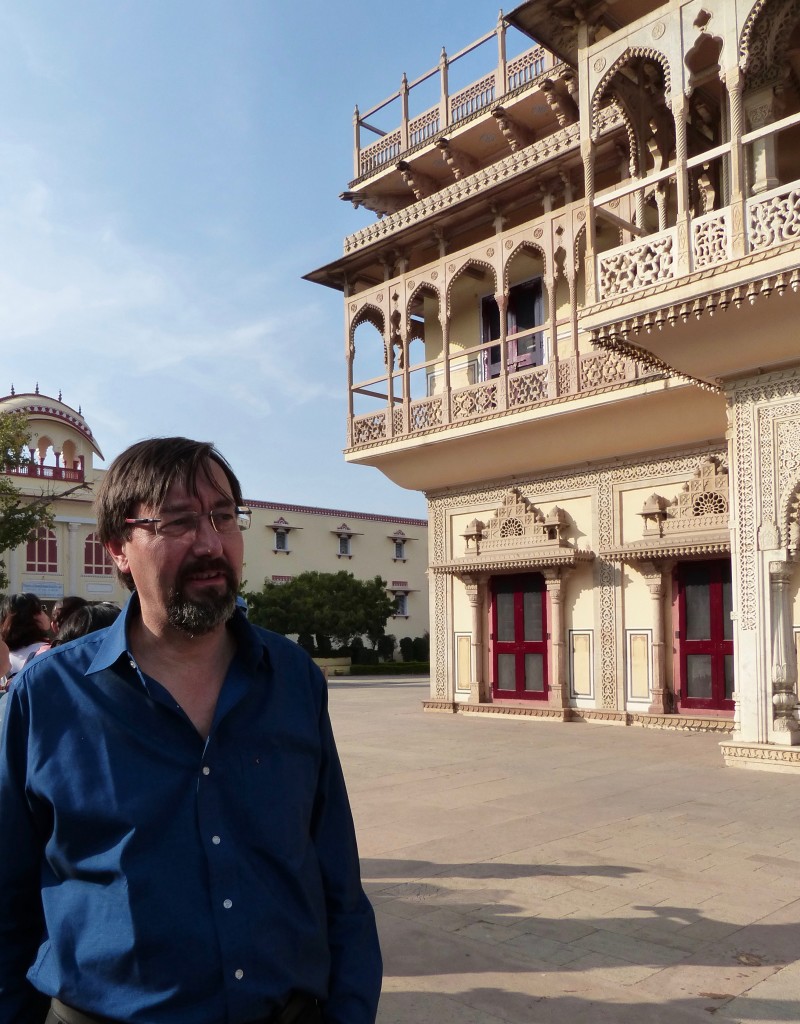
I tried to do some research when I got home. Unfortunately, I couldn’t find much more than the basic promotional materials.
I took this photo before Tillotson gently asked me not to shoot pictures in the gallery.
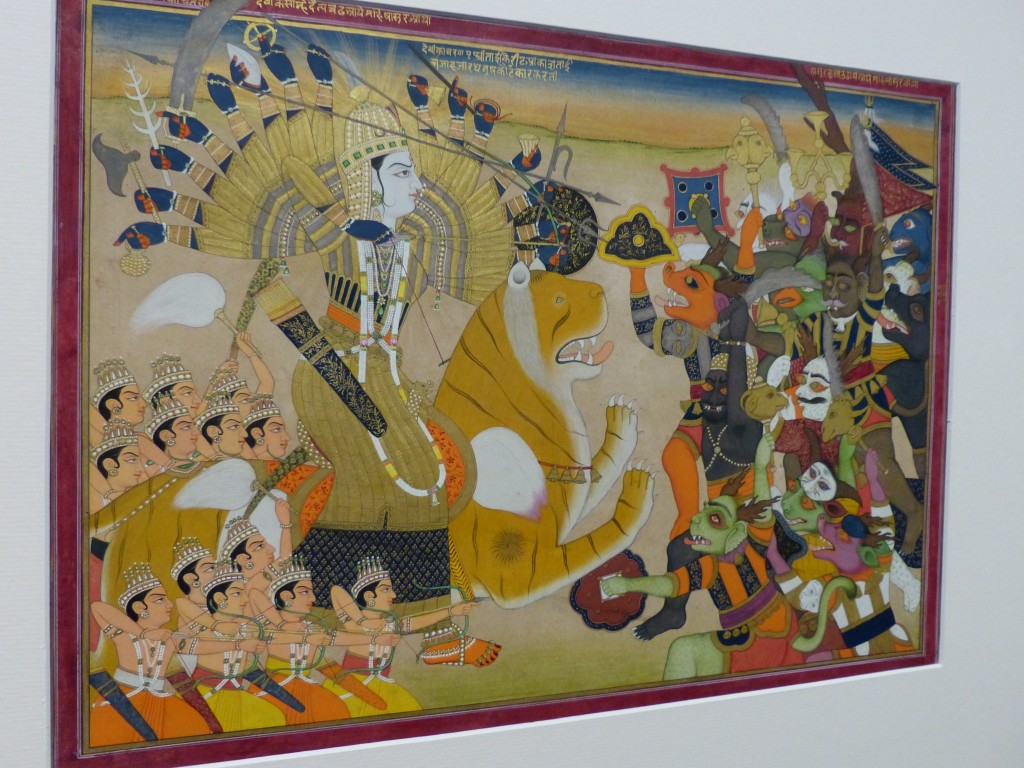
The exhibit’s brochure explains:
The display begins with paintings from the 18th century, from the period of the founder Maharaja Sawai Jai Singh II, up to that of Maharaja Sawai Pratap Singh, under whose reign painting in particular flourished. It then captures the excitement of the late 19th century when the camera competed with, but also complemented, the artist’s brush under Maharaja Sawai Ram Singh II. In the end, images leading to Indian Independence and its aftermath overseen by Maharaja Sawai Madho Singh II and Maharaja Sawai Man Singh II, bring us up to the mid-20th century.
According to an article in the Rajasthan Post from the exhibit’s September inauguration, “The photographic collections of the Maharaja Sawai Man Singh II Museum have now been catalogued and archived. They include a collection of nearly 2,000 glass plate negatives dating from the 1860s to the 1880s, from the archive of Maharaja Sawai Ram Singh II. Many of these pictures were taken by the Maharaja himself, the most famous of India’s royal photographers.”
Cameras at Court by Mrinalini Venkateswaran, projects head for Eka Archiving Services and co-curator of the exhibit, offers a wonderful glimpse into the historical context of the exhibit and breathes life into the static images in the photos.
Here’s a video from a local news channel (with really poor production quality).
Hanging around at the City Palace.
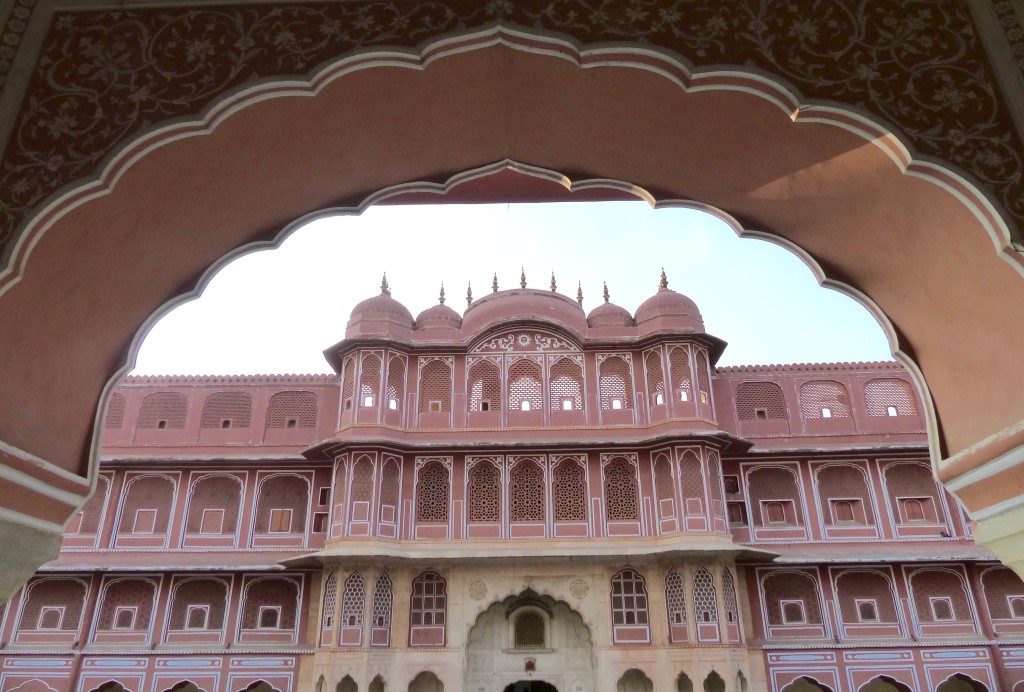
We spent the late afternoon and early evening strolling through Jaipur’s back alleys and markets. The buildings of the “Pink City” are actually more of a terracotta color, although the setting sun did create a pinkish reflection.

This guy was dying a blouse to match a sari. The shop owner asked me to mail him a copy of the photo. Done.
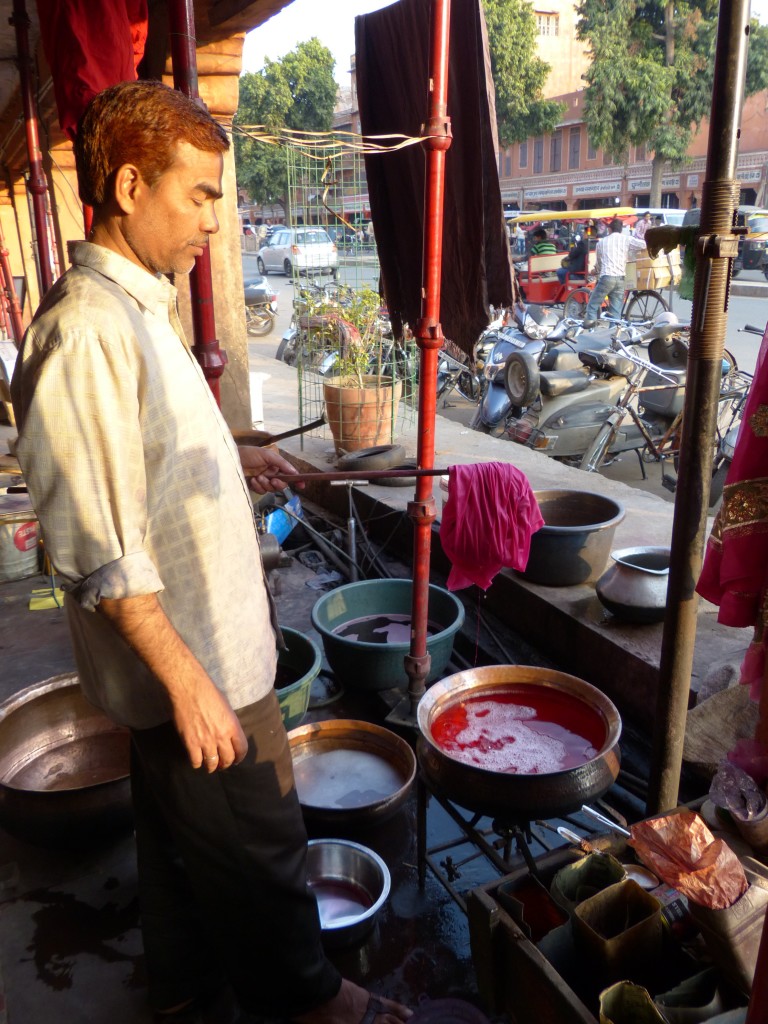
I love the chai break photo bomber.
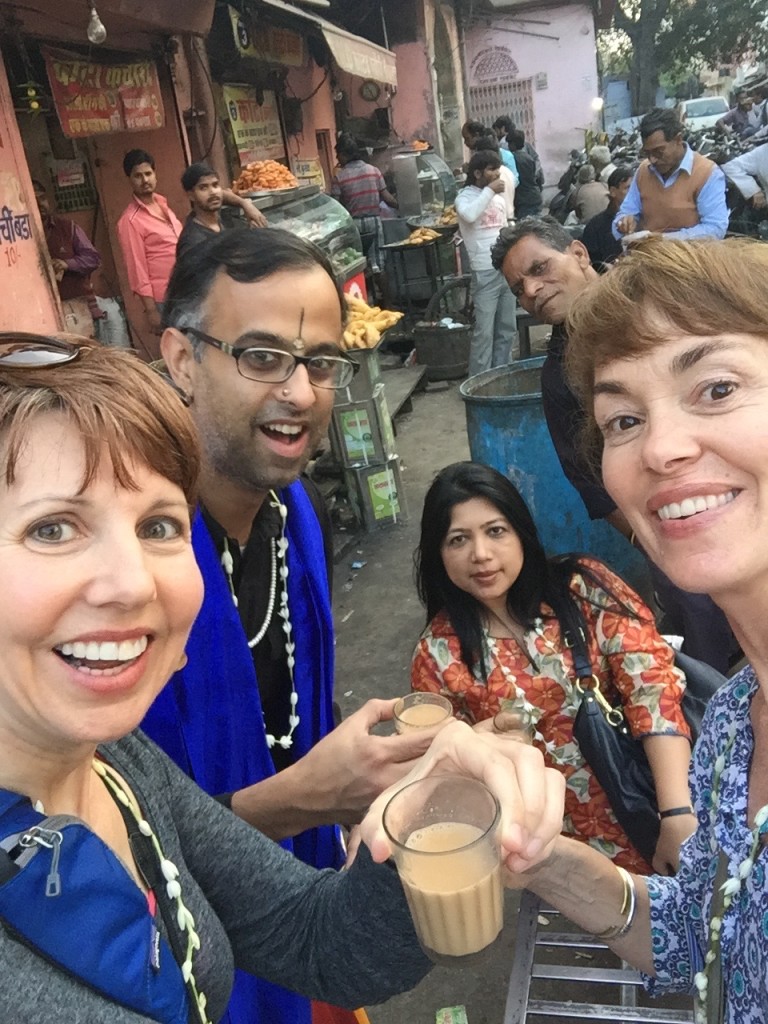
Marble sculptors. White dust filled the air and coated everything in sight. I would have liked to linger, but it was hard to breathe.
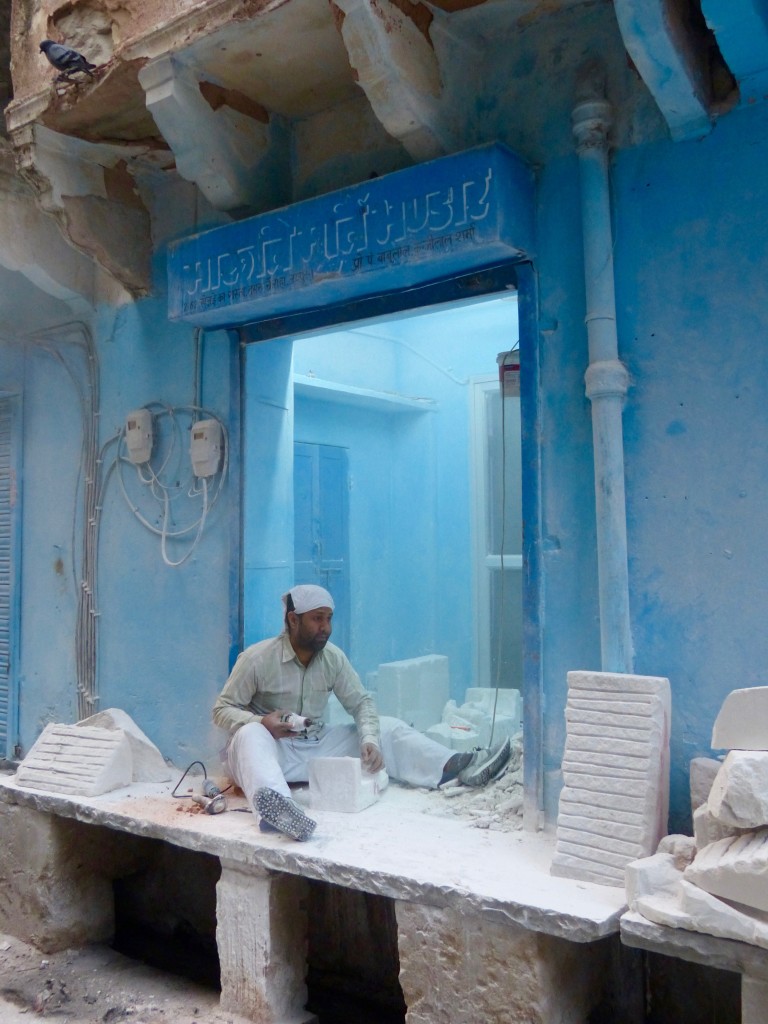
According to Discovered India, marble played a key role in Mughal art and architecture, and artists continue to ply their craft in Jaipur today.
The development of a marble structure is very delicate task and it takes a high degree of expertise and skill to carve a beautiful marble sculpture. The process starts with the selection of the right stone for carving. A carver may use his imagination to carve a figure or he might use a reference model to copy it on the stone. Mostly the artists prefer to begin with making a model of clay or wood and then try to copy it in stone.
When he is ready to carve, the artist starts with peeling off the large unwanted chunks of the stone. A long pointed and hefty chisel is used for this purpose along with a mallet. This is the roughing out stage of the stone. The strokes should be chosen very carefully as a little miscalculation can ruin the quality of the stone hence hamper the beauty of final sculpture.
Once the general shape of the structure is obtained then other tools like toothed chisel and claw chisel are used to refine the work. These tools are generally used for adding texture to the figure. Gradually the sculptor has attained the rough general shape of the final figure. Now the sculptor uses tools like rasps and riffles to enhance the shape of the figure and giving it its final form. A riffle is a steel tools used from removing excess of stone from the figure in the form of small chips and dust. The riffle is a smaller version of rasp which used for the detailing of the structure. Finally the sandpaper is used for polishing the sculpture giving it a beautiful smooth and elegant look.
The art of Jaipur marble sculpture is century’s old and transferred from one generation to another. The use of traditional tools and techniques to carve a marble stone in to a beautiful structure has preserved the heritage of this ancient art. There is a high demand for handmade Jaipur marble articles all around the world.
Himanshu took us to the shop of Avaz Mohammed, a renowned lac artist, whose family has suppled lac bangles to the City Palace for generations. Lac is a resinous secretion of insects that is harvested from tree branches and used as a plastic. Artists start with blobs of lac and soften it over a fire to mold, flatten, twist and otherwise shape it into bangles or other decorative items.
We sat on a bench smushed up to the bangle display as cargo-laden motorcycles honked and wedged pedestrians out of the way. Sarah nearly lost a leg to a slow-moving but oblivious motorbike driver. Himanshu eagerly showed us the family’s unique creation – the gulaal gota – an egg-sized bubble of lac filled with colored powder. The thin lac shell breaks on contact, showering the victim with bright powder. The artist’s family provided them to the palace for the former royal family’s Holi celebration, and now gulaal gotas are available to anyone who wants to shake up the festival of colors.
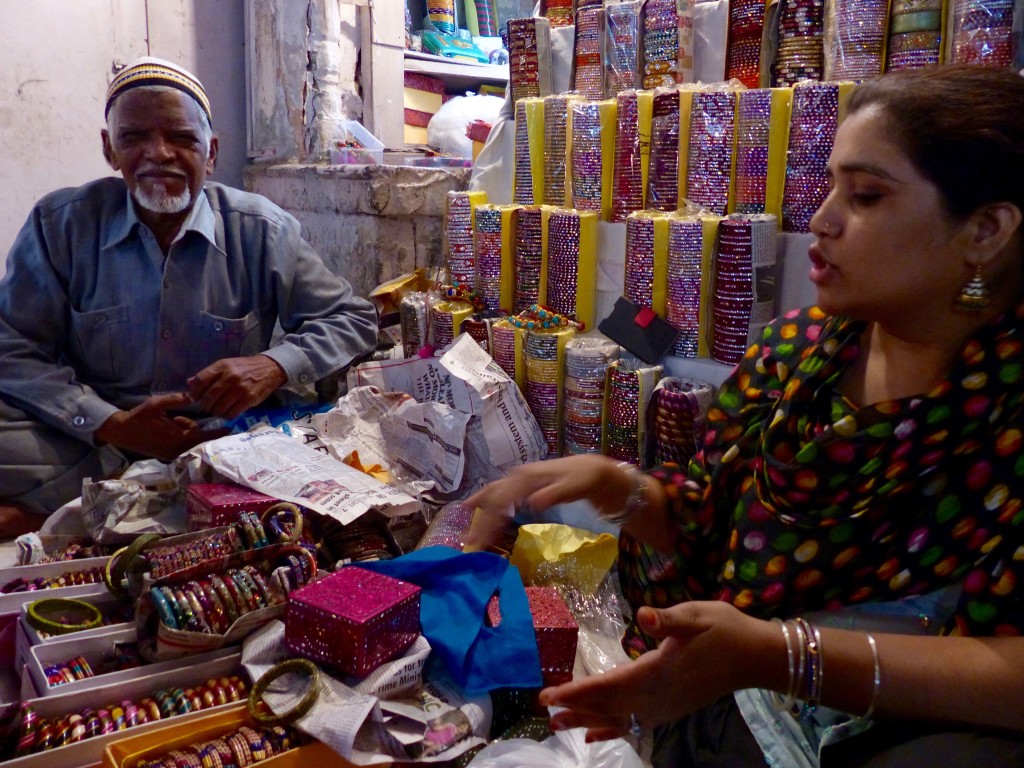
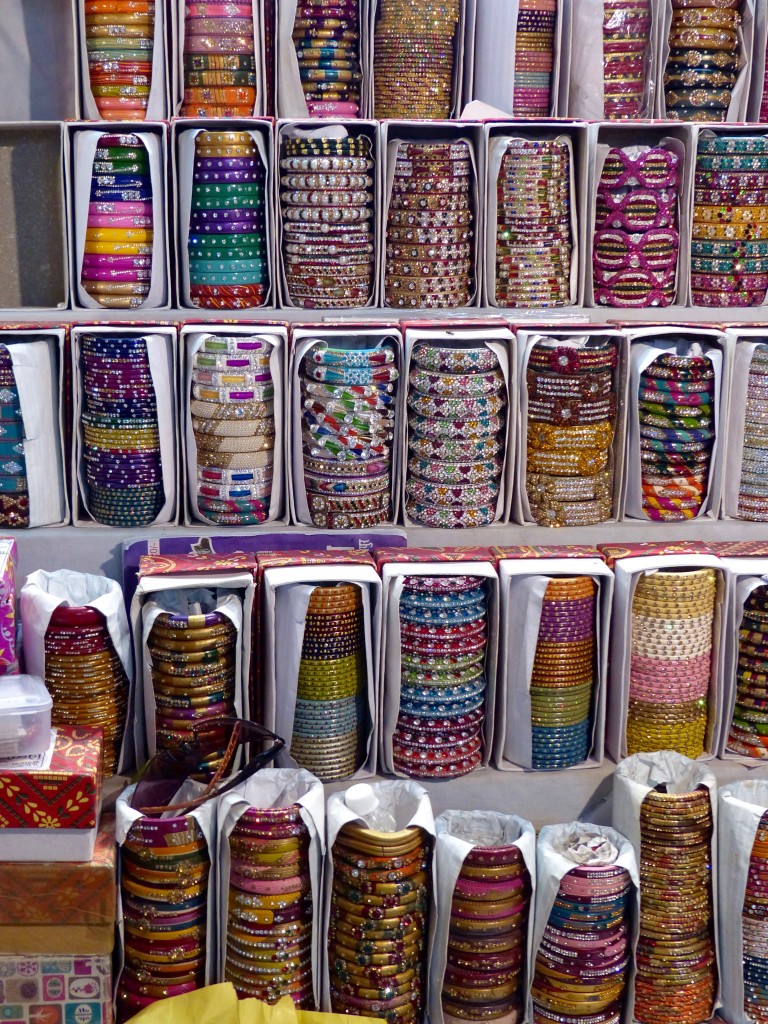
In his excitement to demonstrate this cool Holi accessory, Himanshu pitched a gulaal gota at Mona, who was wearing a gorgeous floral crepé kurta (a calf-length top, worn with leggings). The fuchsia powder coated her hair, skin and lovely outfit. I turned to Himanshu, who was poised to grab another ball, and said, “Don’t even think about it!” In retrospect, it would have been way smarter of him to pelt me in my T-shirt and jeans rather than Mona in her stylish ensemble. Mona was a good sport. I think I would have cried.
After a quick pause for coal-fired chai, we were getting tired and decided to abandon some of the destinations on our itinerary.
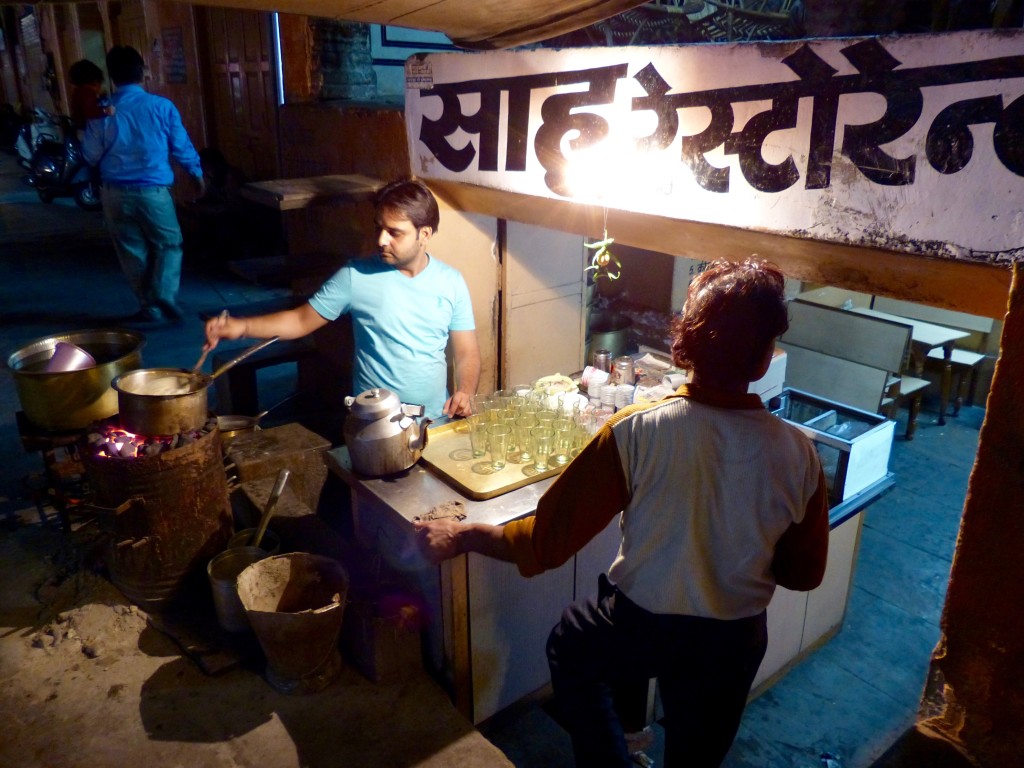
Our last stop for the day was Govind Dev Temple. Steep learning curve. Are you ready? I’m summarizing a very enlightening article called Vrindavan Deities in Jaipur.
Here goes:
Vrindavan is the childhood home of Lord Krishna and thus a sacred site for Hindus. In 1669, temple priests at Vrindavan got the horrifying news that Emperor Aurangzeb was planning to invade the temples and destroy the sacred murtis (idols) of Krisha. The priests fled with the murtis, traveling at night and taking refuge in caves during the day. Five murtis ultimately found safety in Jaipur, although one was later moved to another city. Those four Jaipur murtis each have their own temple now, and we visited all of them.
There’s so much more, but this blog post is already insanely long, and we’re only at the end of Day 1. I just have to say that article was reassuring in that it was written by a South Indian Hindu, who expressed confusion over this complicated North Indian story. “The problem with a polytheistic religion like Hinduism is that it is hard to keep track of its regional, and rather glorious, variations,” he wrote. Yeah. Imagine how a third-culture kid brought up in a military household with a Protestant value system might struggle to understand this stuff.
The Govind Dev Temple was constructed on the City Palace grounds in 1735, offering the maharaja a clear view of the Krishna worshippers. When we arrived, it was mostly deserted, but soon crowds filled the space, sitting on the mats or standing around the perimeter. A metal fence surrounded a sort of stage with a heavy curtain and locked gate hiding the Krishna murti. Eventually, the temple priest unlocked the gate and pulled back the curtain to reveal the murti. We all crowded to the front. A long bout of bell ringing and chanting ensued, including the catchy “Hare Krishna” chant. Priests then walked along the inside of the fenced area, sprinkling water out on the crowd. People were grinning and raising their hands in the air, exultantly. Finally, we joined the rest of the crowd to walk clockwise around the temple before reclaiming our shoes and heading out. Surprisingly awesome.
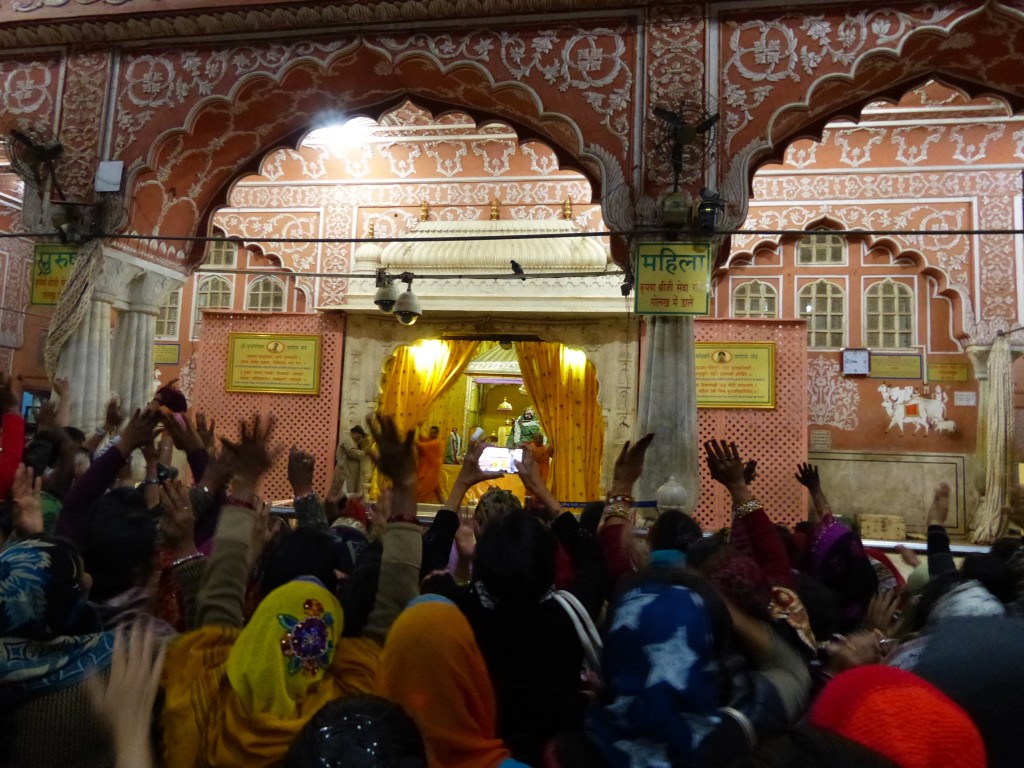
The next day, we visited the other three Krishna temples with murtis from Vrindavan.
Gopinath Temple
Unfortunately, the gate to the murti was locked, and we would have had to wait too long to see it opened. However, the temple was interesting in itself with ornate paintings and tiles throughout and a bonus Hanuman temple adjoining the courtyard.
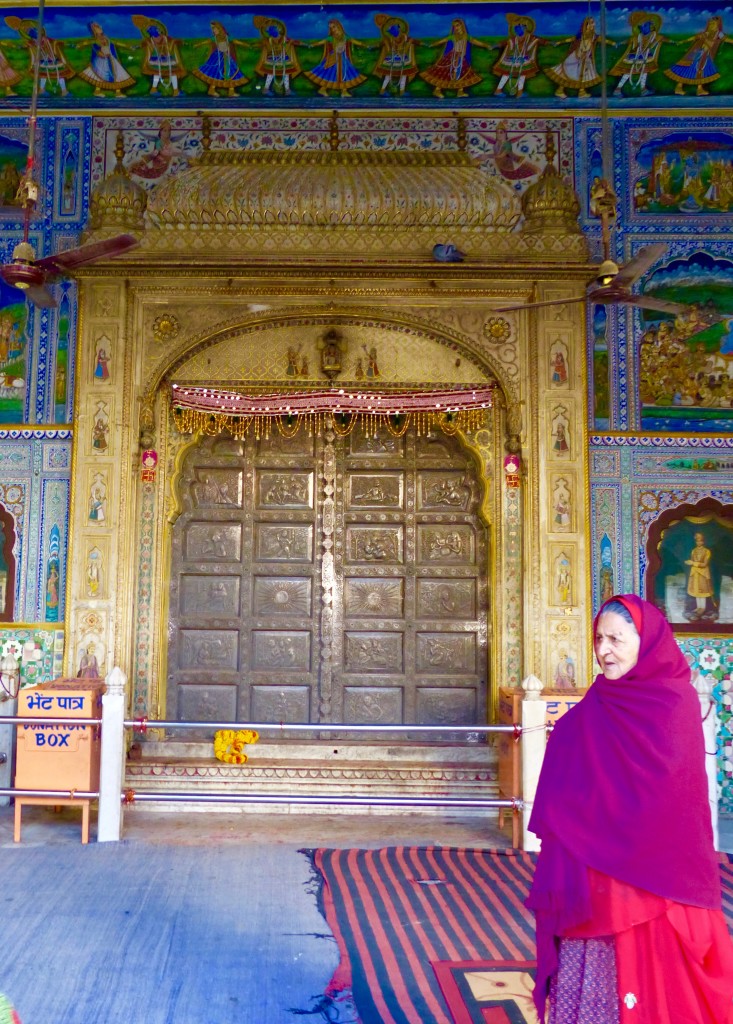
Radha-Damodar Temple
Less ornate, this temple was busy with worshippers circumambulating (walking the perimeter clockwise repeatedly) and pausing to bow to the murti.
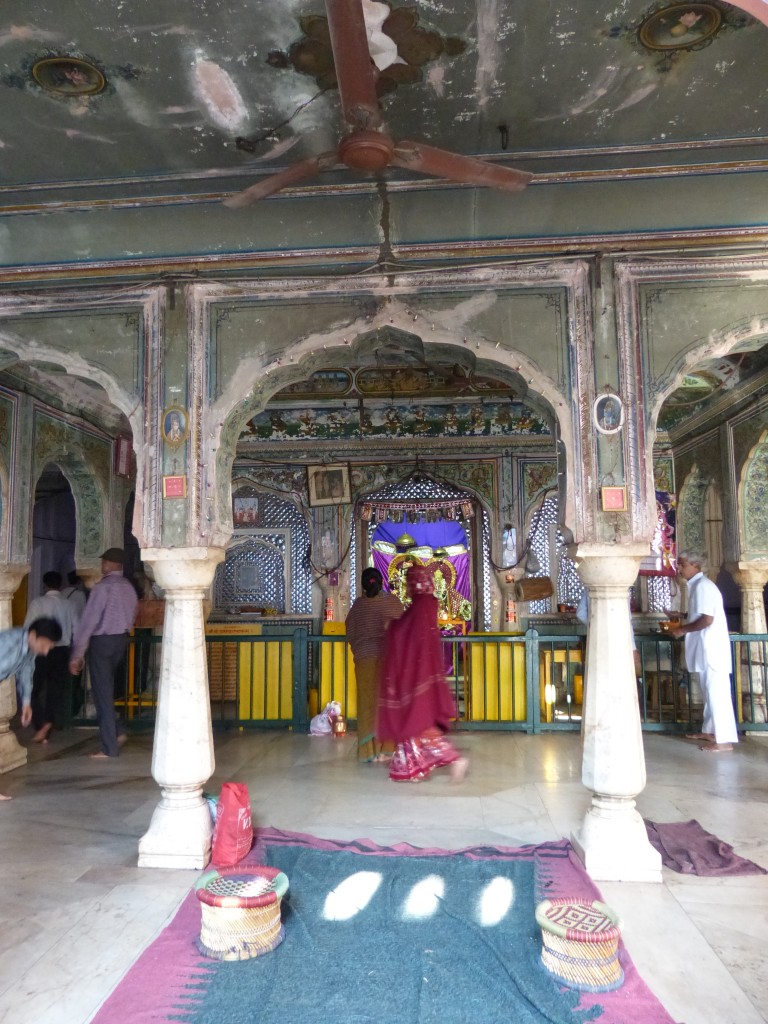
Vinodilal Temple
In this austere temple, the priest was busy with ceremonial duties. He asked us not to photograph the murti.
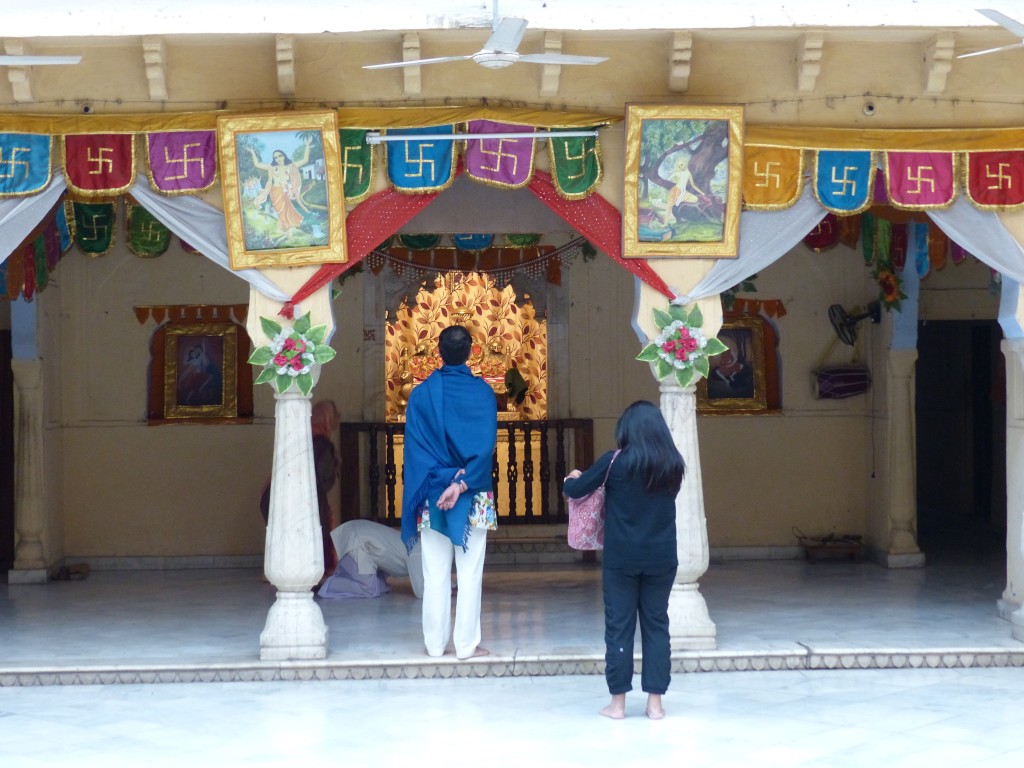
And that was just the beginning of our temple trek.
Surya Mandir
Dedicated to the sun god, Surya Mandir reaches up to the sky from its perch on a rocky hill, 200 meters above the city. From there, we could see the grid pattern of city streets, the result of 17th-century city planning. Energized by the sun (or maybe the sun god?), we played in the courtyard a bit, posing and enjoying the views. It was easy to imagine the city’s founder, Maharaja Jai Singh II, coming up here to soak up some rays and find a little peace.
Approaching the temple. Cows, monkeys, and pigs. Oh, my!
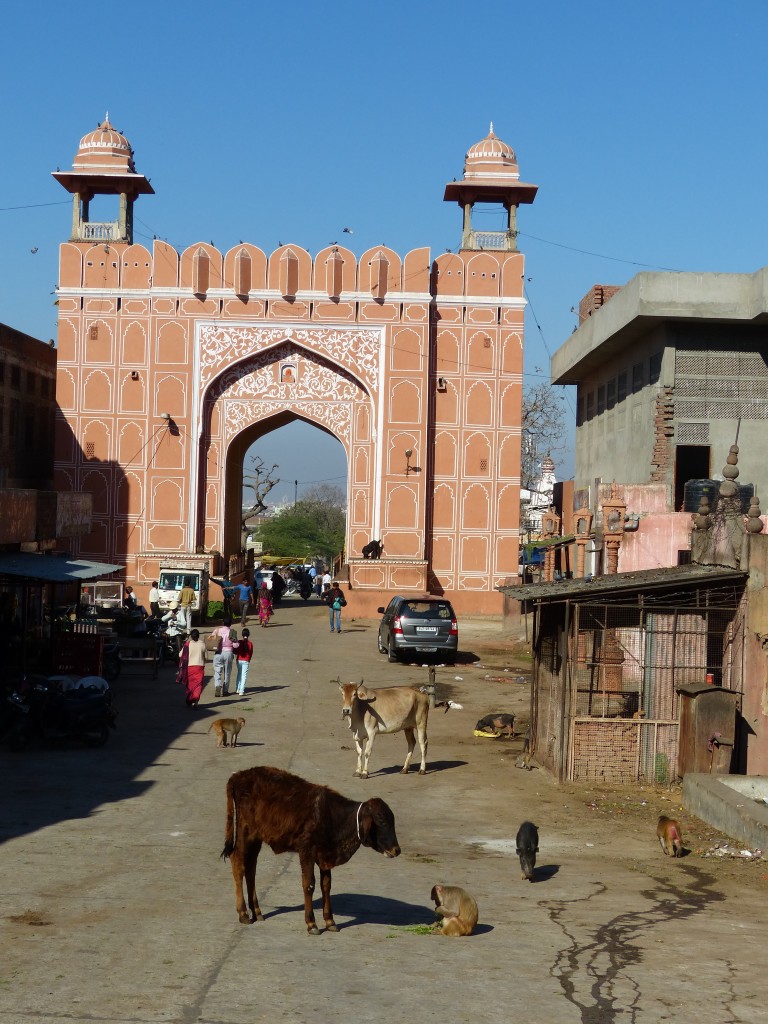
Hindus ring a bell or ghanta when they enter a temple. I’ve read a few different reasons: The “om” sound invites the deity to be worshipped. The reverberation clears your mind to receive enlightenment. The sound scares away evil spirits.
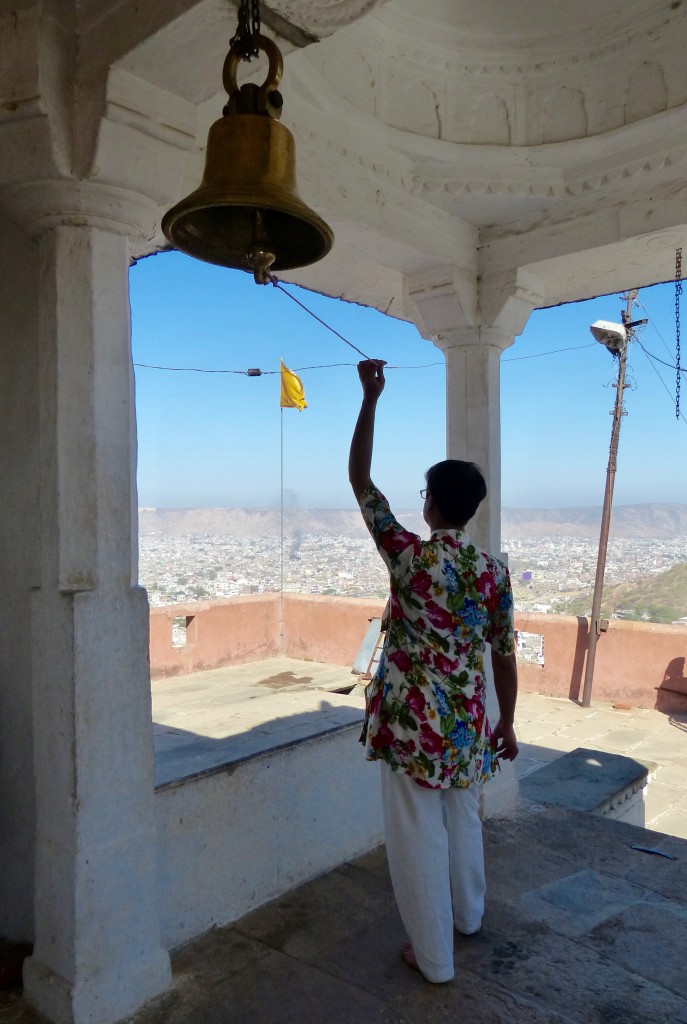
You don’t have to twist my arm to worship Surya. Sunny days and blue skies fill my soul.

I have to be honest. By now, I was pretty templed out. When Himanshu said we had one more to see before we headed to our next destination – and especially when he said it was called “the monkey temple” – I was like, “Let’s skip it.” But thank goodness we didn’t!
Galta Temple
Yes, there were hordes of monkeys, but they were surprisingly respectful (which is not a typical monkey trait, fyi). We walked down a steep rocky path from the Surya Mandir and then climbed a few steps into the top structure of an expansive temple complex that stretched down the hillside.
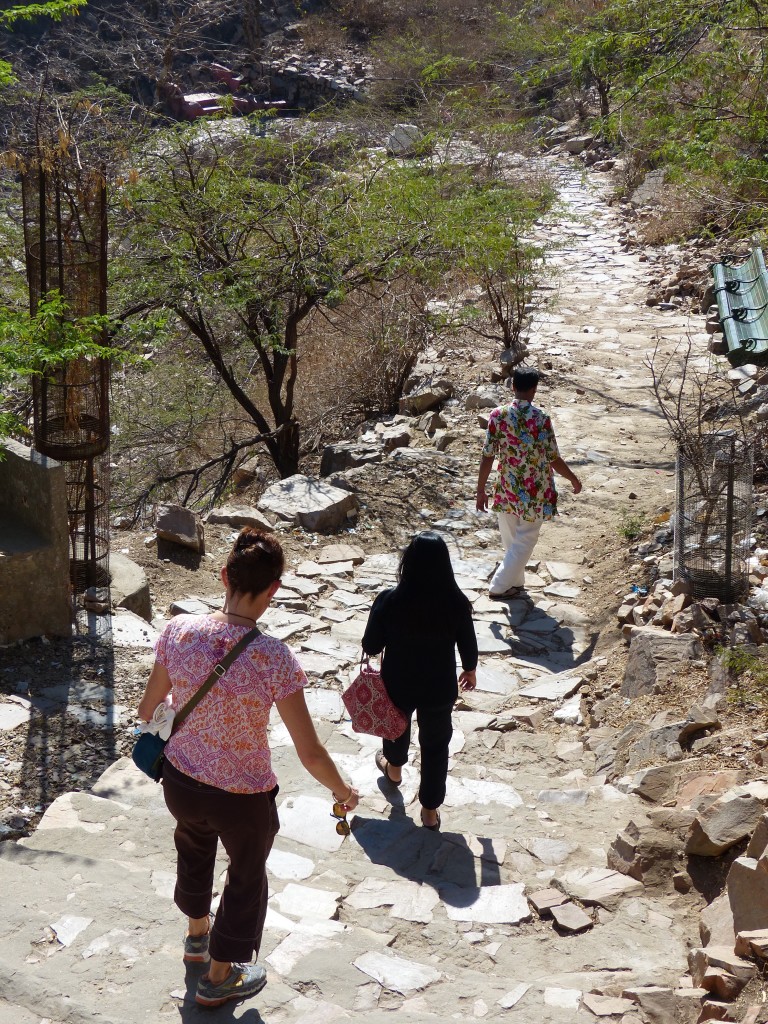
A group crowded in front of the shrine, while others lingered around the pool of water a few feet below. As we walked down, we saw three spring-fed pools: one for monkeys, one for men, and one for women. My mind almost couldn’t process the view. Buildings designed in the style of a palace or haveli were cradled in a mountain pass of the Aravelli Hills and crawling with smiling pilgrims in their eye-popping colorful saris and suits. This site has been a Hindu retreat since the early 16th century, but the Galta Temple complex was built about 200 years later.
This couple asked me to take their photo and text it to them. Why not?
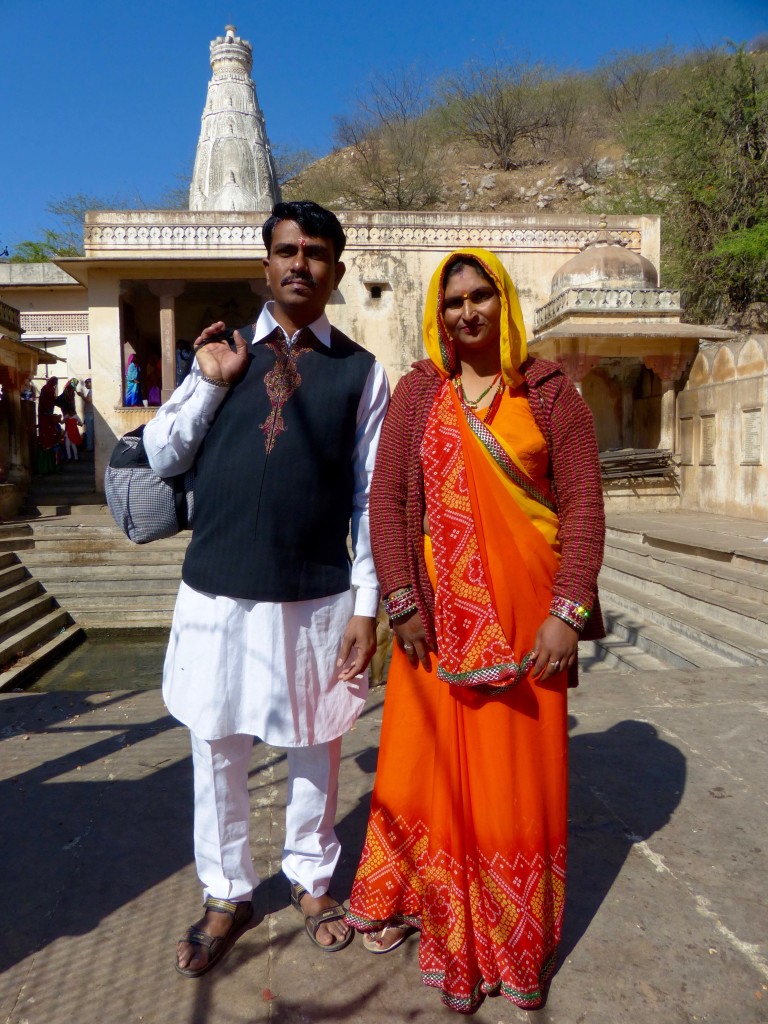
Brilliant frescoes once greeted temple visitors, but time, weather, and vandals have taken a toll.
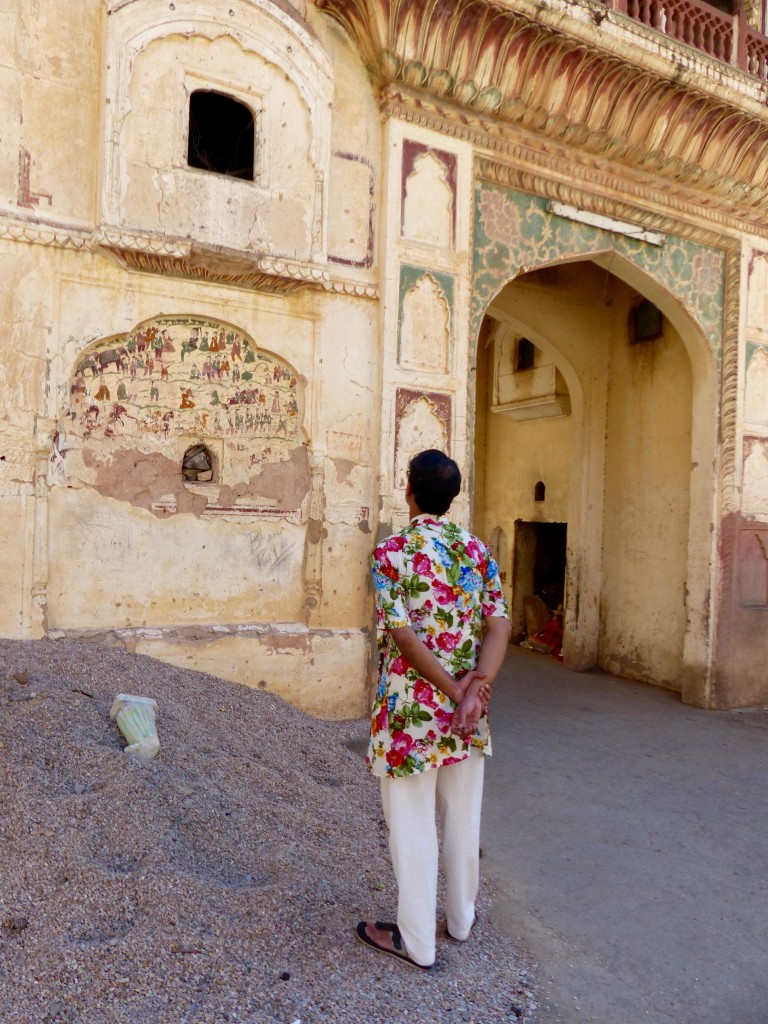
This woman asked for 10 rupees (15 cents) to snap her photo. Savvy lady, posing in an irresistible archway in that pink sari.
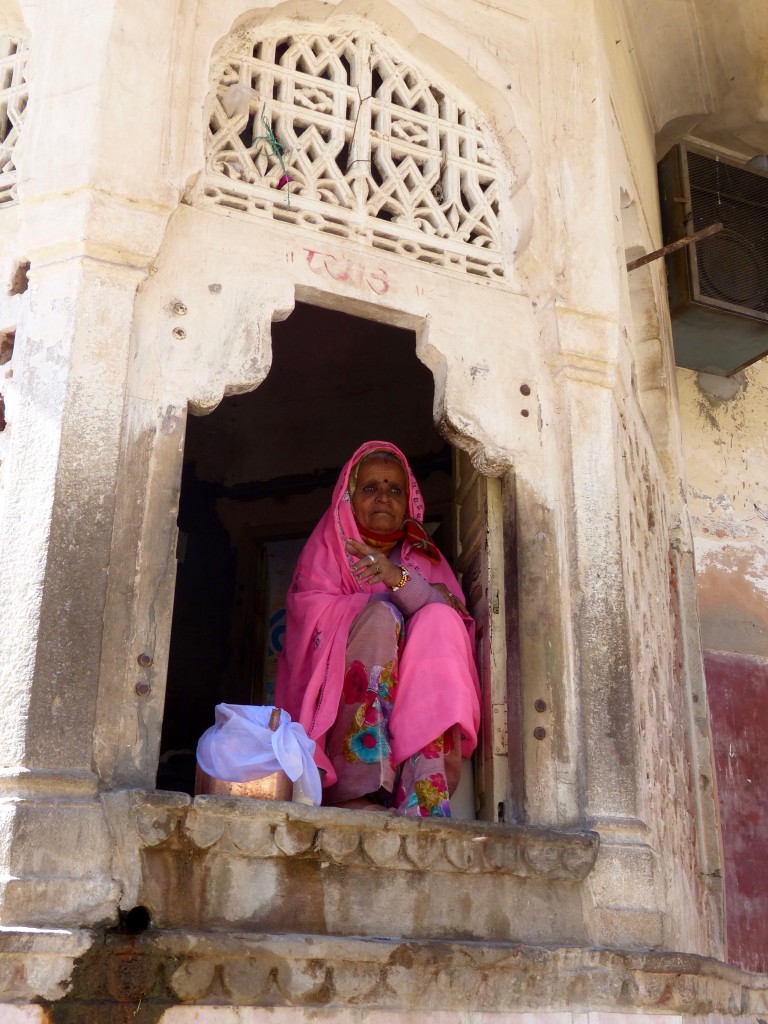
These ladies were laughing and singing and happily posed for me, free of charge.
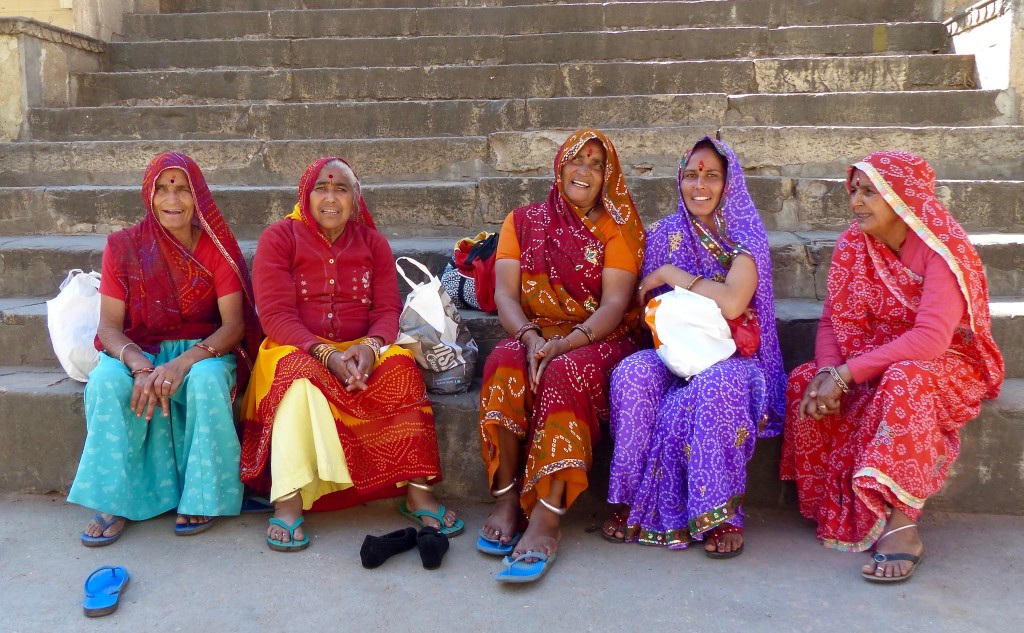
My girl, Saraswati, the goddess of knowledge and education, tucked away in a little nook.
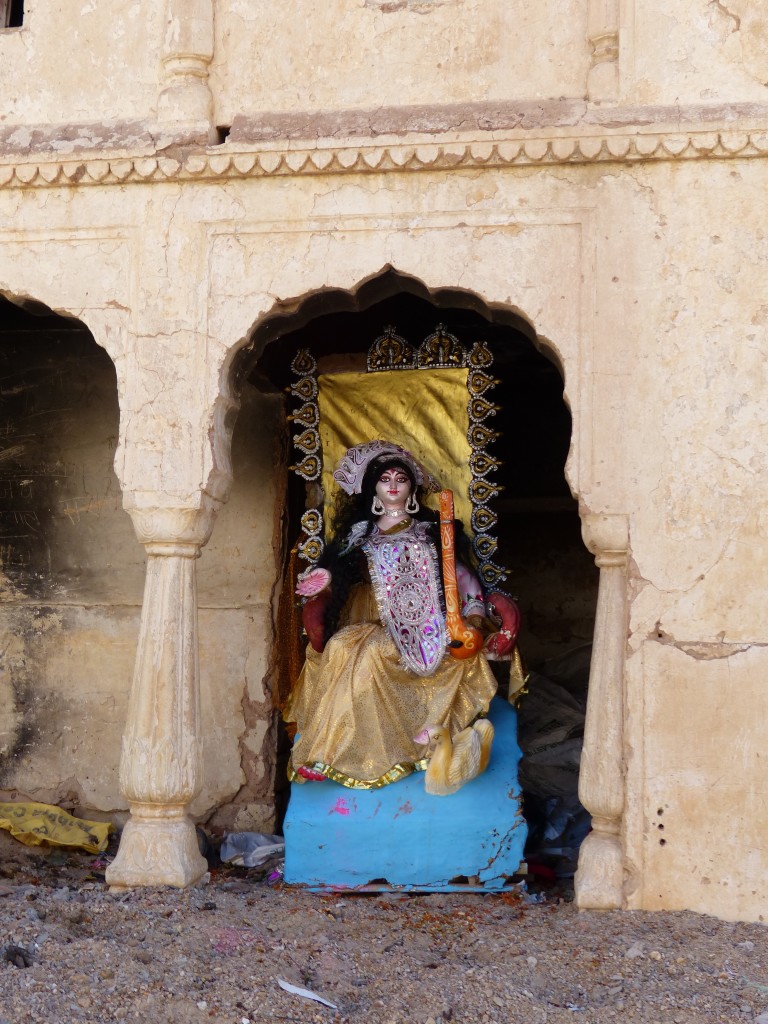
On to Amer…
From Jaipur, we drove to the village of Amer, which sits in the shadow of the imposing Amber Fort high on the hillside. Here’s the scoop on Amer, also known as Amber, from the Rajasthan Department of Tourism.
Amber, lying 11 kilometres north of Jaipur, is a remarkable conglomeration of royal palaces, robust forts, princely havelis, residences, gardens, temples, lakes and other ancient buildings. The history of the city dates back to the 10th century, when it was founded by Mina tribesmen. The Kachchwaha Rajputs conquered this region, known as Dhoondhar in ancient times, in the early 11th century, owing to its great strategic value. Dulha Rai, the first Kachchwaha king of Dhoondhar, made Dausa, a small town near Amber, his first capital. The territory kept growing through military expeditions or political alliances. The Kachchwahas laid the foundation of the fortified walls of Amber, established the Kakilgarh fort and built Ambikeshwar Mahadev Temple. Amber became the third capital of the Kachchwaha, and remained so for almost seven centuries. The rulers kept expanding the city by building palaces and temples of Vishnu and Shiva. The period from late 16th to early 18th century under the reign of Man Singh and Raja Jai Singh I and Jai Singh II is considered the golden period of Amber. A significant contribution to the art, architecture, science and financial wealth of the city was made under their rule. After independence, Dhoondhar kingdom was merged with the state of Rajasthan and Amber became a part of Jaipur district.
Here, we visited the Anokhi Museum to learn more about block printing. Remember my apathetic attitude toward Anokhi’s block printed clothing? Well, that has changed now that I have learned more about the process. Watching an artist carve a wooden block blew my mind, and the skill required to print evenly and efficiently is ridiculous. Plus, it’s not just dip-and-stamp, dip-and-stamp. Holy cow, it’s way more complicated and fascinating.
This is a short and informative video by geobeats that captures what we saw at the museum.
This display explained a 14-step process from plain cloth to printed fabric.

I could have watched this guy for hours. It was mesmerizing. I knew the fabric was printed by hand, but the blocks are also carved by hand using primitive tools.
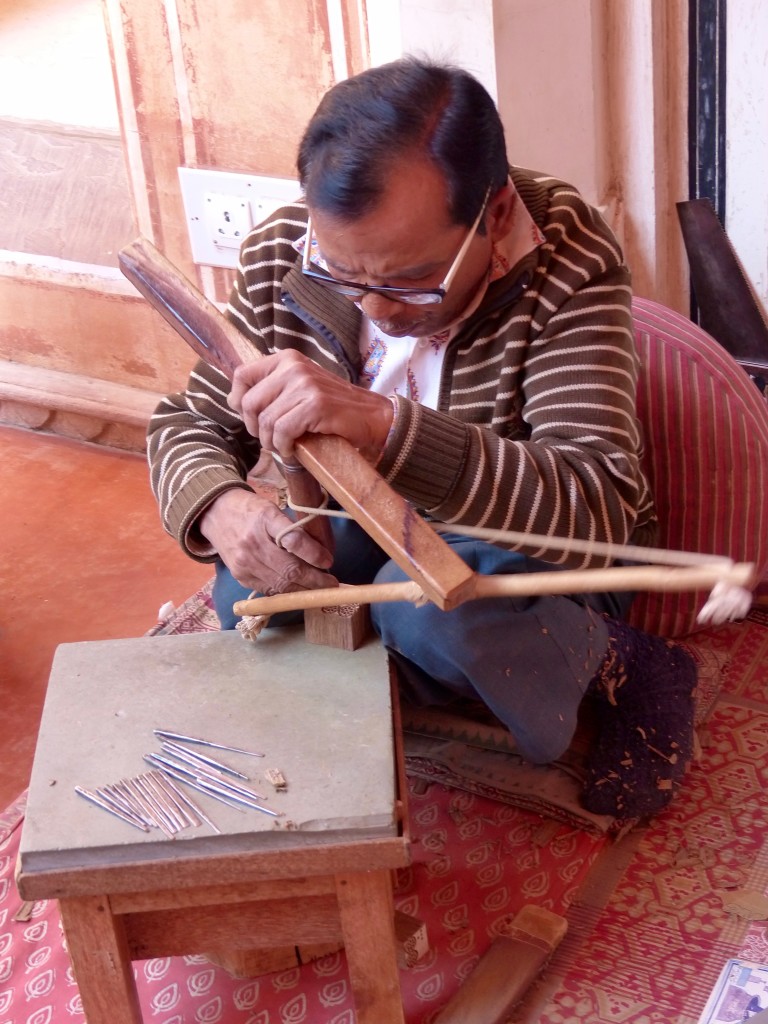
He had to carve four blocks to make one pattern.
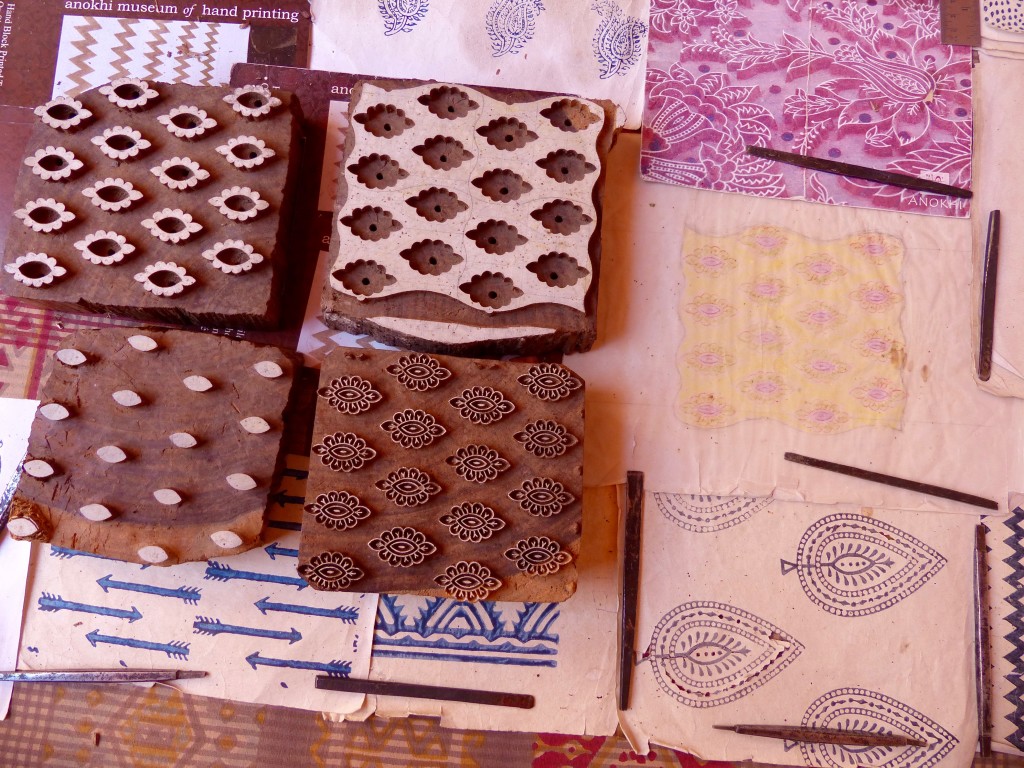
I never really thought about how hard it would be to line up the patterns or to place the blocks just right to deposit color exactly the same way across yards of fabric.
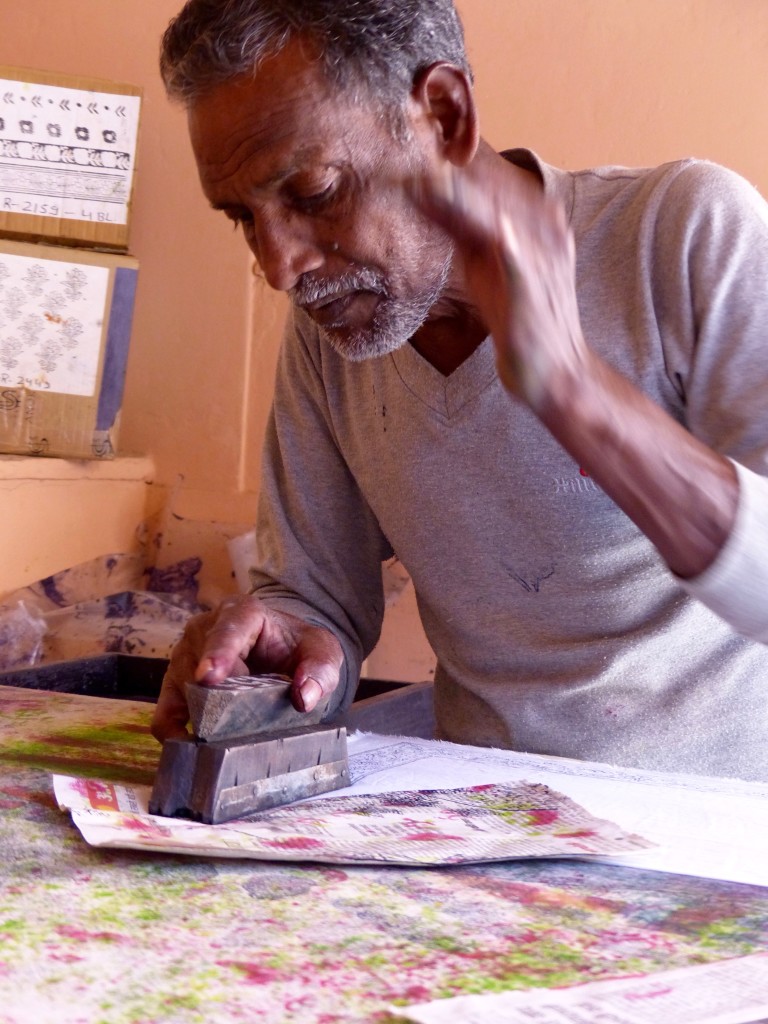
Well, I’m a convert to the cult of Anokhi, and I feel grateful for this new knowledge and appreciation for the art of block printing.
Next, Vineet Sharma, banker turned tour guide, met us at for a stroll through the village of Amer.
Just a few steps from the museum was our first stop: the Panna Meena ka Kund, a 16th-century stepwell or baoli. Stepwells provided water to the community, but also served as a marketplace, entertainment venue, and hangout spot.
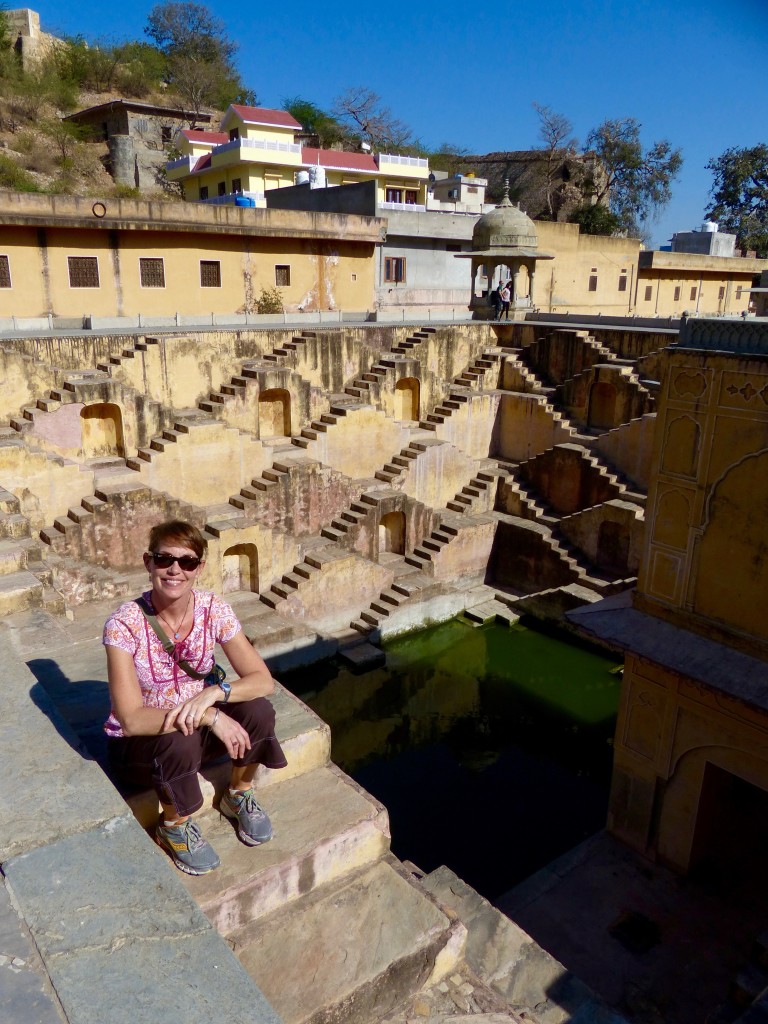
Just across the alley sits the Ambikeshwar Mahadev Temple.
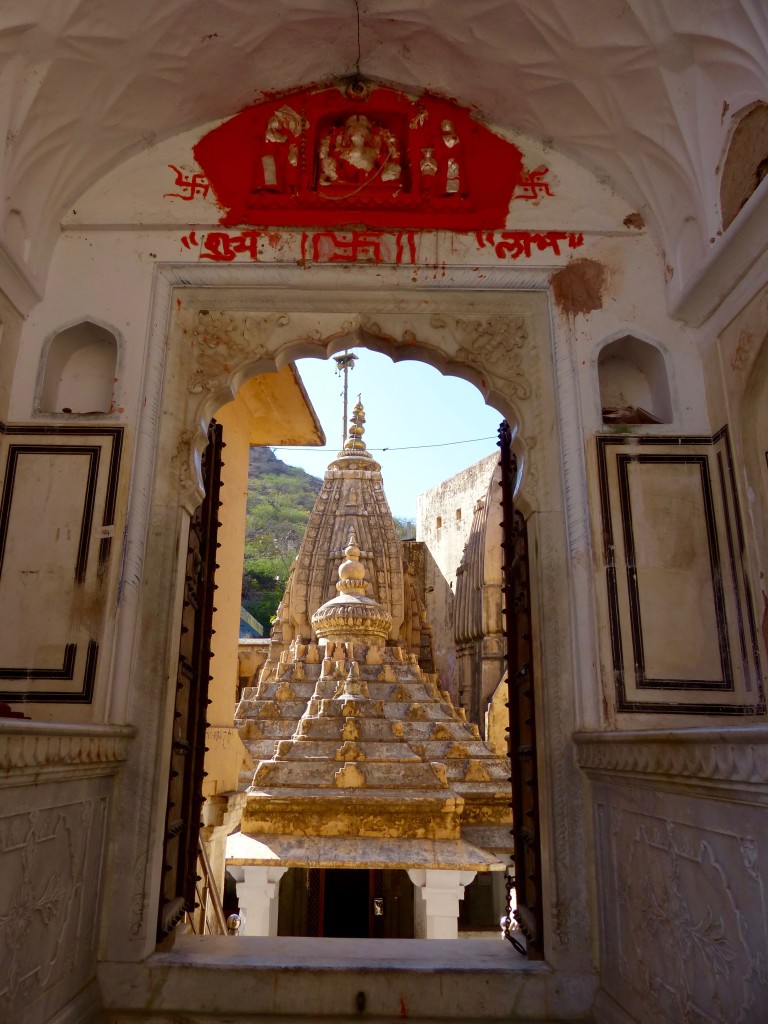
According to Vineet, monsoon rains sometimes overflow the stepwell, and the water fills the temple, which makes sense as it sits about 10 feet below street level. Legend says about 5,000 years ago a king had a cow that would only give milk in one specific place in the forest. Digging up the dirt in that spot, the king found a shivling – an idol of Lord Shiva, and decided to build this temple on the spot.
The shivling is inside the hole.
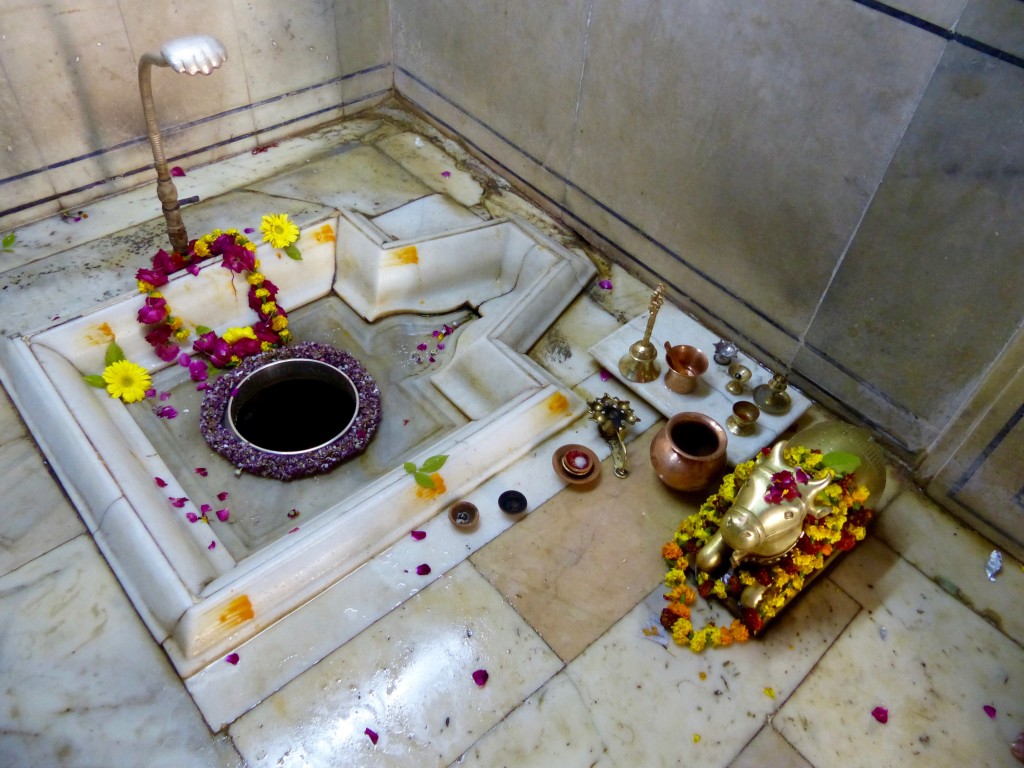
The Sri Jagat Siromani Temple was another highlight in Amer. It was commissioned by Queen Shringar Devi Kanakawat in memory of her son, Jagat Singh, and built between 1599 and 1608. Vineet found the caretaker, who opened the shrine for us.
While Sarah and I poked around the temple, Mona and Himanshu chatted with the caretaker. Apparently, he told them a story about the legendary 16th-century Krishna devotee and poet, Meera Bai, who considered Krishna her spiritual husband despite being married to a king. I found a summary on a website called Amerjaipur.in.
There is an interesting story about this temple. It is said that the statue of Lord Krishna in this temple is same statue that Meera Bai used to worship in the state of Mewar, 600 years ago. This statue was saved from destruction by rulers of Amer during the Mughal war with Mewar state and brought safely to Amer. And statue was set in a temple. Even statue of Meera Bai has been set along with Lord Krishna.
Vineet took us to the abandoned palace of the Kachchawa rulers, commonly known as the Narsinghji Temple, which was home to the royal family before they built the Amber Fort. The caretakers were hanging out, seemingly oblivious to the building’s historical importance.
Finally, we checked out one last temple, inside a peaceful courtyard. I have tried to find details about it online to no avail. If I stumble on any information, I’ll update this post.
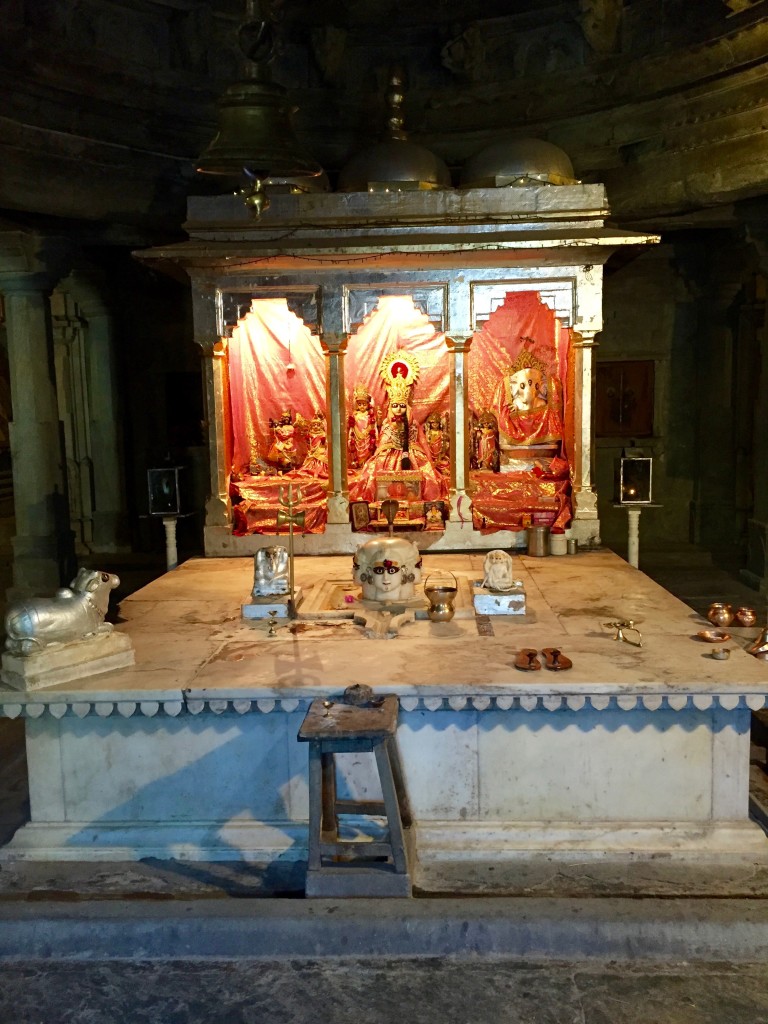
From the temple’s rooftop, we could see the wall that runs along the top of the Aravelli Hills, reminding me of our treks on the Great Wall of China.
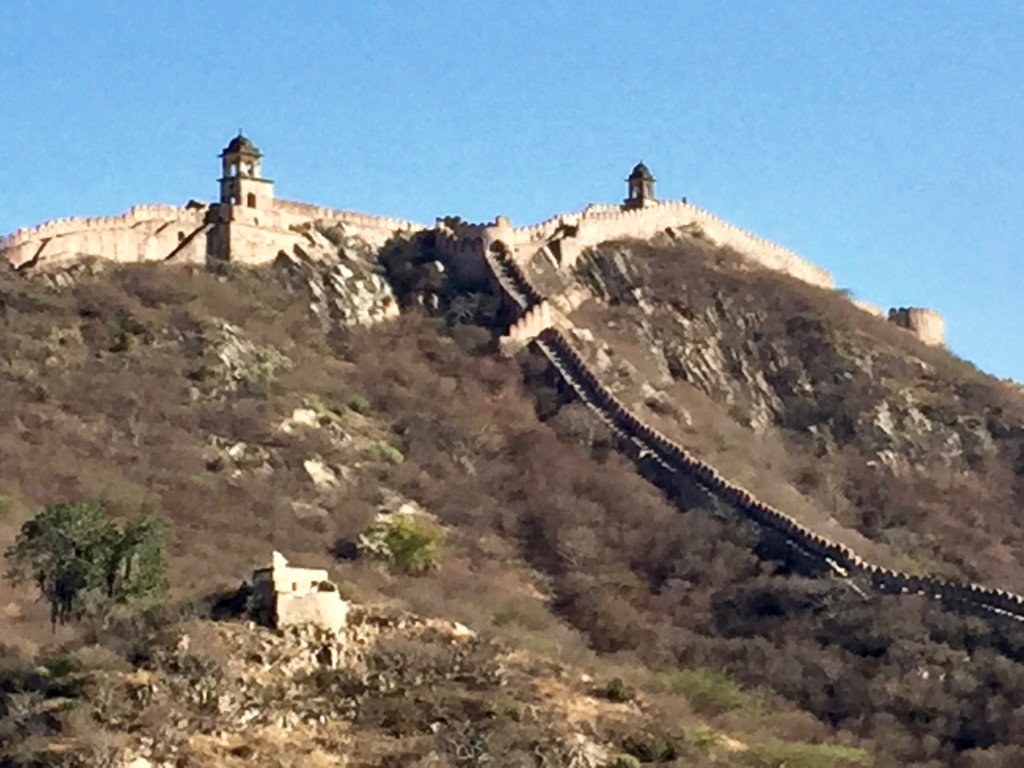
After bidding farewell to Vineet and Mona (who caught a flight back to Mumbai), Himanshu, Sarah and I returned to the car for our trip back to Delhi. However, the driver informed us that protestors in the neighboring state were blocking the border crossing. It’s a complicated situation, which gets more confusing with every article I read. You can read more here if you want, but I assure you, it raises more questions than answers.
So, suffice it to say, we weren’t sure we could get home. Well, the next day was my birthday and I was going to be cranky if I had to spend it in some roadside motel because the road back to Delhi was blocked. I quickly grabbed my phone to search for flights, but they were all booked. Train stations had also been ransacked by the protestors, so that eliminated another mode of transportation. Finally, we decided to drive for awhile and see whether we could get new information. The internet yielded nothing. No news. Himanshu got on the phone with him mother, who called everyone she knew who might have information. We stopped for chai, and Himanshu proposed an alternate plan. We could leave the highway and take country roads until we passed the blocked area. However, google maps was unreliable; it was pitch black outside; and we couldn’t be guaranteed that this new route was free of protestors. Feeling uneasy but eager to get home, we decided to risk it. Eventually, we got reassuring news from Himanshu’s brother that the road was clear. He had also been driving back to Delhi from another city and got there before we did.
I was able to spend my birthday back in Delhi after all. I took the day off work, sorted my Jaipur photos and relaxed. After that whirlwind weekend, I needed a break!
And, with that, I have officially wrapped up my Golden Triangle tour, five years after it started.
I highly recommend tours with Himanshu. In fact, he’s taking a group of us around Delhi next weekend to check out the street art. Check out his website, 1100 Walks. For a walking tour in Amer with Vineet, email him at jaipurwalks@yahoo.com.

